annotated directory of scanned telegraphic codes telegraphic codes, main jmcvey.net
An overhaul now (27 December 2023) in progress of this ancient page (last additions ca 2018), to bring it into conformity with other pages and with itself. Am addressing a considerable amount of link rot, as well.
This page is vestigial of earlier efforts to keep track of scans as they became available. Links to scans are correct, but probably do not point to all available scans of their respective titles; in particular, will want to add hathitrust scans. Also missing here (and in the main scans directory) are Japanese-language codes that have been digitized by the National Diet Library link (see also link). I will be getting to these in due course.
further :
This page is doubtless unwieldy, the addition of so many images can only cause a very slow page load. Entries may be further distributed on different pages.
The main scan directory — link — is the best place to start.
The codes described here, are those for which there are not other category pages, e.g., religious/missions, or cotton codes. Some of codes that are treated in those category pages are not available as scans, but descriptions and specimen pages are included.
Coverage is uneven: some codes are treated in detail, for others, only basic bibliographic information is provided. Mea culpa.
upper vertical bar ╹ at left returns to top of page; lower ╻ goes to main telegraphic codes and message practice page.
| The Secret Corresponding Vocabulary. adapted for use to Morse’s Electro-Magnetic Telegraph and also in conducting written correspondence, transmitted by the mails, or otherwise Francis O. J. Smith, comp. Portland: Thurston, Ilsley & Co., 1845 Harvard (Int 4210.81.5) copy (via google books) :
link 4 p. l., [230] p. 24 cm. |
A vocabulary of words (and their suffix etc variations), each having with a unique letter + number identifier. This is a kind of figure code that allows various permutations of those letter + number cyphers, in much the same way as Slater (1870). Some examples of how those permutations might be used are provided in the book’s “To the Reader” preface, and will be treated further below.
The Secret Corresponding Vocabulary is not oriented toward any particular trade or usage community (e.g., cotton, shipping); its vocabulary is strictly alphabetical. It is very different, thus, from (1) The Telegraph Dictionary and Seamen’s Signal Book that appeared in the same year, and which is structured like nautical signal books of the time; and (2) John Wills, his Electro-Magnetic Telegraph Vocabulary; or, Condensing Correspondent (1846), described here among other cotton codes : link.
The table below gives a sense of the vocabulary, and the number or words in each alphabetical section. It will be seen that many of the words would not likely be used in commercial (or even any) messages :
“...they are essential as references to disguise and render unmeaning the correspondence that is designed to be secret, to all persons but the parties interested, and for this end they have been retained.”
(from the preface)
| first vocabulary entries (starting at 1) | final vocabulary entries (through) | A | B | ||
| A | Aaronic, ronical – Abaciscus – Abacist – Aback | . . . | Azotic – Azotite – Azure – Azured – Azurestone | 3750 | — |
| B | Baa – Baal – Babble – Babbled | . . . | Bystroke – Byturning – Byway – Byword | 2444 | 2500 |
| C | Cab – Cabing – Cabal – Cabalist | . . . | Cystotomy – Czar – Czarish – Czaromitz | 5544 | 5600 |
| D | Dab – Dabble – Dabbled – Dabbling | . . . | Dyspepsy – Dyspeptic – Dysphony – Dysphoria | 3724 | 3750 |
| E | Each – Eager – Eagerly – Eagerness – Eagle | . . . | Eyewink – Eyewitness – Eyeing — Eyot – Eyry | 2771 | 2850 |
| F | Fable – Fabled – Fabler – Fabling – Fabric | . . . | Futurity – Fuzz – Fuzzball – Fuzzle — Fy | 2673 | 2750 |
| G | Gab – Gabardine – Gabble – Gabbler – Gabbling | . . . | Gyration – Gyratory – Gyre – Gyred – Gyring | 1648 | 1750 |
| H | Ha – Haberdasher – Haberdashery – Habiliment | . . . | Hypothetical, al – Hyson – Hysteric, al – Hysteria | 1917 | 2000 |
| I | Iambic – Iambics – Ibidem – Ice – Iceberg | . . . | Ivory – Ivory black – Ivy – Ivyed – Ivymantled | 3681 | 3750 |
| J | Jabber – Jabberer – Jabbering – Jacamar – Jacinth | . . . | Juvenileness, ity – Juxtaposited – Juxtaposition | 421 | 500 |
| K | Kale – Kaleidoscope – Kalendar – Kalenderer | . . . | Knurled – Knurly – Koran – Kreasote – Kremlin | 244 | 250 |
| L | La – Labefaction – Label – Labeled – Labeling – Labent | . . . | Lyre – Lyre shaped – Lyric, al – Lyricism – Lyricist | 1578 | 1650 |
| M | Macadamize – Macadamized – Macadamizing | . . . | Mythologist – Mythologize – Mythology | 2631 | 2750 |
| N | Nab – Nabbed – Nabbing – Nabon – Nadir | . . . | Nymphish – Nymphlike, ly – Nymphomany | 864 | 1000 |
| O | Oak – Oakapple – Oaken – Oakenpin | . . . | Oyster wench – Oysterwife, woman – Ozena | 1442 | 1500 |
| P | Pabular – Pabulation – Pabulum – Pabulous | . . . | Pythagorize – Pythian – Python – Pythoness | 4076 | 5000 |
| Q | Quack – Quackery – Quackish – Quackle | . . . | Quoth – Quotidian – Quotient – Quo warranto | 341 | 400 |
| R | Rabbet – Rabbeted – Rabbeting – Rabbet plane | . . . | Ruthlessness – Ryal – Rye – Ryegrass | 3000 | — |
| S | Sabbath breaker – Sabbath breaking – Sabbatic, al | . . . | System monger – Systyle – Sythe – Sythed | 5395 | 5450 |
| T | Tabernacular – Tabitude * – Tablature – Table | . . . | Tyranny – Tyrant – Tyro – Thythe – Tything | 1988 | 2000 |
| U | Ubiquitous – Ubiquity – Udder – Uddered | . . . | Uveous – Uvula – Uxorious – Uxorly – Uxorness | 3107 | 3200 |
| V | Vacancy – Vacant – Vacate – Vacated – Vacating | . . . | Vulturine – Vulturish – Vulturous – Vying | 733 | 750 |
| W | Wabble – Wad, y – Waded – Wading – Waddle | . . . | Wrung – Wry – Wryneck – Wrynecked – Wryness | 1228 | 1250 |
| X | Xanthid – Xanthogen – Xebec – Xenodochy | . . . | Xylography – Xylophagous – Xylopyrography – Xyster | 14 | 50 |
| Y | Yacht – Yager – Yahoo – Yam – Yamboo | . . . | Youth – Youthful – Youthfully – Youthfulness – Yule | 91 | 100 |
| Z | Zaccho – Zaffer – Zany – Zaphara – Zeal | . . . | Zymic acid – Zumic acid – Zymomic (?) – Zimome (?) | 67 | 100 |
| ciphers with vocabulary (at left); total ciphers (with and without vocabulary, at right) | 55372 | 56900 | |||
| total unassigned ciphers (“blanks”) : B minus A | 1528 | ||||
 |
⬅ first Vocabulary page Secret Corresponding Vocabulary (1845) |
In the preface are found examples of how secret correspondence might be done, involving pre-arranged transpositions of letters and figures. A summary of those examples follows :
- ...agree previously, that in all their communications from the former to the latter, the number 9 (nine) shall be deducted; and in all from the latter to the former, the number 15 (fifteen) shall be added. Instead of sending their communications in words, they send numbers only, or partly in numbers, and partly in words.
- ...instead of confining the pre-agreements of the parties, to the deduction or addition of one number only, let one number be agreed on, for every alternate word sent in figures, and another number for every other word; or, by the same rule, let several numbers be used for addition or deduction, in any order that might be agreed on.
- ...another mode of adding to the intricacy... is, for parties to agree on prefixing to the numbers sent, certain substituted letters for the ones designed — as prefixing e, where a is to be understood, i where o is to be understood, and so on...
Finally, provision is made where the addition or subtraction of numbers (as described above) might not work (given the number of cyphers available under each alphabetical head) —
“the rule is to be reversed, that is, addition in such case is to take the place of subtration, and vice versa”
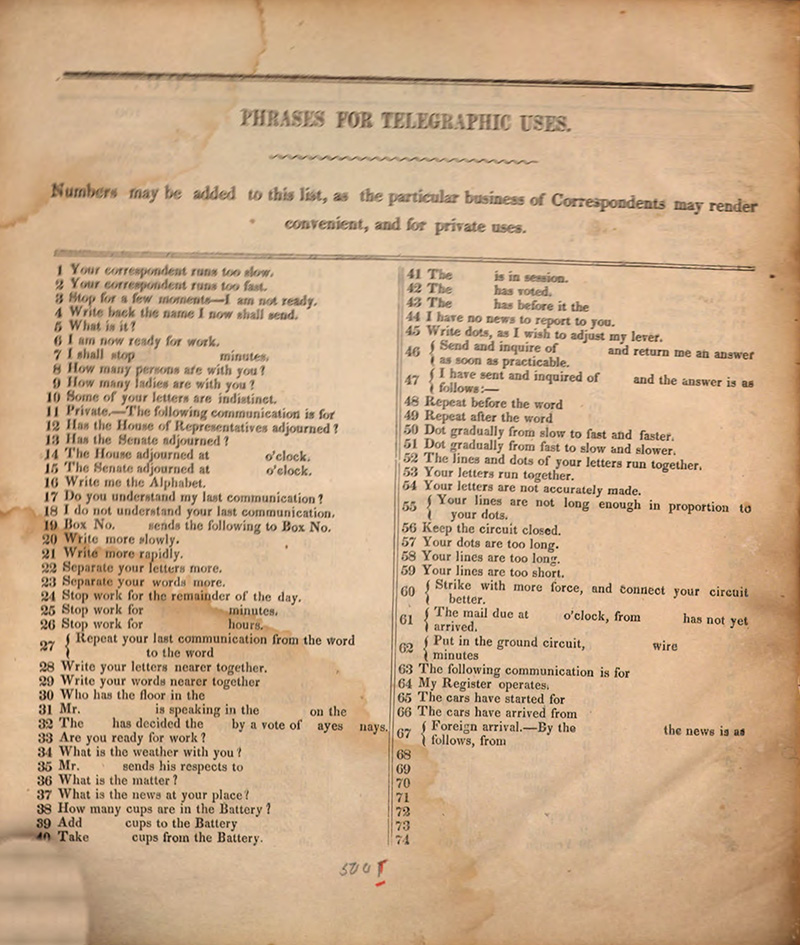 |
⬅ last page, showing the only phrases in the code, all regarding telegraph messaging Secret Corresponding Vocabulary (1845) |
Francis O. J. Smith (1806-1876)
wikipedia : link
| The Telegraph Dictionary and Seamen’s Signal Book. adapted to signals by flags or other semaphores; and arranged for secret correspondence through Morse’s Electro-Magnetic Telegraph: for the use of commanders of vessels, merchants, &c. by Henry J. Rogers Baltimore: Published by F. Lucas, Jr. 170 Market Street. 1845 Harvard University : Nav 573.45.3 (via google books) : link description :
Dedication, 3; Testimonial from Professor Morse, 4; Introduction and Instructions, 5; Compass Signals, 9; Time Signals, 10; Fractions, 13; Word and Sentences, 14; Auxiliary Verbs, viz: I am, He is, We are, &c. &c., 250; Blanks for Merchants, &. &., 258; Ports and Places—In local order, 261; List of States and their Principal Towns, 269; List of Nations, 279; General Gazetteer of Ports and Places Alphabetically Arranged, 280; List of Vessels in the U.S. Navy, 295; List of Revenue Marine, 297; Principal Canals in the U.S., 299; Principal Rail Roads in the U.S., 301; Articles of Merchandise, 303; Seamen’s Wages, 322; Exchange, 323; List of Country Banks in the U.S., 324. |
As indicated above, the most copious single section is for “Words and Sentences,” pages 14-249. The pages shown below are selected for their phrases devoted to cotton. Over time, codes entirely devoted to cotton would appear; these would not include phrases about convoys.
 |
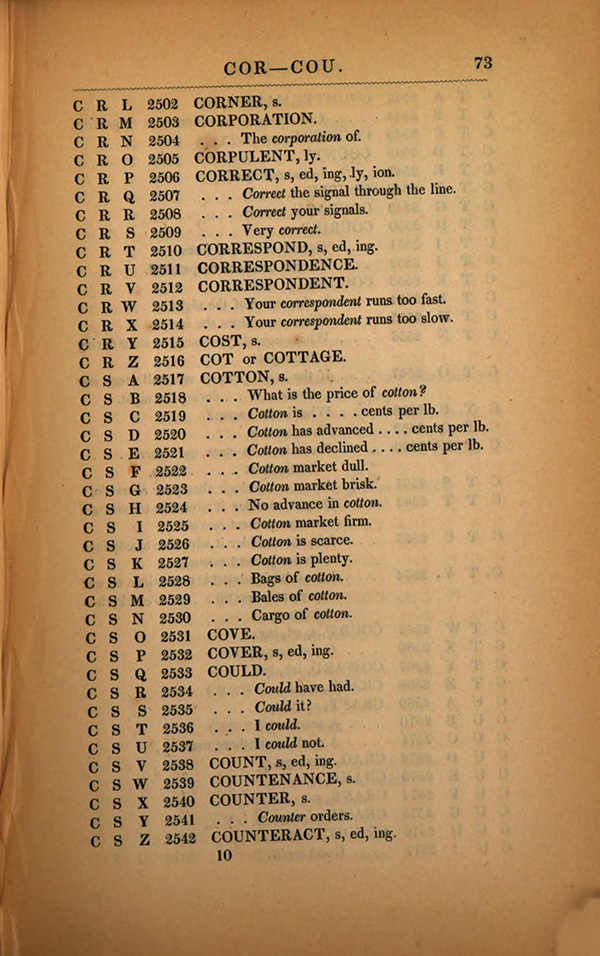 |
⬆
facing pages 72-73, The Telegraph Dictionary and Seamen’s Signal Book (1845) : link
The instructions discuss usage of “Rogers and Black’s American Semaphore.” The whole numbers 13,395 signals (AB 11 > SUS 13,405). The figure code works with the American Semaphore System (and works with a “key” for making messages secret — a number to be added to or subtracted from the figure conveyed); the letter code (e.g., AB, SUS) works with a flag system. Two flags suffice between AB (11) and ZZ (698), but with the exception of “compass signals,” “time signals,” and “fractions,” the two-flag signals are reserved for no special categories of message (e.g., “you are standing into danger” as we might find in nautical codes.
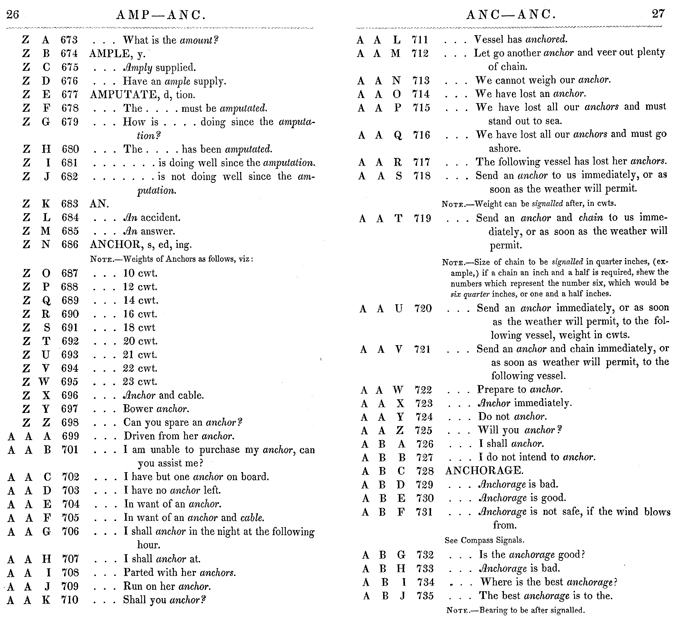
⬆
pages 26-27 (cropped), at shift from two to three flags, ex The Telegraph Dictionary and Seamen’s Signal Book (1845) : link
The phrase vocabulary looks forward to the range we might find in the ABC Telegraphic Codes of three decades later.
![]()
Henry J. Rogers (1811-1879)
- papers at the Smithsonian : link
- entry at Appletons’ cyclopædia of American biography, Vol. 5 (1888) : 304-305 : link (hathitrust)
| The floral telegraph; or Affection’s signals, by the Late Captain Marryatt. Cornell U copy/scan, via hathitrust : link xv, 324 p. : col. ill. ; 16 cm. frontispiece, title, preface, dedication : i-xi It is not certain that this book is indeed by Frederick Marryat [one “t”] (1792-1848). |
The Floral Telegraph’s code is structured much like a standard signal code; I realize belatedly that its “three figure” aspect shares that feature with later three-letter telegraphic codes.
The vocabulary us “divided into, Part I, Part II, and Part III; that it might not be necessary to raise the numbers affixed to the words above three figures.” (p140) :
Vocabulary, Part I, “One knot to be tied on the string between each number [i.e., flower].”
Vocabulary, Part II, “Two knots to be tied before each number.”
Vocabulary, Part III, “Three knots to be tied before each number.”
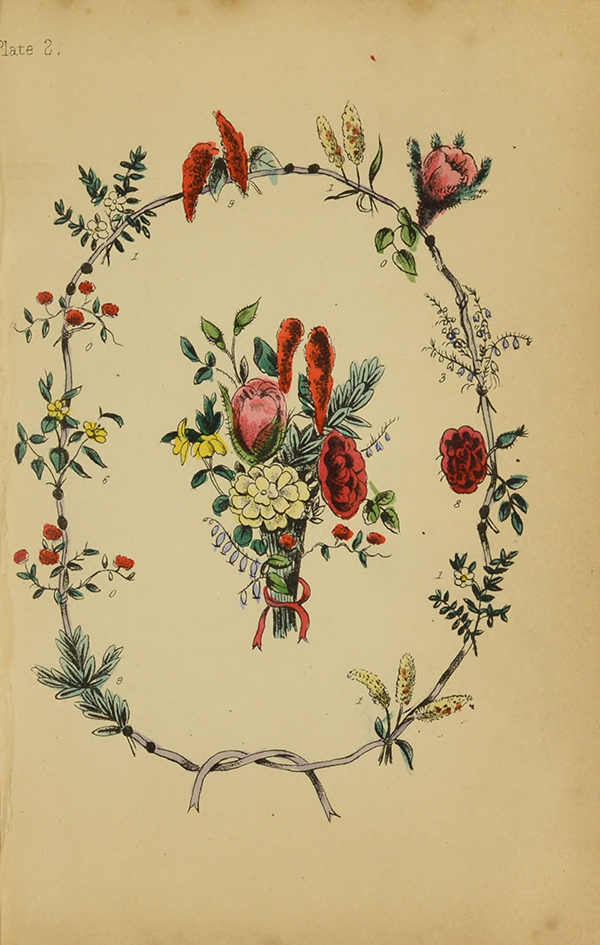 |
⬅ Plate II, from Explanation of the Plates (pp xiii-xv) — The centre groupe represents the Flowers tied together as a Bouquet; the surrounding circle as untied and laid open. The Flowers are of the Summer season. [moving clockwise, from lower left] The first two knots indicate that the Vocabulary Part II. is about to be employed. The Bay represents Figure 9, Vide p. 139. The Verbena ditto Figure 0, ditto 139. Together, 90, the No. appropriated to the words “To-morrow” in the Vocabulary, Part II. The two knots then repeated indicate that the Vocabulary Part II. is still employed. The two knots then again repeated indicate as before. The two knots then again repeated indicate as before A single knot is then used indicating that the Vocabulary Part 1. is now employed. Two knots are then again used, indicating as before. The entire sentence then reads thus: |
 |
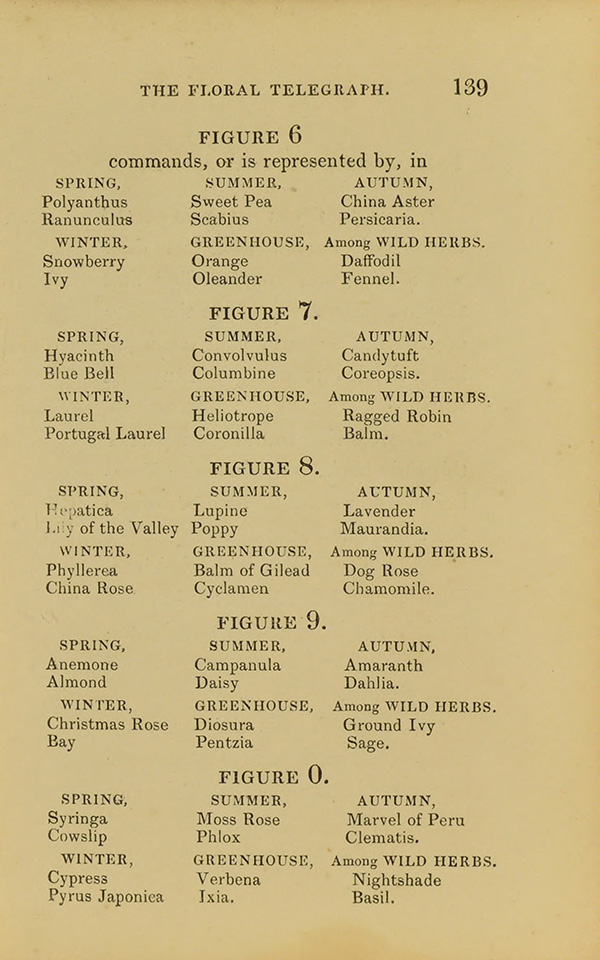 |
⬆
the basic flower signals (including their seasonal variations and artistic options), for Figures 1-2-3-4-5-6-7-8-9-0.
A more recent (20230204) employ of this code is at asfaltics :
“Tie your bouquet more accurately.”
link
same at 2406
see Daniel Wuebben, “Captain Frederick Marryat and the Floral Telegraph; Or, a Forgotten Coder and his Floral Code,” Victorian Literature and Culture 42:2 (June 2014) : 209-233 : link (no access); link (readable, at least)
| The Brachial Telegraph.. An original method of conversing and signalizing on land and at sea, by means of human arms, at any and all distances, even within furthest range of the telescope. Robert W. Jenks, comp. New York: Henry Sanders, 1852 Cornell University, VK389 J53 : Introduction pp 3-7; Signal Alphabet pp 8-11; “Written Alphabet of the Brachial Telegraph, Capitals and Small Letters” pp 12-14; “Written Numerals” p 13; Signal Numbers 16-19; Sea Signals 20-26 (similar to two-flag signals of other nautical codes, for quick messaging); Resources in Case of Shipwreck 27-30 (on building a raft, getting a line to shore, etc.); Military Signals 31-37 (phrases); Miscellaneous Signals 38-56; Recommendations 57 (testimonials of Harvey P Peet, President of the New-York Institute for the Instruction of the Deaf and Dumb), and D. C. Van Norman (Principal of Rutgers Female Institute)). The sea signals are made with an object (e.g., a trumpet) in the signaller’s hand; military signals are made with a sword. |
The introduction discusses the ancients, Chappe, the electro-magnetic telegraph and naval signals, then asserts that “subsidiary assistance” might be derived from the Brachial Telegraph, for which he gives examples. He adds: “In schools and private families, independently of the utility claimed for it as a branch of study, it would be a source of amusement to young persons, as well as a healthy exercise of the limbs, tending to a robust development and a graceful carriage of person.” (p7)
The written alphabet follows the (arm) signal alphabet closely —

The chapter “Miscellaneous Phrases” is the longest in the book, with 88 signal/phrase pairs in all. The examples below are taken from pages 39, 40 and 57.

Each of the 88 signals for “Miscellaneous Phrases” might be assigned additional meanings, provided they are distinguished in some way from their ordinary sense. The inflection might be done by “hold(ing) something in the hand, as a book, or hat, or stick.”
The brachial telegraph signals recall the signals of the Chappe system, but their respective forms are less emphatically pronounced than the latter. (Perhaps signallers would need to have unusually long arms?) I have not worked out the maximum number of signs available using the arms — is it 88? — but observe that many of the gestures, particularly where an arm crosses the front of the signaller’s body, would be indistinguishable at a distance.
The brachial telegraph is also proposed as potentially useful, in emergencies, to Deaf Mutes: see a communication by John R. Burnet, in The Proceedings of the Third Convention of American Instructors of the Deaf and Dumb (Columbus, Ohio, August 10-12, 1853) (pp196-97), here
The introduction to the “Miscellaneous Signals” concludes with this —
“These miscellaneous signals, with the new meanings that may be attached to them, would make an agreeable pastime for social parties, as the new meanings might be extended without limit, the only prerequisite being a previous agreement as to the new interpretation.”
“Innocent and exciting amusement in the social circle” is also suggested as a “secondary purpose” for Baldwin’s Traveler’s vade mecum (1853) — listed immediately below (and more fully described here). (A. C. Baldwin was present at the second Convention of American Instructors of the Deaf and Dumb, held in Hartford, Connecticut in August 1851.)
| Diccionario telegrafico Mexico, Imprenta Imperial, 1866 NYPL copy/scan (via google books) : link Figures, times, alphabet (1ff); vocabulary (13ff); names of places (135ff); authorities (175ff). No phrases This code provides the Spanish-language terms, but no codewords or figure constructs for those. For my own convenience, I provide the preface and a rough Englishing of same, below. |
ADVERTENCIA.
El Diccionario telegráfico contiene las palabras mas usadas para la correspondencia secreta ; las que faltan, sean nombres de poca importancia ó nombres propios, pueden ser escritas con letras, ó se compondrán por medio del alfabeto (página 5 – 11).
Los verbos auxiliares “haber,” “ser” y “estar,” y los verbos “tener,” “poder,” “ir,” “querer” y “deber,” están puestos en los tiempos que indican el presente, pasado y venidero. De los otros verbos solo se halla el infinitivo, que basta para expresar en combinacion con verbos auxiliares ó los arriba mencionados, para comunicar las ideas de una manera inteligible. Se comprenderá fácilmente por el sentido de la frase, si el infinitivo aislado de un verbo indica el presente ó el venidero, ó un participio usado como adjetivo; compuesto con los auxiliares el pasado ú otro tiempo, estará perfectamente precisado. El gerundio siempre puede ser sustituido reduciendo las frases á las expresiones mas sencillas, y por medio de la combinacion de “estar” con el infinitivo del verbo respectivo.
Se ha agregado al fin del Diccionario un vocabulario, que contiene los Soberanos, dignatarios y personajes importantes, y otro vocabulario geográfico del Imperio y del Extrangero.
Para no aumentar el námero de las cifras á mas de millares, se ha dado á aquellas palabras una sárie de cifras ya contenida en el Diccionario. Se distinguirá una série de otra, subrayando la del apéndice.
EJEMPLOS.
Ha llegado S. M. el Emperador á Puebla.
Un tal Goldsmith, individuo sospechoso de ser agente de Santa-Anna etc. etc.
S. M. concede el indulto pedido, avise V. al Prefecto Político.
Se hallan tambien en el Diccionario las sílabas necesarias para composiciones.
Which, drawn through the Google translation machine, and subjected to amateur tuning, yields something like :
The Telegraph Dictionary contains the words most used for secret correspondence; what is missing — terms of little importance or proper names — can be written in letters, or “spelled out” (page 5-11).
The auxiliary verbs “be,” “was” and “will be,” and the verbs “have,” “may,” “go,” “intend” and “duty,” indicate present, past and future. Of other verbs, the infinitive alone is sufficient in combination with auxiliary verbs or those mentioned above, to communicate ideas in an intelligible manner. Be easily understood by the meaning of the sentence, if the isolation of a verb infinitive indicates the present or the future, or a participle used as adjective, compound with auxiliaries or other last time, will be fully clarified. The gerund can always be replaced to reduce the sentences to the simplest expressions, and with combination of “being” with the infinitive of the verb concerned.
There is added at the end of Dictionary a vocabulary for the Sovereign, officials and important persons, and a geographical vocabulary for locations within and outside the Empire.
In order not to increase the number of the figures to more than thousands, have been given to those words and a series of figures contained in the Dictionary. Distinguish a series of other, stressing the appendix.
Examples
S. has come M. Emperor to Puebla.
One such Goldsmith, individual suspected of being an agent of Santa-Anna, &., &.
S. M. granted a pardon request, contact V. the Political Prefect.
They are also in the Dictionary of syllables needed to compositions.
| Bolton’s Patent Code for transmitting messages by the electric or magnetic telegraph. Francis John Bolton, Chatham, Captain in Her Majesty’s 12th Regiment of Foot. Inventor and Proprietor. London: Printed by Harrison and Sons, St. Martin’s Lane. 1868 Bodleian copy (via google books) : link volume appears to be incomplete, and was perhaps intended to secure patent priority for Bolton’s Telegraph Code (1871), described further below. |
Bolton’s Patent Code contains 44 printed pages (including title page), its final phrase being “Leeward” (01450). A quick survey: title page; “Symbols for Code;” “Special Sentences” 0 / Accept freight through 99 /Sunday; followed by a longer phrase vocabulary, 000 / Call signal/ to be sent at beginning of message, through 99 / blank; A “spelling” vocabulary 100 / A through 859 / Zz;
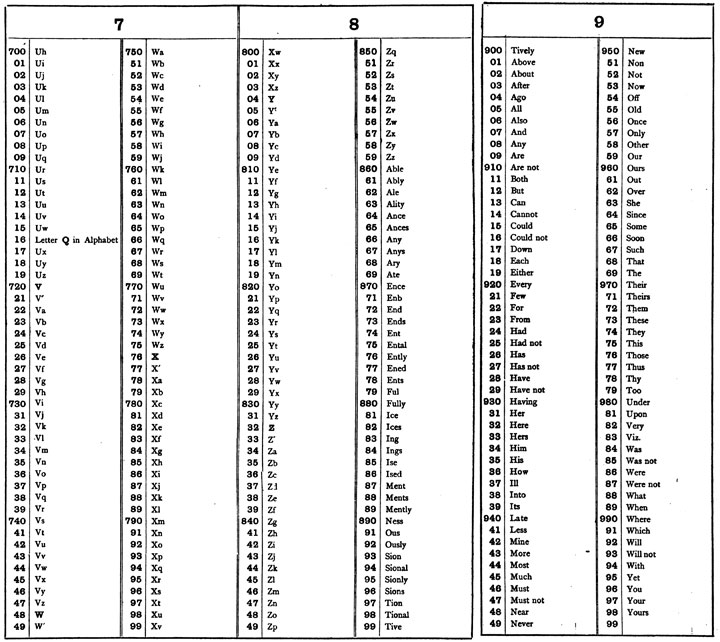
⬆
detail, from Google scans of pages containing 700-800, and 900, Bolton’s Patent Code (1868)
a continuation of the spelling vocabulary, this with larger components 860 / Able through 998 / Yours, 999 / blank; and a four- (transitioning to five-) figure phrase vocabulary 0000 / Abundant through 01499 / blank.
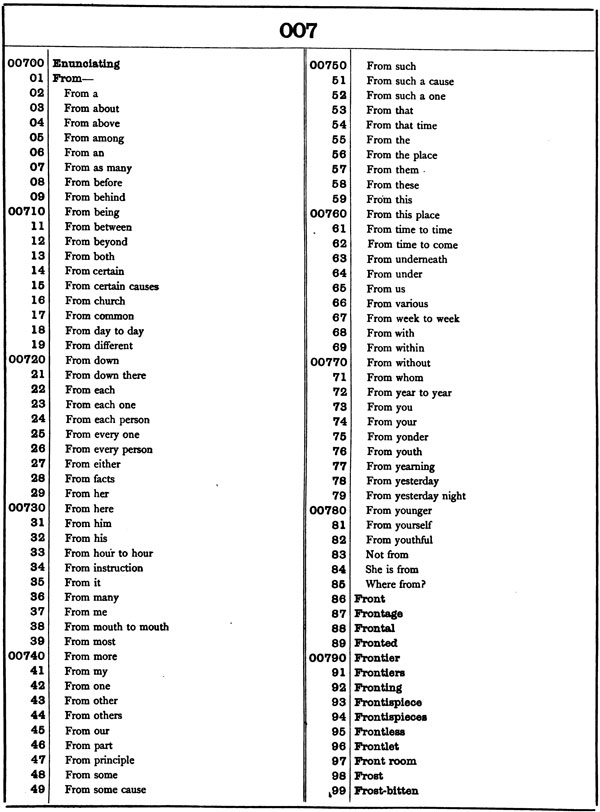
⬆
detail, from Google scan of “page” 007, Bolton’s Patent Code (1868)
In Bolton’s system, sentence parts are presented in essentially the same way as are “spelling” components — pieces for the assembly of “verbatim”-like messages. As projected here — covering both commercial and social topics — his dictionary would be enormous. It contains, for example, 257 phrases with the word home, e.g., 01057 / Home late of a night, 01058 / Home late of an evening, 01063 / Home to-night, 01064 / Is from home, etc. No practical code would be compiled with so encyclopaedic a compass, and so poetic some of its selections.
Yet Bolton was serious about the undertaking; he was involved in the laying of the Atlantic Cable in 1866, and his 1871 code (described below) contains several testimonials, including one from William Thomson, Cyrus W. Field and C. F. Varley.
This is an early cable code, compiled by someone with a background in military signal codes, hence a division into sections, rather than a single phrase vocabulary. Bolton — “aided by some of the best minds of England and a large staff of clerks” * — boldly sought to handle both aspects of telegraphic communication: (1) code; and (2) and arrangement of phrases. That’s a tremendous ambition. This code fails to address the realities of signaling via submarine cable, above all to the induction effects on the signals themselves, and the consequent importance of packing sufficient redundancy into the code words. His phrase vocabulary is wanting, too: it comes across as a demonstration, rather than a carefully weighed offering of likely phrases. It was around the time of the publication of his second (1871) code that his attentions turned to the Society of Telegraph Engineers and Electricians (that he was “instrumental” in founding, and to his new duties as water examiner in London. Numerous codes would appear in these early years, all of them indebted (at least in spirit) to his own efforts.
* “The New Telegraphic Code,” Chicago Tribune (December 28, 1870)
An abstract of this code can be found in US Patent No. 58,562 “Improvement in Signal-Codes for Electric Telegraphs” (October 2, 1866), which appears (on basis of the Patent Office abridgement) to be equivalent to GB Patent No. 1646 “Improvements in the mode of transmitting messages by the electric or magnetic telegraph” (June 19, 1866).
Bolton’s Patent Code might have been kind of “stake” for a later patent — or copyright — claim. In any event, it was followed in 1871 by a second code, larger but arranged on the lines laid down here, entitled Bolton’s Telegraph Code. Here, Bolton is “Major Frank Bolton.” I examined the BL copy; no scan is available, to my knowledge. A short description follows.
![]()
1871 Bolton’s Telegraph Code
A Telegraphic Dictionary of the English Language, Forming a complete Code for the transmission of Telegraphic and Postal Card Messages on every subject; adapted to every branch of business, and suited for use in any language, by the employment of which Economy, Accuracy, and Secrecy are secured.
London: Longmans, Green, Reader & Dyer
British Library (shelfmark 1804.a.21) : permalink
On the phrase side, Bolton’s Telegraph Code code is divided into four parts.
- The Special Code provides for 510 Words and Sentences of a special nature, principally intended for Commercial Telegrams;
- The Spelling Code, provides for 8,000 Signals expressed by Figures, and forms a Spelling Code, by which any word in any language, written in Roman characters, can be spelt and transmitted;
- The Private Code, provides for 8,000 Sentences in blank, for the Owners of the Code Books to fill up with any particular forms of Messages best suited to the special requirements of their business; and
- The General Code, provides for 100,000 Signals, and expresses nearly every word in the English language, alphabetically arranged, and numerous Sentences of frequently-ocurring combination (mostly selected from Telegraphic Messages), and also the names of most of the principal paces in the world.
These four parts are vestigial of signal codes, with their two-, three- and four-flag vocabularies.
On the code/symbol side, Bolton overlays on these four vocabularies, three different methods of expressing each: (1) code words; (2) code letters (1L through 4L); and (3) a figure code (pointing to page and line on page, 00-99). The three methods are described in the “Instructions” thus:
- “Word Code,” by which common words, and pre-arranged sentences, are expressed by one type word, which type words have been selected from the best English Dictionaries, Directories and Gazetteers.
- “Letter Code,” by which the same words and sentences are expressed by groups of letters, which never exceed 4 in number, and which have been selected in such a manner as in no case to form a word.
- “Number Code,” which equally expresses the above-mentioned words and sentences, by the application of the ten numerals, on a system of page and line, forming the Code Signal.
Bolton had initially intended to make the whole a figure code — indeed, this is precisely what his 1868 Patent Code is. Here though, in the 1871 code, Bolton provides three methods of coding, to ensure that his code will satisfy different/evolving requirements by the telegraph administrations: The British Post Office authorities now required that figures be written and charged as words.
Bolton is convinced of the superiority of a code system of figures, as it is “the best adapted for fulfilling the general requirements of codification, being at once the simplest, the most expeditious, the most accurate, the most free from incidental errors of context and association, and possing the incalculable advantage of applicability to every language containing numerals,” even Chinese, he notes in his Preface to the 1871 code. But the realities of administrative needs, including the need to protect messages against mutilation in cable transmission, would complicate things. The great solution, of course, would be condensers able to convert 10-, 12- and even 13- figures into pronounceable five and ten-letter codewords.
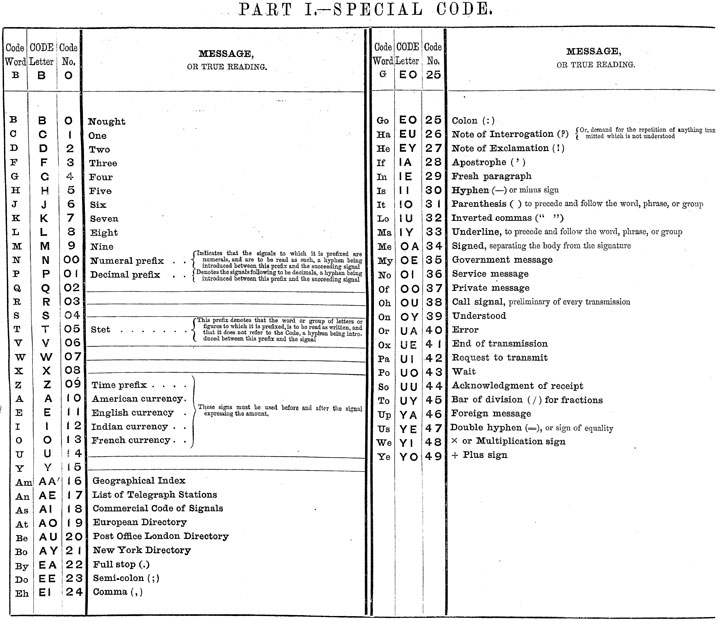
⬆
detail, from photocopy of BL copy, Bolton’s Telegraph Code (1871)
The above shows the first 49 of 510 special terms, this first group including indicator terms, e.g., to indicate that following codewords are to be read as figures or decimals, etc.
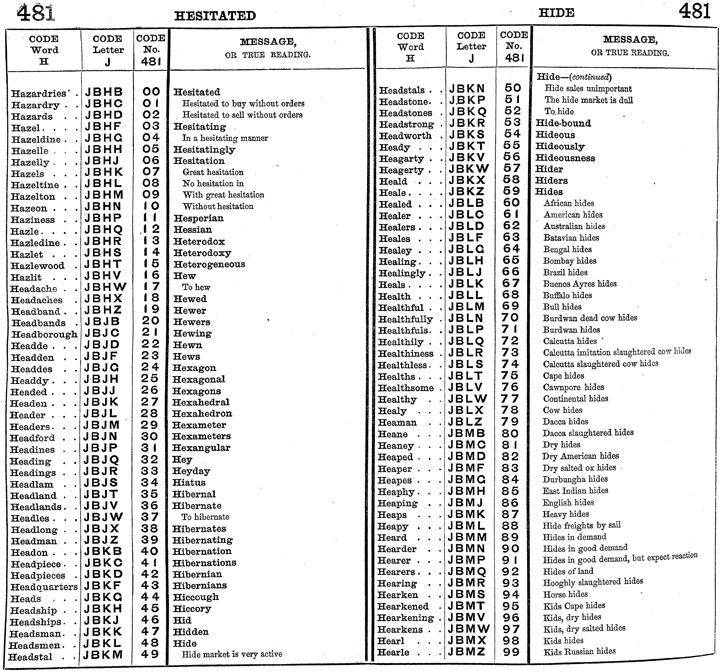
⬆
detail, p81, selected at random from Part 4 the “General” code vocabulary
from photocopy of BL copy, Bolton’s Telegraph Code (1871)
Bolton’s Telegraph Code also includes a section “Instructions for the use of cypher” (pages xx-xxiii). Here, he provides the common device of counting a certain number of places forward or backward for any entry, when coding or decoding. Following discussion of a number of variations in this area, he suggests the use of a “Cryptograph, or Cypher Wheel,” involving the use of a keyword.
Francis John Bolton (1830-1887) —
Bolton is described in the DNB as an army officer and electrical engineer. His army service included artillery and development of system of visual (with P.H. Colomb) and night signalling. He was an instructor in visual signaling at the School of Military Engineering, Chatham. He was a co-founder of the Society of Telegraph Engineers and Electricians and, as its secretary, edited that society’s journal. In 1871, Bolton was appointed Water Examiner to the city of London; he earned some fame for conceiving, designing (and even operating) colored fountains and electric illuminations at South Kensington associated with the International Health Exhibition of 1884.
In addition to his Patent and Telegraph codes, Bolton authored London Water Supply (London, 1884, here).
Obituaries can be found in The Telegraphic Journal and Electrical Review (January 14, 1887) link, and in the Minutes of the Proeedings : link.
Bolton also is included in the Dictionary of National Biography (Supplement, 1901, here).
I regret photocopying the entirety of the preface and instructions in the 1871 code, but only a few pages of the code itself.
| Telegraph Code, to Ensure Secresy in the Transmission of Telegrams by Robert Slater, Secretary of the Socièté du Cable Transatlantique Français, Limited. London: W. R. Gray, 1870 Bodleian (232.g.113) copy (via google books) : link (20231122) also, see page (much neglected) devoted to figure codes : link introduction pp iii-vi
examples pp vii-xvi The vocabulary is not specialist in any way, let alone classified. Probably best used in conjunction with specialized code, whose codewords aren’t numbered. |
The code was developed solely for secrecy: all its ciphers depend on prearranged numbers or rules for addition, subtraction, transposition, alteration of series, or other (progressively) complex operations. Its examples 1–9 (pp vii – xv) are a delightful display of patter/nonsense literature, each a variation of the sentence —
The Queen is the supreme power in the Realm:
- Bounteous wedge purifying bounteous biography transparent posed bounteous yoke
(addition of 5555 to each word’s vocabulary number) - Plenty judging diatribe plenty perspective inciter crispate plenty lagoon
(subtraction of 5555 from each word’s vocabulary number) - Talking remonstrated kinks talking starch promised imparted talking quote
(transposition of last three figures for each transmitted word, e.g., 12345 becomes 12453) - Blundered waft presage blundered basalt tadpole pneumonia blundered why
(add 5555, and transpose three right hand figures) - Pillaging jackass darn pillaging posing hulk cousin pillaging ketch
(subtract 5555, and transpose three right hand figures) - Begged bulging freak catamaran beneath bedstead build corrupting claimed beneath autumn few
(five-figure series transmitted in series of four figures) - Blends celestially fivefold brigade bays Brazilian catalogue conjecturing come bays Areopagus few
(series of five figures converted to series of four, the three right-hand figures being transposed) - Beneath celibate fixedness brigandine beaconage breadth catch conjugation comfort beaker argument fiddler
(series of five figures converted to series of four, and transposed by adding 1 to the first result, 2 to the second, 3 to the third, etc.) - Argentine decay antispasmodic conclude beaconage anomalous constitutional dissenter caffre ascribable anneal cupping
(results from using method described in ex 8, by transposing the order of words in the message itself)
| Dianxin xinfa 電信新法. S. A. Viguier, revised by De Mingzai 德明在 on the basis of Viguier’s 1871 code. Published in Tongzhi xinwei (1871). copy/scan source(s) : link (20231122) original at Det Kongelige Bibliotek, Oriental and Judaica Collections (Copenhagen) Opens at page “97,” near end of book, showing codes for alphabetical letters A through Z (7961 through 7986), and figures 1 through 0 (7991 through 8000). |
See pages 98 and 99 for “The Great Northern Telegraph / China and Japan Extension Company.” Page 99 provides information in four-figure codes, and page 98 provides (same? but quick/cursory check suggests not) information in Chinese characters. See also pages 8 and 9 for English-language preface by C. M. Têh, written in “Paris, November, 1871.”
Something on Chinese telegraph code at wikipedia : link
Jim Reeds on CTC : link (2004)
| Dianbao xinshu 電報新書. sub, etc “New numbercode for the telegraph in Chinese made by S. A. Viguier in 1871 based on the first invented code made by the Dane H.C.F.C Schjellerup from 1871.” No internal reference (in English, anyway) to the Great Northern Telegraph Company. copy/scan source(s) : link (20231122)
|
Opens to front (Chinese) cover.
Like the preceding (1871) publication, characters arranged by radicals; differs from that edition by presenting figures in Chinese characters; and (apparently, need to confirm) provides a means for secret ciphering.
| Bloomer’s Commercial Cryptograph A Telegraph Code and Double Index—Holocryptic Cipher. J. G. Bloomer. San Francisco: A. Roman & Co., 1874 Stanford copy/scan (via google books) : link “By the use of this work, Business Communications of whatever nature may be telegraphed with Secrecy and Economy.” 231 printed pages; same in all respects (I believe) except design of title page, and wording of the title. |
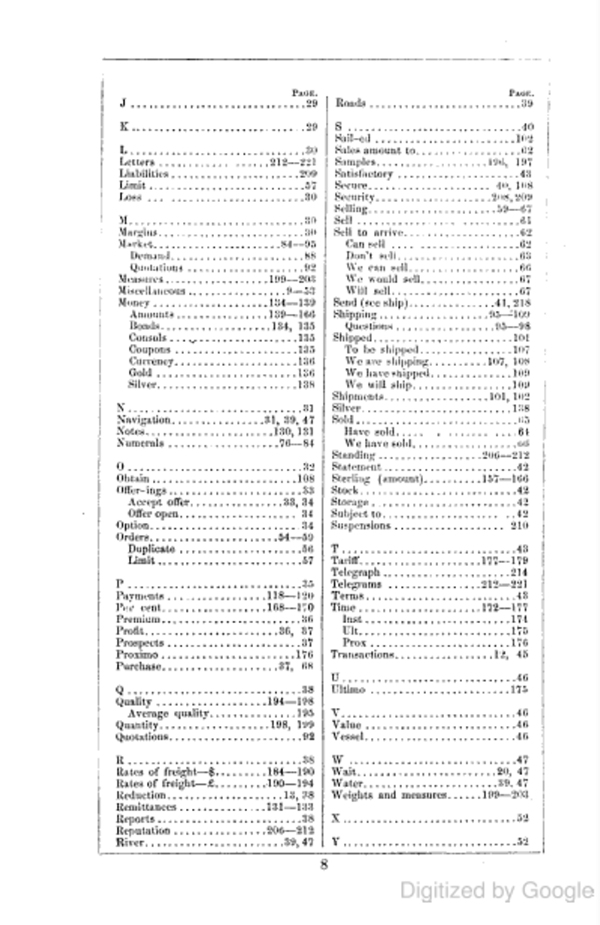 |
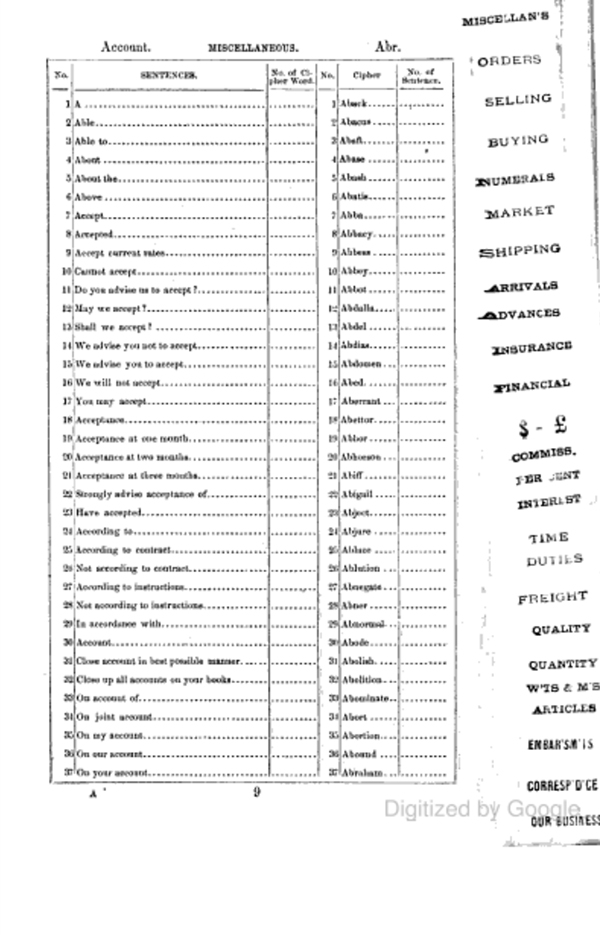 |
⬆
facing pages 8 and 9, Bloomer’s Commercial Cryptograph (1874)
| Bloomer’s Commercial Cryptograph, A telegraph code and double index—holocryptic cipher. By J(ohn). G(odfrey). Bloomer, author of the “Pacific Cryptograph.”
NYPL copy/scan (via google books) : link “By the use of this work, business communications of whatever nature may be telegraphed with secrecy and economy.” 231 printed pages, including title. The sole difference between this and the 1874 San Francisco edition appears to be the title page, which was slightly more decorative in the earlier version. |
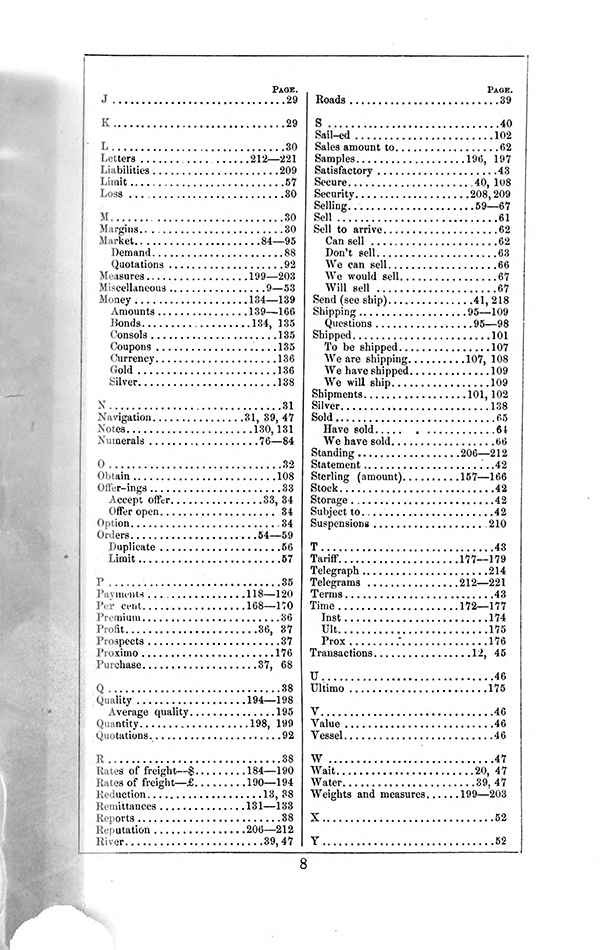 |
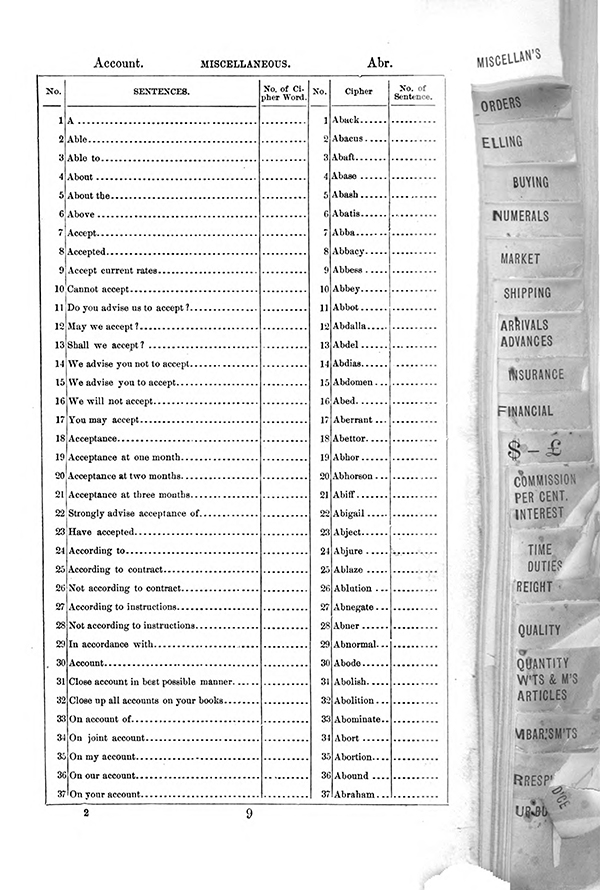 |
⬆
facing pages 8 and 9, Bloomer’s Commercial Cryptograph (1886), shown for comparison with the 1874 (San Francisco) edition.
but note different plate code under table, p9 : now reads “2” : was formerly “A”
| The General Telegraph Code. Compiled for the use of Bankers, Merchants, Brokers, and Sharebrokers, for the economical and secret transmission of mercantile telegrams “By the author of the “Cotton Telegraph Code”.” [Henry Robert Meyer] London: Hamilton, Adams, and Co., Paternoster Row. St. Petersburg: Watkins and Co. 1874 “From whom Special Private Editions may be obtained.” Bodleian copy/scan (via google books) : link xvi, 270 + 12 unpaginated blue ruled sheets (24 pp) at end |
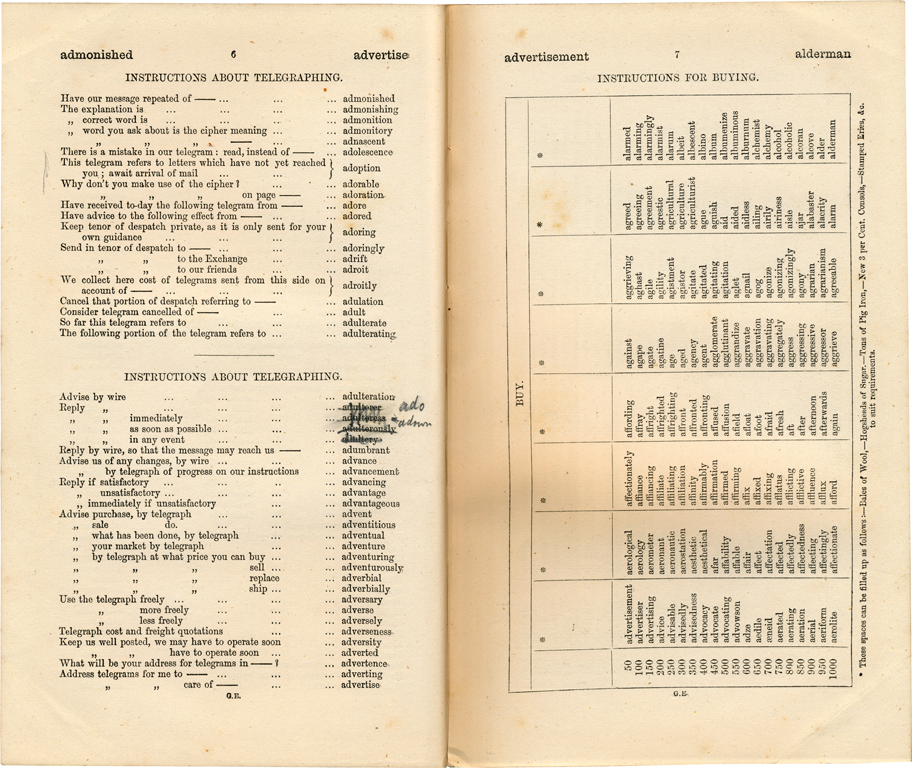
⬆
pp6-7, The General Telegraph Code (1874)
not from scan but from copy in private collection
showing user’s emendation, crossing out and/or replacing codewords deemed improper.
| The International Mercantile Telegraph Code. Compiled for the use of bankers, merchants, manufacturers, contractors, brokers, shipowners, &c., and their agents, for the economical and secret transmission of Business Telegrams. The ciphers being words of ten letters or under, to meet the requirements of the rules adopted at the St. Petersburg Interational Telegraph Conference of 1875 By the author of the “General Telegraph Code,” the “Cotton Telegraph Code,” &c. [Henry Robert Meyer] London: Hamilton, Adams, and Co., 32 Paternoster Row. Liverpool Agents: J. Mawdsley and Son, Castle Street. 1875 Bodleian copy/scan (via google books) : link English dictionary codewords. 226pp. |
| Banking Telegraphy Combining Authenticity, Economy, and Secrecy. Being a Code for the Use of Bankers and Merchants. Robert Slater. London: W. R. Gray, Change Alley, Cornhill, 1876 Bodleian (196.h.33) copy/scan (via google books) : link Tables, across two pages, throughout. |
Table of Contents.
Introduction (3). Tests for Messages (7). Key to verify amount transmitted (8). List of words illustrating ditto (10). Mode of using the Code (11). Messages illustrating the mode of using the Code (12). Secret method of Spelling Names, &c (13). Cash Payments (14). Credits (16). Bills of Exchange (18-27). Document Bills (28-33). Lost or Missing Cheques (34). Lost or Missing Drafts (36). Orders to Cancel previous instructions (38). Enquiries and Replies touching Credit of Firms (40). Rumours Current (42). Gold, Bonds and Exchange, Movements therein (44). Produce Markets, Movements therein (46). Purchases and Sales, and Enquiries thereon (48). Telegrams, Enquiries and Instructions respecting them (50). Letters, ditto (52). Amounts or Numbers (54-67). Shillings and Pence (68). Calendar (70).
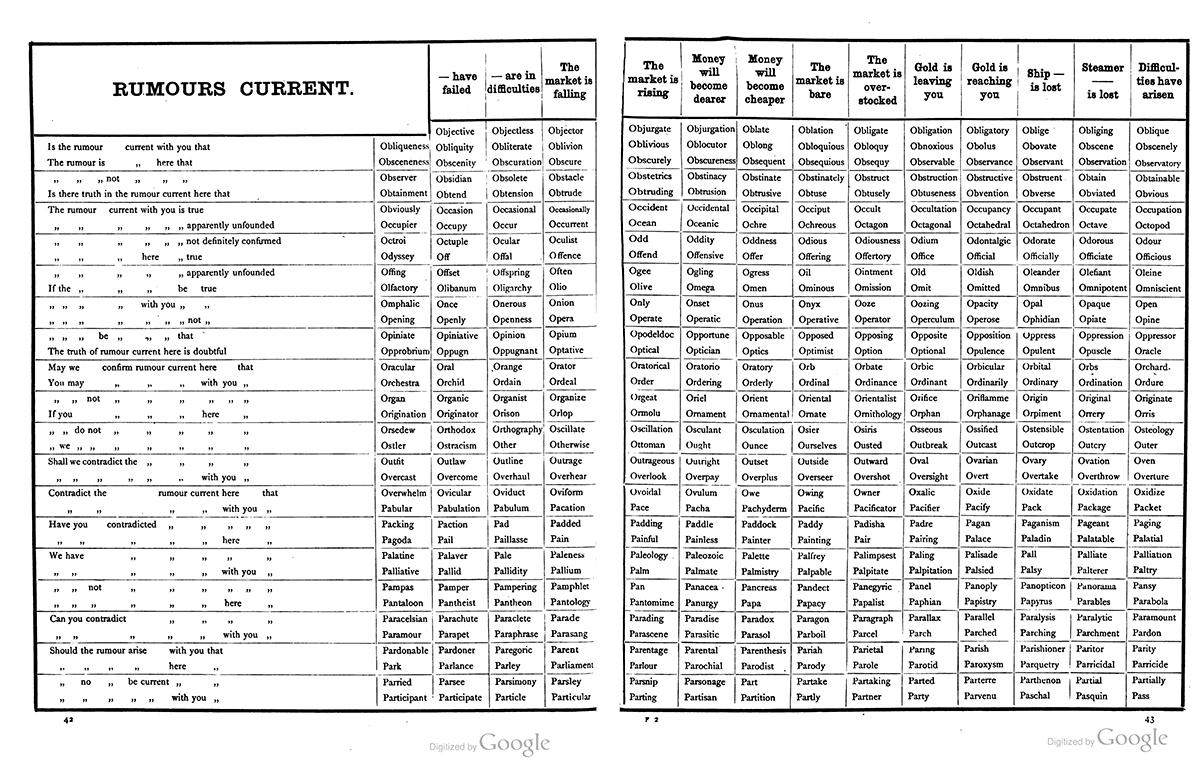
⬆
pp42-43 ex Banking Telegraphy (1876) : link
A panoptic presentation of message components (and their codeword intersections) such as that above, allows the user to survey at one glance a range of options. The vocabulary is controlled, of course. Where an important rumour is not represented by the available phrases, a user might 1 engineer something from elsewhere in this volume, or 2 resort to another code, or 3 s-p-e-l-l it out; additions would be circulated to holders of the code for inclusion and potential future use.
| 1876
The Three Letter Code E(benezer) Erskine Scott, Actuary and Accountant, London. London, 1876. Bodleian (25789.d.42) copy/scan (via google books) : link This copy (like same at BL), seems to be deposited to protect copyright; it provides a four-page “explanatory preface,” a two-page “examples and illustrations,” and three pages of vocabulary. Its Table of Contents projects a volume of 227+ pages. |
Impractical and inferior to other codes already available. Use of pre-concerted keyword enables a variety of permutations of three-letters to generate cryptograms. one three-letter code per word (not phrases).
| 1877
Ager’s Shipping Telegraph Code, for the use of Shipowners, Captains, &c. Compiled by Geo. Ager, LL.D. Author of the Telegram Code, The Social Code, &c. Bodleian copy (accession date : December 1877), via google books : link Preface iii-iv; Classified Index v-viii; code 1-304 — including spare words commencing p276. |
In his preface, Ager thanks shipping firms for the “liberal manner in which they have placed their Private Codes at his disposal.” Codewords are taken from his Telegram Code, “supplemented by others of nine and ten letters, and also by some of the more common Latin words.” He also discusses the “elision” of about 1,500 common names, to avoid confusion with ship names, with this observation: “However, as ships are named on such various principles, or without any principle at all, the author may not have succeeded entirely in this respect...”
Codewords are numbered up to the commencement of “Tables,” so as to provide a means of giving them double duty: indicator of phrase, or figure. The addition of the letter “C” to a code word indicates that the succeeding word represents its cypher (figure), not phrase. Tables commence at p262 (for days, decimal currencies, sterling, freight rates, and discount percents).
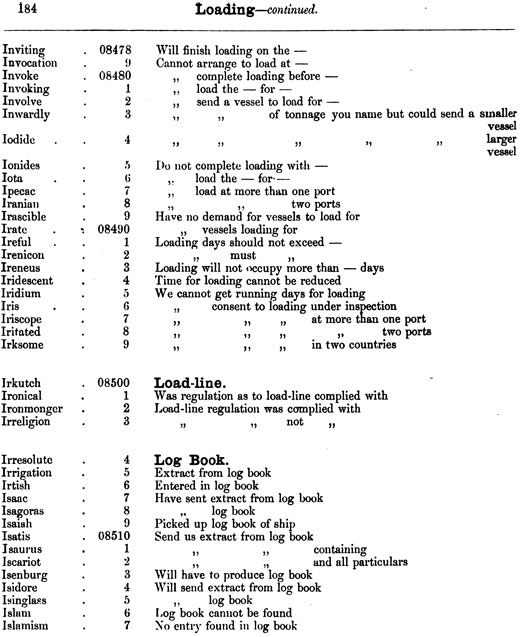
⬆
p184 (margins cropped) ex Ager’s Shipping Telegraph Code (1877)
At this time, shipping firms/captains might have been more familiar with codes not strictly following alphabetical order, but grouping at least some phrases in thesauric categories as exemplified in nautical codes and in Scott’s Code (1880, 1883). Ager stuck with alphabetical order in all his codes, and also provides a thorough classified index.
| 1878
Chesebrough’s Private Telegraphic Code. U California copy/scan (via hathitrust) : link Shipping, chartering. 16pp only: code on pp 3-8, [8 unnumbered blank pages], 9-16 |
| 1879
Private Telegraphic Code of Heath & Finnemore, Produce & Commission Merchants.. CIHM : link |
Grain (wheat), flour, butter, cheese, clover, peas (including “Black-eyed Marrowfats at p39”), oatmeal. All English dictionary codewords, whose initials indicate category/section of code. Phrases and tables.
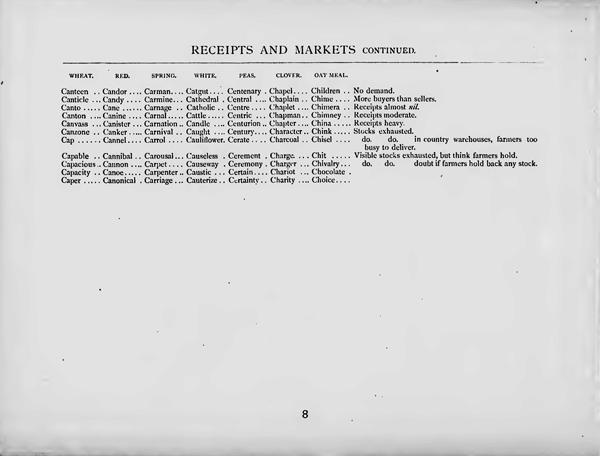
⬆
page 8, Private Telegraphic Code of Heath & Finnemore, Produce & Commission Merchants. (1879)
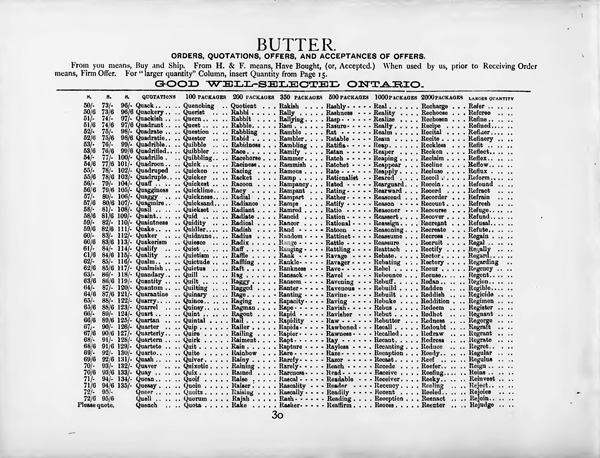
⬆
page 30, Private Telegraphic Code of Heath & Finnemore, Produce & Commission Merchants. (1879)
Uses partical prices in quotations/orders tables. Some tables (but not the one shown above), provide good explanations: e.g., —
“No mistake can be made in Flour to extent of 5/-. 0/0 stands for 15/-, 20/-, 25-, 30-, &c. Thus, “Trading” would stand for 19/6, 24/6, 29/6, 34/6, &c.”
or
“It is supposed that an error of 20- in the Article Quoted can scarcely arise.”
Handsome typography, judging from scan of microform.
| 1879
J. R. Foster’s Private Telegraphic Code CIHM : link Dewey Decimal 384.1/4 ; LC HE7677 G7 F67 1879 poor quality film/scan |

⬆
pp 38-39 (as appear in PDF spread), J. R. Foster’s Private Telegraphic Code (1879)
Instructions pp 1-2; Names of articles, specified quantities 3-4; quotations and quantities 5-9; letters, ec. 10-11; state of the market p 11; About buying (customer) 12-14; About buying (commission merchant) 14-15; About selling (customer) 16-17; About selling (commission merchant) 17-19; About holding and storing 19-20; About arrival and condition of goods, rejections, &c, 21-22; Miscellaneous 22-25; About buying/ time of delivery or shipment, 26-27; About shipping 28-31; Freights 31-32; Banking, financial and bills of lading, 33-42; Standing of firms, 42-43; Interest & commmission 43-46; Telegraphing, Correspondence and Communications 46-52; Insurance 53; Flour, grades & quantities, 54-56; Weights [57]; Key (cipher) [57]; non-code : Railroad freights (shipping rates, etc., [3 unnumbered pages]; index [2 unnumbered pages]
| 1879
The Phillips Telegraphic Code. Walter Polk Phillips. Washington, D.C., Gibson Brothers, Printers. 1879 NYPL copy/scan (via google books) : link 82 pages. Operator’s code, abbreviations for words and short common phrases |
wikipedia on the Phillips Code at wikipedia : link
The Morse Telegraphic Club maintains other material, as well as links, on telegraphy : link
| 1879
Private Cable Code for the Timber Trade. Bodleian copy 25789.e.3, (accession 31 July 1884), via google books : link [6], 1-174 and several [6?] blank sheets in back. TOC at (v-vi). Prices, quantities, specifications, “special sizes,” “Descriptions and Specifications” for a variety of wood types pp 57-94; also much on freights and chartering, selling and buying, reports and complaints, insurance, and names (“styles”) of firms. |
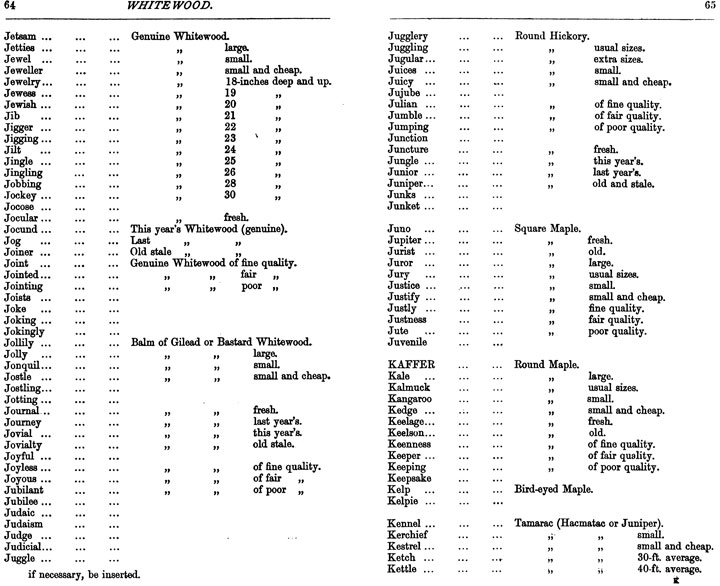
⬆
pp 64-65 (cropped), “Descriptions and Specifications,” ex Private Cable Code for the Timber Trade. (1879)
Phrases, some tables (in which codeword is intersection of two facets), shown below. Ample blank (skeleton) codewords for augmentations.
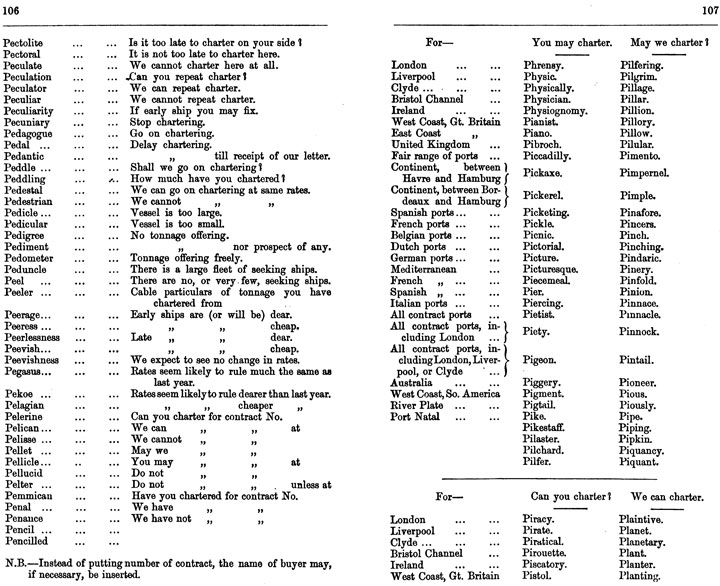
⬆
pp 106-07 (cropped), showing phrases and tables for “Freights and Chartering,” ex Private Cable Code for the Timber Trade. (1879)
| 1879
Telegraphic Codex NYPL copy/scan (via google books) : link |
The first part of the volume provides information on principal ports of North (and Latin) America, including maps (e.g., Baltimore Harbor, Galveston Harbor, San Francisco).
The Telegraphic Codex starts at (unnumbered) page 300, commencing a new pagination 1-150. Part IV. Special Phraseology (miscellaneous sentences) starts at code page 110 : link.
The code is preceded by a one-page “Directions” for use, a three-page, three-column index, and the table of contents shown below —
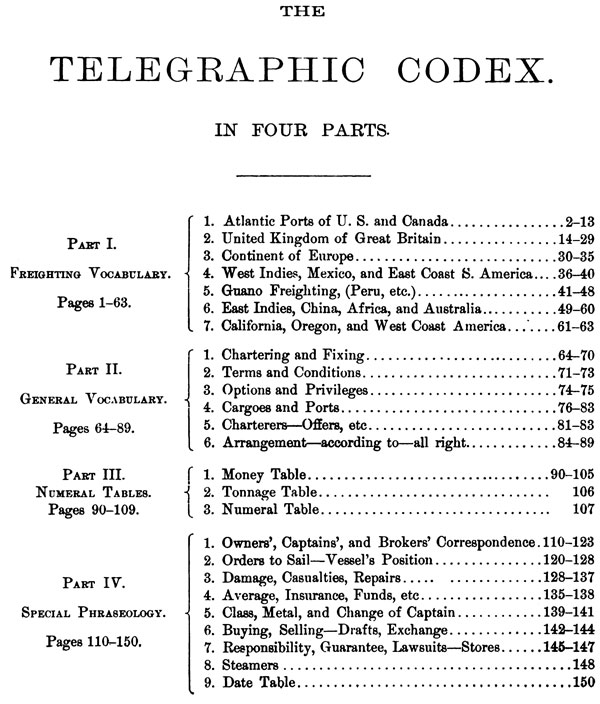
⬆
from Port Charges and Requirements on Vessels (1879); page cropped : link
The code employs English and near-English dictionary codewords of various lengths, as short as four letters:
tool / Lost part of deck load), up to 11 or 12 letters:
unhappiness / It is the order of.
Some of the pairings are nice:
twaddle / Vessel referred to must be RECLASSED,
twang / Vessel has been reclassed.
Port circumstances would likely have been subject to constant change, and the code is not designed to easily accommodate augmentations. A sample page is shown below.
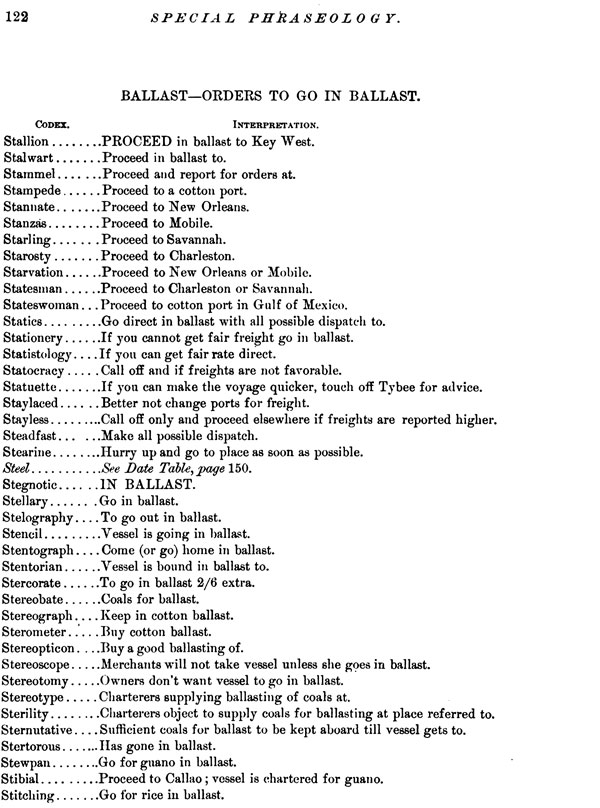
⬆
ex Port Charges and Requirements on Vessels (1879); page cropped : link
| 1880
Combination Telegraph Code. Oxford U copy/scan (via google books) : link Root and terminal (“stems and terminations”), “Latin verbs of first and third conjugations only.” A shipping code, comprised of tables allowing 161,280 “essentially different telegrams” whose facets are qualities (56 possible), prices (72), quantities (10) and times of shipment or delivery (four). A two-page preface/explanation gives examples of how the code might be used. |
| 1880
14,400 Latin Words Not exceeding ten letters Bodleian (196.h.49.) copy/scan (via google) : link 27cm. (high), 11 printed pages: title, preface, detector (showing likely Morse signal errors), seven pages of roots/inflections, and table showing terminational order. The word “telegraphic” does not appear on the title page, but the volume is described thus by Bodleian — “14,400 Latin words [a telegraph code]” |
Generates genuine Latin words, from tables of roots and inflections. The inflections are re-used in each of the seven tables that comprise the code; roots are unique.
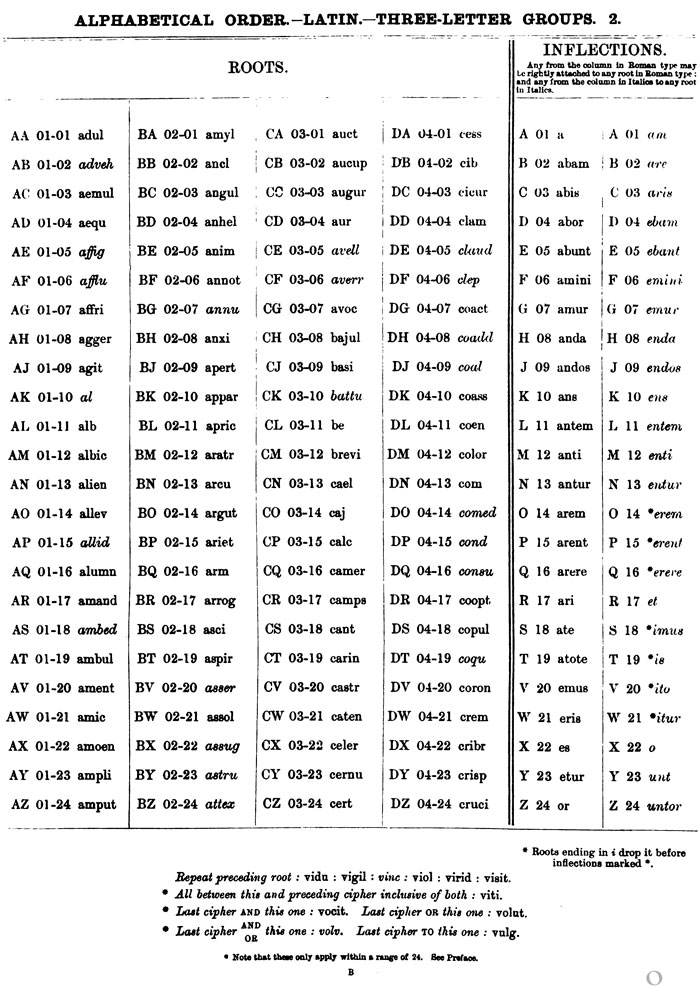
⬆
details, ex 14,400 Latin Words (1880), the second of seven codeword pages.
The preface explains that pairings of roots and inflections must respect roman/italic differentiations — the former are of first conjugation; the latter are of active verbs of the third conjugation. It would seem that someone’s classical education could not abide the formation of “spurious” words via conjugational miscegenation. See the preface for usage of the extra words at bottom of the page (in brief, allow shortened messages where several successive codewords use the same root.
| 1880
Ager’s Telegraphic Primer or Skeleton Telegram Code. by Geo. Ager, LL.D., author of “The Social Code,” “The Standard Telegram Code,” “The Telegram Code,” and “Ager’s Shipping Telegram Code.” Bodleian (196.h.62) copy/scan (via google books) : link |
Preface.
The Telegraphic Primer has been compiled to suit a large body of Merchants, who, on commencing business, wish to make their own Codes, and has been prepared upon a plan which experience has suggested to the Compiler is expecially suited to that purpose.
The words — 16,000 in number — are all good “Dictionary words,” and are all to be found in the Dictionaries of Webster or Nuttall.”
The words are all accompanied with cyphers. In the first 6,000 the cyphers proceed from 000 to 999 in separate thousands, as they are intended to facilitate the filling up of the Code at both ends, the Merchant in England filling up the odd numbers, and his correspondent the even numbers.”
The first 160 pages are printed with 25 words per page, and afford facilities for writing any of the longer sentences. The next 40 pages (161-200) contain two columns of 25 words each, and are intended to afford Code Words for the names of articles, indents, and shorter sentences, &c.
The remaining 10,000 words, intended for Tables, Market Advices, Prices, &c., are arranged in closer columns of 50 words per column on the last 48 pages. The numbers indicating the thousands have been omitted at the head of the columns, so as to admit of their being added from the beginning or only from page 161.”
“The Author is preparing a small work on Coding which will be ready shortly.”
| 1880
The Telegram Code. Harvard, Cabot Library (Eng 4348.80.3) : link pp. xviii, (2), 720. 4to By “good telegraphic words” is meant pronounceable words (as required by European telegraph administrations) that are sufficiently different from each other to be distinguishable from others even in the event of mutilation in transmission. |
The code words are numbered, so that in some pre-concerted applications, the codewords could stand for a phrase alone, and/or for their respective figures. Thus, Encenago might signify either “Large clip of (Wool) this season” or the figure 14746. Ager instances the codeword Mutual 29795, which might be agreed to indicate time (first figure), destination (second figure), price (third and fourth figures) and order number (last figure). Thus : This copy is stamped B. S. Pray & Co., and includes holograph additions relating to wool, e.g., Batuffo 164/39 / The wool is full of carrot seed.
The Telegram Code provides numerous blank tables, in the form of five columns of code words on a page facing a column of code words. The user fills in the column at left with “names of the leading articles traded in, or with different qualities of the same” and the headings to the columns at right with other facets of information (e.g., mode of shipment, or quantity). The arrangement — which is commonly encountered in the code dictionaries — allows of a better surveyability and saving of space but does not result in a saving of the number of indications, i.e., code words or ordinals. (Barto 1934 : 36)
British Library lists numerous codes compiled by Ager, including general, social, special (engineering, shipping, financial) and private (indigo) codes, as well as combination codes; he also compiled several lists of code words complying with Telegraph Convention rules. It is likely that Ager compiled other private codes, consistent with his willingness, expressed in the preface, “to assist purchasers of the Code who may wish to construct Special Tables with the Cyphers.”
Private Telegraph Code of Hamilton, Fraser & Co., Liverpool Bodleian (196.h.54) copy (via google books) : link shipping
detection of errors pp iii-iv; ToC p v; index vii-xi; special index (for grain) p xii; code pp 1-164
Maguire’s Code of Ciphers. Charles H(enry). J(Joseph). Maguire, Chief Accountant of the Union Bank of Lower Canada. Quebec, 1880.
CIHM (via archive.org) : link [eight prelim pages (only v and vii paginated)]; 1-113, [1]; index tabs at right.
Introduction pp v-vi, followed on p vii by a (transposition) key, one column of which is filled in.
one page geographical names, two of banking phrases (pp99-101), and numbers pp 102-103; the rest is 18,000 words, each indicated by a 3-letter cipher, whose letters in turn point to “page” (table), column, and word.
A three-letter code, each 3L cipher pointing to a location in the book. Brings to mind John Brookes his Alphabet Telegraph Code, specially prepared for the butter and general provision trades (Manchester, 1889). Maguire did not elaborate a phrase vocabulary, however, beyond the two pages shown below. Could not work in this form for cable; purely suited to secrecy, not safety.
The Commercial Telegraph Code. Bodleian (196.e.61) copy (via google books) : link i-xx, 1-228 from p i :
Law’s mercantile cipher code. Toronto: Bingham & Taylor, Printers, 33 Colborne St. 1880 CIHM : link “Filmed from a copy of the original publication held by the National Library of Canada;” “Microfilm is of poor quality.”
(English) dictionary codewords, all numbered; blanks are provided for every entry, for private codewords or for (carefully done) substitutions of one codeword for another. instructions and examples pp 1-6; blank cipher code 7-14, weights and quantities 15; freights 15-16; railways 16-17; state of markets 17; time 18; drawing 18; financial 19-20; communications 20-21; notes and protests 21; selling 21-22; buying 22-23; shipping and forwarding 23-24; arrivals 24; advances 24-25; commission 25; interest 25-26; stocks, banks, etc. 26-27; insurance companies 28; railways [bonds] 28-29; mercantile reports — amounts 29-32; articles [e.g., Wheat, No. 1 Spring] 32-34; hardware 34-35; oils 35-36; lumber 36; months 36-37; leather 37-39; tanner’s supplies 39; terms 39-40; miscellaneous 40-44; index 45
Appendix Telegraph Code. Compiled by H. R. Meyer, B12, Exchange Buildings, Liverpool, author of the “Commercial Telegraph Code,” “International Telegraph Code,” “General Telegraph Code,” and “Cotton Telegraph Code,” To which it is intended as a Supplement, as well as to Private Codes Bodleian (196.e.62) copy (via google books) : link blank (skeleton) code 0001-4379 entries (german words, all numbered):
Cypher Code. Bodleian (196.e.63) copy (via google) : link i-xxxvi, 1-318
Cypher Code. Bodleian (Bodleian 25789 d.7), via google books : link i-vii, 1-276
coffee, and (to a lesser degree) River Plate produce, cereals, cotton The two codes are substantially different, in phrase matter (and in tables); this would reflect the different sorts of messages being sent from and to Rio de Janeiro, on the one hand, and the Phipps locations in North America and in Liverpool. The table below (is my) attempt(s) to understand the relationship of these two codes.
A large part of both codes is in the form of tables; shown below are specimen pages of phrases from the 1880 and 1881 volumes; note the differences in what phrases are available in each. ⬆ Possibly because of the 1879 ITU conference, more attention is given to codeword (“cypher”) characteristics in the 1881 preface than in the 1880 volume. From that (1881) preface — note: Of special interest is the idea that the code compiler has used the basis of every communication involving the Phipps businesses “during the last five years.” A similar trawling through archived messages would have played a part in the compilation of phrases for any code; a compiler would have interpolated material not encountered in those records, but that might be conceived as likely to be needed in future. Some additions (and subtractions) of codewords between the 1880 and 1881 codes can be seen in two pages shown below. ⬆ The Phipps codes are less dictionary and more a set of procedures for compiling a message; this is particularly clear in how their respective tables of contents provide both “contents” (procedural) and an alphabeticized “index” for their parts A, B and C. See how the order in which components of a message are assembled, follow the order of the appearance of their source sections in the code — ⬆ I have labored more on these two volumes than with other codes described on this page. One reason is my embarrassment at having not previously known their were two Phipps codes (they are listed with the same title, albeit different years, in the Bodleian catalogue. And too, closer attention to their differences has been instructive. At some point, I might compare this code with those used by J. W. Doane, another coffee trader, whose archives (codes, cable register books, and related correspondence) are in London’s Guildhall Library.
The A.B.C. domestic code. Harvard (Cabot Library) copy/scan (via google books) : link 2 p. l., 360 p. 18 cm.
Several pages of preliminary matter (title page, intro) followed by code pp 1-360.
Codewords at outside columns; most spreads provide blanks on one page, phrases (or occasional tables) on other. Handsome typography. A.B.C. / The Send-off.
⬆ Tables include p124 for dimensions in feet, or pp 220-221 for percentages. A second edition appears in 1885, with a 60-page appendix of additional matter, e.g., sterling amounts, but also new phrases.
Macgregor’s Variation Tables for Code Telegraphing. Bodleian (196.h.48) copy (via google books) : link Preface v-x; (2); 1-147; “Suggestions for Tabulated Forms” 148-150
I have not examined a physical copy, but all printed pages 1-147 appear to be recto only, obverse blank. The book has two parts: the first is a figure code, whose figures indicate sequences of letters from one to 15 letters in length, each respectively indicating a topic (and or table) from which the meanings of successive following codewords are to be found; the second (and arguably more useful) part is a suggestion for generating a figure code for tables of different numbers of columns. The author P Macgregor writes in his (promotional-toned) preface that his Table is compiled on a system that is “entirely different from that of any published code,” and that it has been in “constant use in the author’s own business (between England and South America) for several years with perfect success.” I have not yet been able to learn more about P Macgregor and his business The Variation Tables —
The cipher 22800 (whether expressed as a figure, or converted into a pronounceable codeword) indicates that the succeeding codewords regard topics F, G, I, K, L, M, N and O, in that order. Macgregor gives the following suggestion about what such index letters could indicate — The main purpose of this system is to get the most out of limited number of codewords — limited either because of cable administration rulings, or the shortage of safe and euphonious codewords for assembly of a larger code. By this system, a single codeword can be used for up to 14 meanings (signs A through N) or, as Macgregor writes, a code “capable of expressing a hundred thousand words becomes becomes practically equal to one of nearly a million and a half of Code words.” This is made possible by the index system, providing a map, as it were, to how to translate a succession of codewords by pointing to their respective topics or locations within a code. The requirement that the “variations” are always to be placed in alphabetical order would potentially limit flexibility about message construction. Suggestions for Tabulated Forms —
So how does this work? First, it assumes tables. A table would be devoted to a specific topic, e.g., “Shipments to Manchester.” Each of the four headings/columns would indicate some facet of meaning relating to those. For example: Second, let us say a coded message 6,291 is received. We understand it to be derived from a table with four columns. We unpack it as follows: The message would be 9 - 10 - 7 - nil, whatever values 9, 10, and 7 respectively pointed to. Third, one would commence compiling a Table from the right, “the rate of progression being the top number reached in the last column.” In the example above, the top figure in Column 4 is 10, and so the rate of progression in Column 3 is 10; top figure in Column 3 is 70, and so the rate of progression in Column 2 is 70; and so on. Because there would probably be several — and even many — such tables in a large code, there would also need to be indicators (possibly contained in Column 4, in this example) of those tables. I.e., last sign 4 might mean, turn to Table D to translate next code word/figure. The “10,000” mentioned by Macgregor isn’t clear to me: 14 x 11 x 8 x 10 = 12,320 (so perhaps I’m misunderstanding this). Mr Herb’s Numbers The Barto example concerns “shipments to Manchester,” by the way. Finally
Whittingham’s Skeleton Telegraph Code. Bodleian (25789.e.5) copy (via google books) : link blank. pp 195-205 are a “Merchants’ Secret Order Code,” being three columns of code words (1-16) arrayed with blank row and column heads It occurs to me (now, 20231130) that a firm might start with a blank/skeleton code like this, gradually fill it out, adjust as necessary, augment it with phrases, and then create their own code. ⬆ Copyright page advert describes Whittingham & Co. thus :
Wilson’s Ship Broker’s Telegraph Code. Bodleian (196.e.80) copy (via google books) : link unpaginated title, preface and index (shown below), and printed pages 1-35 (of which 31-35 are blank/skeleton entries). Ship brokerage, especially American grain and cotton trades — “The combinations and sentences have, however, as far as possible, been so arranged as to make them suitable for other trades.”
⬆ Shown below are specimen pages regarding bales of cotton, quarters of wheat
⬆ The Wilson code is narrowly focused on transaction particulars, and provides no “general” or “miscellaneous” phrases/sentences.
Private Telegraphic Code with James Adam, Son & Co.. Bodleian copy, accession 28? November 1883 (via google books) : link two pages of preface; 124 codes pages, of which 1-110 are phrases; 111-118 are quantities; and 119-124 are blank/skeleton.
Produce. Phrase headings for almonds, currants, dates, eggs, figs, grapes, guano, lemons, linseed, melons, nuts, onions, oranges, pears, pine apples, persimmons, plums, pomegranates, potatoes, prunes, raisins, rice, salmon, sardines, tomatoes and wool. ⬆ ⬆ Hard to understand the reasoning behind inclusion of
Telegraphic Code to insure privacy and secrecy in the transmission of telegrams. NYPL copy TTD+ (Miller, F. Telegraphic code), via google.books : link 118 p., 1 l. 31 cm. Preface pp 3-4; Test-words page 5; Fractions and Amounts pp 6-10; New York Bankers pp 10-11; Words and Phrases pp 11-91; Reports page 91; Time page 92; and Extra Cipher-Words pp95-98; followed one printed page containing an index and an index-like “special lists” for pages 99-118 (which do not, evidently, exist in the book from which this example is scanned). The extra cipher-words run from 12302 Selfhelp through 13999 Wardance (not1400 as the Preface states), totalling 1697. In his preface, Miller stresses that his code differs from cable codes: “For inland telegraphing, simplicity and speed are more important than economy. With cablegrams the reverse is the case. Cable codes are mainly composed of vast numbers of phrases, and are so intricate that few country bankers will use them” (p3). His code provides fewer, and shorter, phrases. A majority of the phrases are one and two words in length (the book is typeset in two columns per page). His “extra cipher-words” enable users to customize the code for special purposes. The code provides no tables in which code words are at the x,y intersections of columns and rows of meaning. Shown below is detail from page 91, showing some “words and phrases,” and some “report” phrases — Secrecy for monetary transactions is the important feature of this code. To ensure secrecy, a “shift number” feature is provided, whereby each message is translated by a key that is not repeated. I believe the explanation given by Miller, and shown below, is clear enough — No explanation is given about how to translate a codeword whose sum “serial number” exceeds 13999 — presumably, one would circle round to the beginning of the code. Sequences of these irregular “shift” numbers are to be discarded with each use.
further
The Globe Commercial Telegraph Code. Bodleian (196.h.50) copy (via google books) : link Faulty scan; all printed pages appear to be present, but code proper commences at page 212 of the PDF, following 200 blank pages. index at pp ix-xx : link this pdf is confusing; does it combine two different Meyer codes? same page numbers contain different material... will return to this, eventually. Ideally would view physical copy.
LoC is even more confused : Harald Gyllstoff, Globe Commercial Correspondence (1935) appears to be confused with this code : link
Scott’s Code. Bodleian copy (via google books) : link Arranged in two halves: the first (pp 1-270) being thesauric, the second (pp 271-535) being alphabetical order of codeword : hence, every codeword and every phrase appears twice. Details provided below. Scanned pages of contents and entire preface appear beneath this ToC. The code — in its first eight parts, the ninth being the “vocabulary” — is further subdivided into 110 sections. Contents, Errata : link (facing page i) ⬆ ⬆ The thesauric arrangement of phrase matter, and alphabetical order of codewords, yields non-sequitur phrase sequences in the second part of the code, as shown below :
Telegraph Code, 1883. U Illinois at Chicago copy (via archive.org) : link Index to code. Telegraph code pp 18-40
Pages 4-15 of the volume are “a brief summary of the various departments of our business.” For the Banking Department : ⬆
The Globe Telegraph Code. Bodleian copy/scan (via google books, better) : link “All the ciphers used being Spanish, and not over then letters, they are adapted for both European and extra-European messages.”
mainly root and terminal (facing pages, respectively), and largely blank (skeleton)
Preface, instructions : ii-vii ⬆
Cypher Code for Telegraphy. Bodleian copy/scan (via google books) : link 3L ciphers. 113 pages, from p1 AAA to 113 ZZZ. that’s it — every permutation of 26 letters, in three-letter cyphers.
Cable Code Bodleian (25789.d.14) copy/scan (via google books) : link dictionary English code words. John Crossley & Sons was a major carpet weaving firm; incorporated jacquard process in the 1830’s; produced printed tapestries and velvets. Code phrases regard ordering, inventory and shipments of mats, carpets, rugs, tapestries, saddle bags, royal velvet; tapestry and velvet “squares” (floor coverings); table covers. John Crossley & Sons records, at UK National Archives : link
The entire Index (= ToC) and a specimen page spread (with some nice code/phrase pairings) are provided below. ⬆ ⬆ ⬆
Scott’s Code. Bodleian copy/scan (via google books) : link Part First, Particulars of ship : 1-15 Might compare with other Scott / Ship Owners’ codes, as they expanded over their successive editions.
Telegraphic Cipher,. Harvard (YBKL P935) copy/scan (via google books) : link dictionary English code words. i-v, 6-66 ⬆ ⬆
The Pocket Telegraphic Code. Bodleian (25789.f.5) copy/scan (via google books) : link 16 pages total. social code, for people with servants, club, betting and bootmakers.
Index to subjects Zopis / What is the sea like?
Sixpenny Telegrams. Bodleian (25789.e.13) copy/scan (via google books) : link preface; code and phrases, pp 3-38; blank (skeleton) figure code, pp 33-63. “The Code Words (between 1,300 and 1,400) are, for the most part, familiar words...” — that number is approximate (I have not counted them). specimen pages below. ⬆ ⬆
Telegraphic Code. Cornell copy/scan (via google books) : link
23 codeword/phrase pairs only, entirety transcribed below “Telegraphic Code. We print below the code adopted by the committee appointed at the Cincinnati meeting of the Society of American Florists, and recommended to the wholesale flower trade for general use.” “Unquestionably the above will save the trade much expense, and at the same time make plain many points continually arising, which have heretofore been left in doubt because of the large number of words necessary to fully explain. Let every dealer see that both his customers and shippers are provided with a copy. —Ed.”
Spalding’s Telegram Guide Bodleian (25789.E.6) copy/scan (via google books) : link n.d., n.p. but 1885 according to BL and Bodleian. 18cm high (Bodleian); W. Allen, Printer, Norwich (on last printed page).
Eight (printed) pages, including title and preface (code 3-8). The code commences with a “Part I” (pp3-4), followed by Part II (pp4-8). from the preface — ⬆
Some codeword/phrase pairs appear in both the speculators and Brokers sections, e.g., Sanity. ⬆
Telegraphic Code, The American Educational Catalogue. Harvard copy/scan (via google books) : link The “Educational Catalogue” itself (with codewords for each title) runs on pages 95-127; a subject classification appears on pp 127-32; followed by instructions for use of the code (p133) and a list of educational publishers (with the respective 2L ciphers) on page 134. “A telegraphic code for ordering text-books, which is intended to replace the individual codes issued by publishers... with a uniform method for the entire trade... based on the name of publisher, name of author, and designation of individual book (sometimes by initials and sometimes necessarily arbitrary) — a natural system... also allows code-signs for new books to be interpolated in future catalogues without breaking down the system...” The code seeks to provide a unique telegraphic name for each title, that would later be attempted by OCLC and ISBN numbers. It is unworkable because too complex, and too complex because it seeks to accommodate books from various publishers, including books that do not yet exist.
“Each book is designated by six letters: “Thus, AdefCO would mean Addick’s Elementary French, published by Charles Collins.” Exceptions (same book issued by different publishers, different items in series, etc) are handled by adjusting the ciphers, or affixing letters indicating ordinal numbers (m-1st, n-2d and so on through v-10 “or 0”). Quantities are indicated by adding letters to the six-letter name for a respective title (a-1, b2, x-3, d-4, e-f, f-6, g-7, h-8, i-9, j-0, k-00, l-000). The third and fourth letters designating title (rather than author) are inconsistent: sometimes sensible (“gp” for “Greek Prepositions”), sometimes arbitrary (“hz” for “key to Fourth German book”). entire page below : ⬆
Telegraph & Cable Code, in use between John Paton & Co., New York, and — — U Chicago copy/scan (via google books) : link securities, syndications Index (ToC, subjects in alphabetical order), ⬆
Telegraphic Code to Ensure Secrecy in the Transmission of Telegrams. U Toronto (HE7675.S6.1888) copy/scan (via archive.org) : link
a reprint, rather than new edition. See longer entry for 1870 edition, on this page.
Code Télégraphique Français — NYPL copy/scan (via hathitrust) : link
xx, 636 p.map.fol. Here is a major general code, in four parts; uses figures and codewords, and a “Table Syllabétique” for secure s-p-e-l-l-i-n-g of names of individuals and locations that are not found in the code. The long preface (pp v through vi) and “Mode d’empoy du code” (pp viii-xx) together function in part as a self-marketing device. The latter includes five example messages (coded and plaintext), plus instructions for encoding long figures, and for encrypting messages using a pre-concerted key for a given day of the month, whereby codewords indicate figures, to/from which are added/subtracted certain numbers to yield the intended codewords. ⬆
2, 9, 79, 5 could signify : 2 (within 21 days), 9 (to Glasgow), 79 (at 16s. 9d. per barrel), and 5 (This is order No. 5).
1880
same (via archive.org) : link
1880
A comprehensive system of cryptography designed for general use and arranged in conformity with the rules and regulations adopted by the International Convention of Telegraph Companies, respecting “Secret Language Telegrams.”
same (via U Alberta, via hathitrust) : link
“Filmed from a copy of the original publication held by the D.B. Weldon Library, University of Western Ontario”
LC description : vii, 113, [1] p. 21 cm.; call number: HE7673 .M23
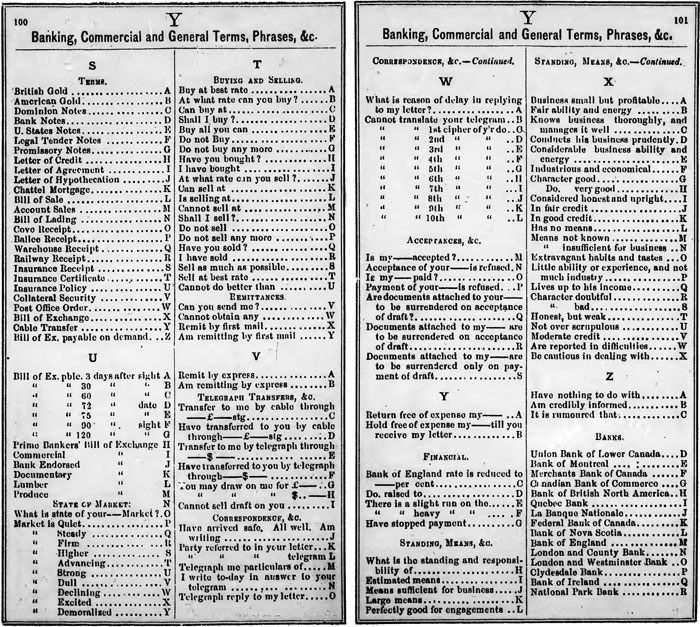
⬆
details, ex Maguire’s Code of Ciphers (1880), pp 100-101, from scanned films
1880
for the use of Bankers, Merchants, Manufacturers, and Brokers and their Agents. A re-compiled edition of the “International Telegraph Code,” with Ciphers of ten letters or under, and specially selected to meet the requirements of the Rules adopted at the London International Conference of 1879,
Compiled by H. R. Meyer, B12, Exchange Buildings, Liverpool, author of the “International,” “General,” “Cotton” Telegraph Codes, etc.
London: Hamilton, Adams & Co, 1880; Liverpool Agents, J. Mawdsley & Son.
permalink (and access to pdf) : link
mix of sentences, phrases, tables; blanks too.
Important Notice. The International Telegraph Code.
The International Telegraph Congress, held in London this year (1879), having decided to prohibit the use of proper names “used adjectively,” the author of the “International Telegraph Code” much regrets to be compelled to issue a New Edition of that work for use with countries affected by the new rules, as it contained some ciphers which come under the above clause. For such countries as are unaffected by the rules of Telegraph Congress — for instance, the “United States” — the original edition will remain as effective as ever, and therefore, in announcing the issue of a new edition, the author desires it to be distinctly understood, that the original edition of the “International Telegraph Code” will be continued as heretofore. In order to distinguish the new edition from the old, it will be published under the name of the “Commercial Telegraph Code.” at 25ss. per Copy.
[ bold emphases as in printed volume. ]
1880
for forwarding business communications by telegraph, telephone or postal card, with secrecy and economy. Published by W. A. Law & Co., Union Loan Buildings, Nos. 28 and 30 Toronto Street
In use by subscribers and attorneys of the Canadian Reporting and Collecting Association
same (via U Alberta, via hathitrust) : link
also, blank (skeleton) entries.
1880
A Blank Code of German Ciphers, selected to meet the requirements of the rules passed at the London Telegraph Congress of 1879.
London: Hamilton, Adams & Co, 1880; Liverpool Agents, J. Mawdsley & Son.
permalink (and access to pdf) : link
pp 1-12 (spreads, not pages) : 12 tables (8 columns)
pp 13-24 : 12 one-page tables (6 colums)
pp 25-77 : (blank) phrase-sentence entries.
1880, 1881
Compiled by Messrs. Phipps & Co. for their own use and for the use of Messrs. J. L. Phipps & Co. of New York.
Liverpool: Phipps & Co., 3, Cook Street. / 1880
permalink (and access to pdf) : link
Compiled by Messrs. Phipps & Co. for the use of Messrs. Phipps Brothers & Co. of Rio de Janeiro, and for their own use.
Published by Phipps & Co. / 1881
permalink (and access to pdf) : link
elaborate tables for combinations of grades, intelligence on tone of market, etc.
![]()
1880
1881
i-v
Preface. “Liverpool, 15th March, 1880”
i-ix
Preface. “8th March, 1881”
v-vi
Contents.
(A) New York & Liverpool to Rio de Janeiroxi-xii
Contents (A).
(A) Rio de Janeiro to Phipps & Co., and to New York
vii-xxvi
Index.
(A) New York & Liverpool to Rio de Janeiroxiii-xxii
Index (A).
(A) Rio de Janeiro to Phipps & Co. and to New York.
xxvii
Index to special cyphers for American orderers.
to be used with cypher names of firms, pp 3-4
—
xxviii
Index to special cyphers for European orderers.
to be used with cypher names of firms, pp 5, 7 and 8
—
xxix
Contents.
(B) New York to Phipps & Co. onlyxxiii
Contents (B).
(B) Rio de Janeiro to Phipps & Co. only.
xxx-xxxiv
Index.
(B) New York to Phipps & Co. only.xxiv-xxvi
Index (B).
(B) Rio de Janeiro to Phipps & Co. only.
xxxv-xxxvi
Contents.
(C) Phipps & Co. alone to Rio de Janeiroxxvii
Contents (C).
(C) Phipps & Co. to New York.
1
Cyphers for Use from New York to Liverpool & Rio de Janeiro, And from Liverpool to Rio de Janeiro
1
Cyphers for Use from Rio de Janeiro to Phipps & Co. And to New York
2
Dates (table)
3
Dates (table)
same cyphers (abandoning, abbacy, abbreviate, abdicated...)
3-11
Names of Firms (verso pages are blank, and not numbered);
p 11 is cyphers “to facilitate transmission of names of firms”4-10
Names of Firms
13-18
Orders — Special cyphers for American orderers; and Orders — General American
12-13
Communications as to the disposal of consignments to the U.S. or to Europe
⬍
⬍
197-200
Phrases for Use in Any Connection
154-160
Phrases for Use in Any Connection
⬍
⬍
315-316
Personal
zigzag zodiac zoology zootomist276
[spare] Private Cipher for Phipps & Co. to New York
zigzag zodiac zoology zootomist![]()
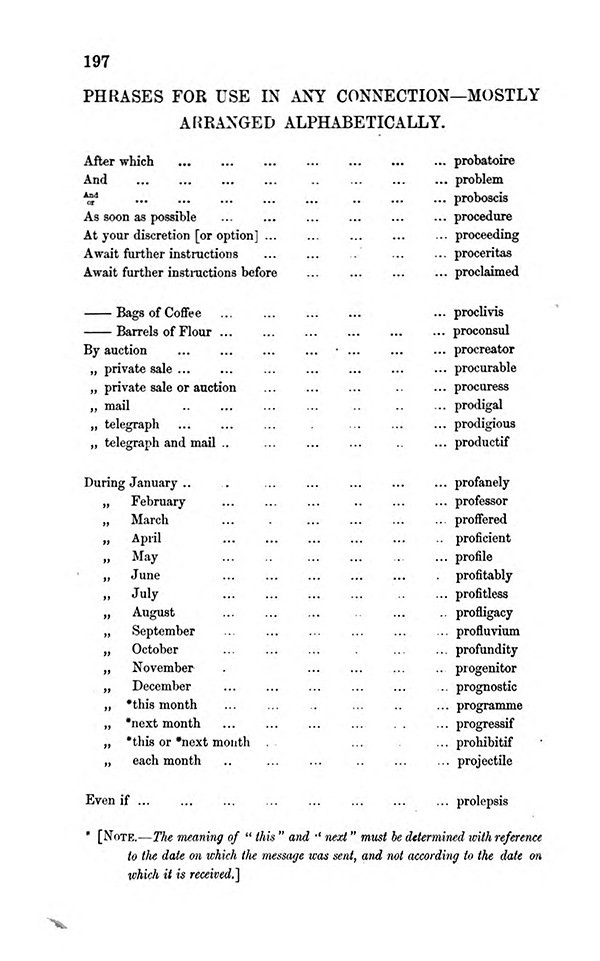
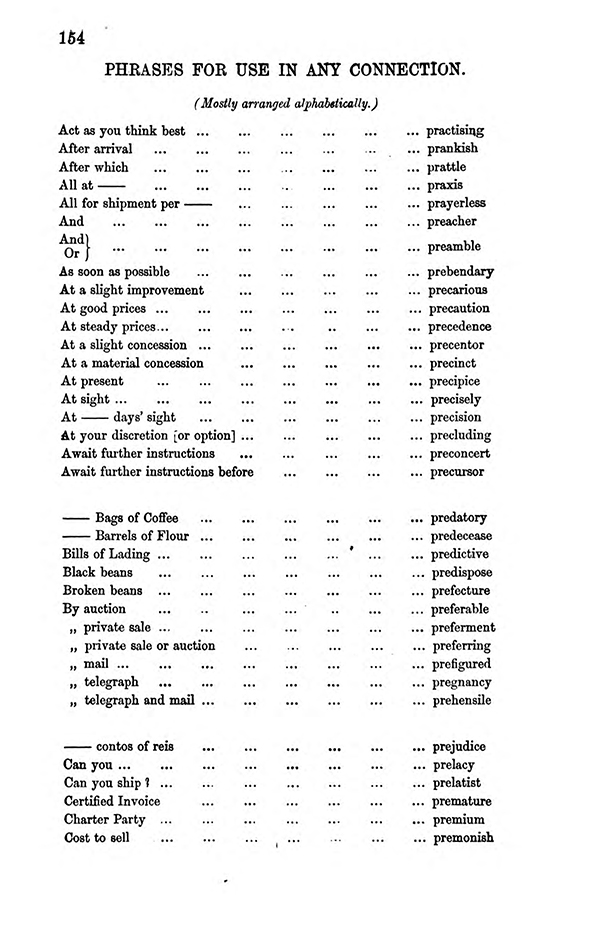
Phipps Cypher Code, 1880 at left, 1881 at right, showing different phrase matter under same heading.
Every cypher in this Code can be found in standard dictionaries of the language to which it belongs. The majority of the words employed are English; some are French or Latin; and two or three are Portuguese. Names of persons and places have been rejected.
The use in their natural sense of words or phrases other than individuals’ or ships’ names must be carefully avoided, unless absolutely necessary. It should be needless to emply them, as the Code affords means of accurately transmitting the substance of every communication that has been wired by Phipps Brothers & Co. to Phipps & Co. and J. L. Phipps & Co. during the last five years; and it would be dangerous to employ them, as almost every English word is used as a cypher or is very similar to some word so used. If, however, it be found necessary to use in their natural sense words which are used as cyphers in this Code, they must be guarded by one of the cyphers “peninsula” to “penniless” from page 138, unless they be preceded by the cypher “pencilled” or one of the cyphers on page 212 for use to Phipps & Co...
emphases (both bold and italic) are as in the original.
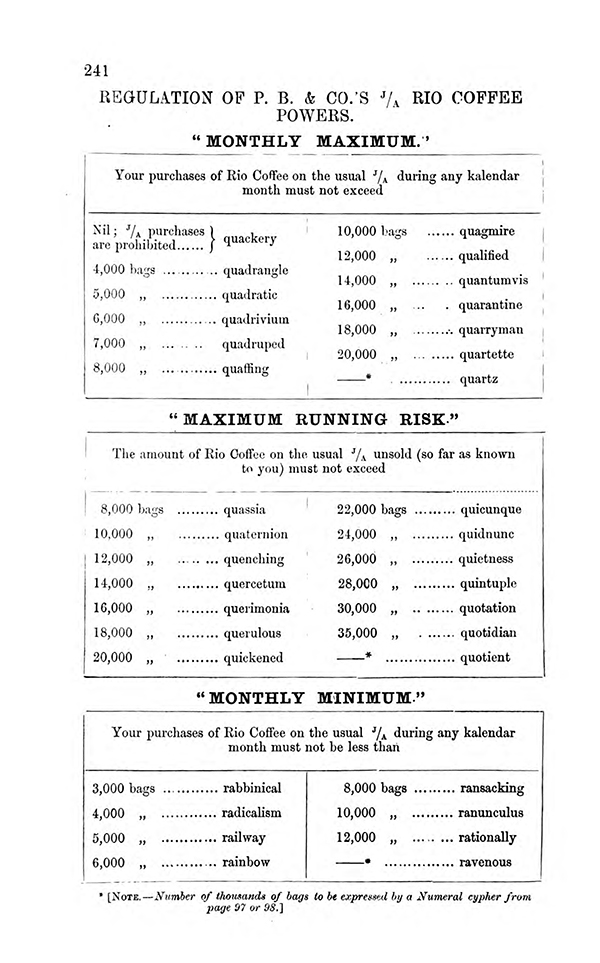
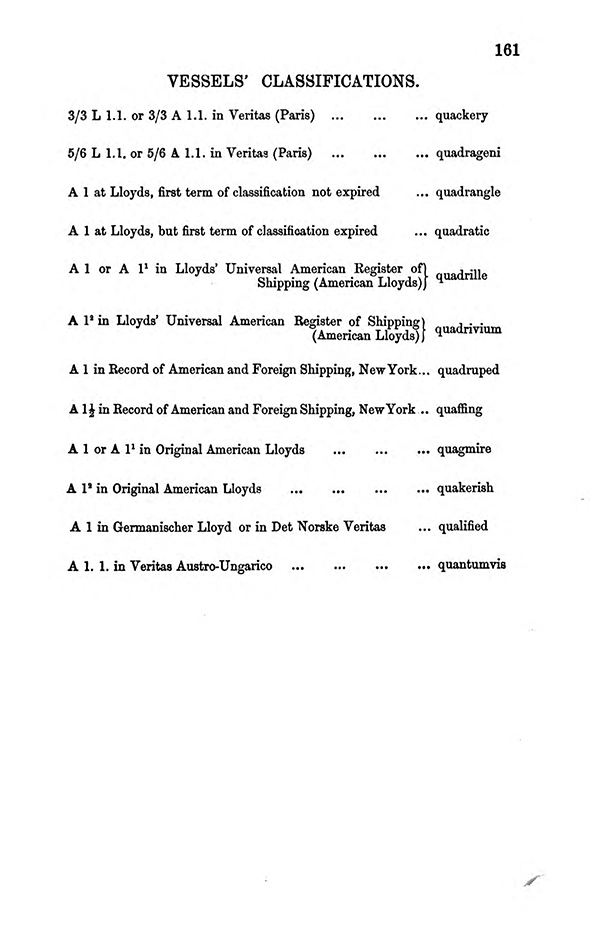
Phipps Cypher Code, 1880 at left, 1881 at right, showing some changes in codeword selections.![]()
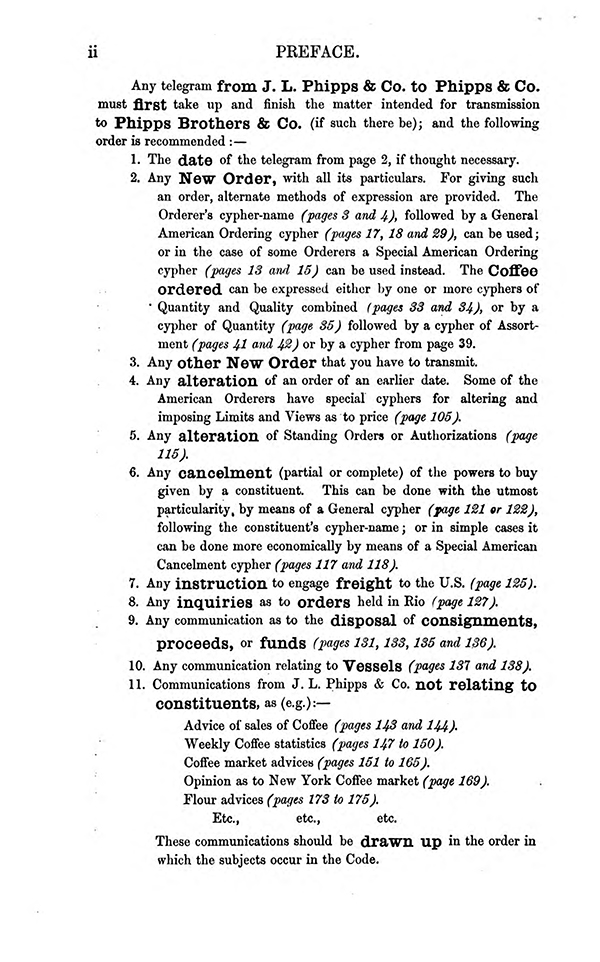
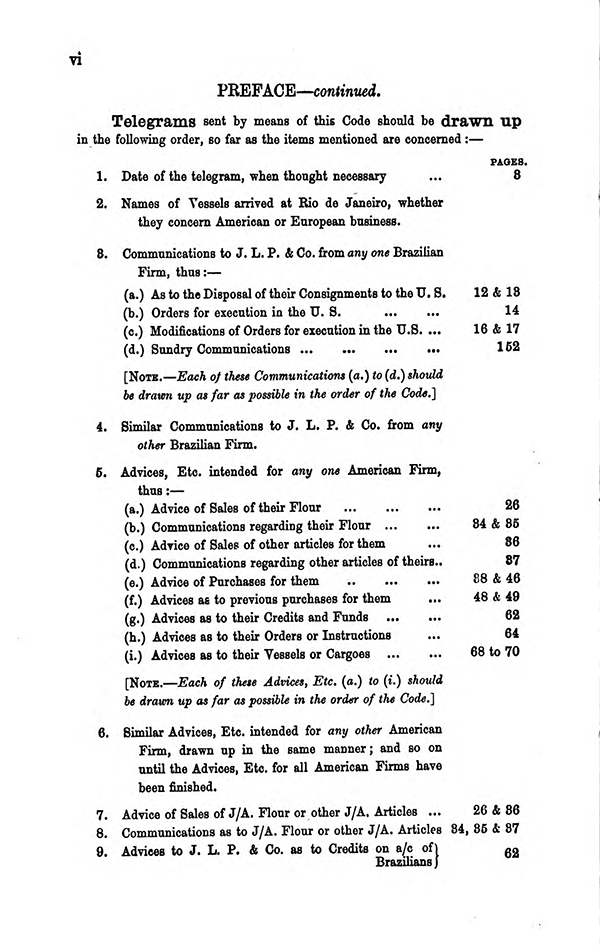
Phipps Cypher Code, 1880 at left, 1881 at right, discussion of procedural construction of messages, in their respective prefaces.
1881
All words of six to ten letters, from Webster’s Dictionary
Henry Harvey 125 Pearl Street, New York. 1881
same (via hathitrust) : link
“The principal idea in a Code Book on this plan is that it requires no Introduction or Explanation whatever. “He who runs may read” a message, or send one off, with equal facility; All the Leading Words, printed in SMALL CAPITALS, being run in strict Alphabetical order like a Dictionary, as are also the Code Words, over Ten Thousand in number. Only, when you don’t find a needed phrase under one of its Leading Words, try under another.”
“In making up the Sentences, I have sought to cover General Domestic requirements rather than Specialties of any particular trade, though some of these may be found too.”
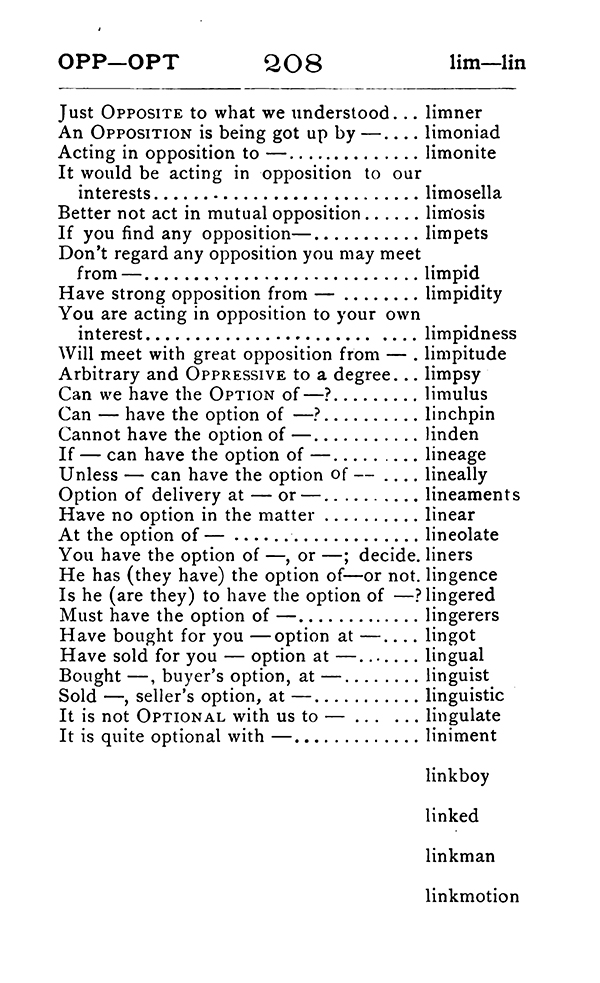
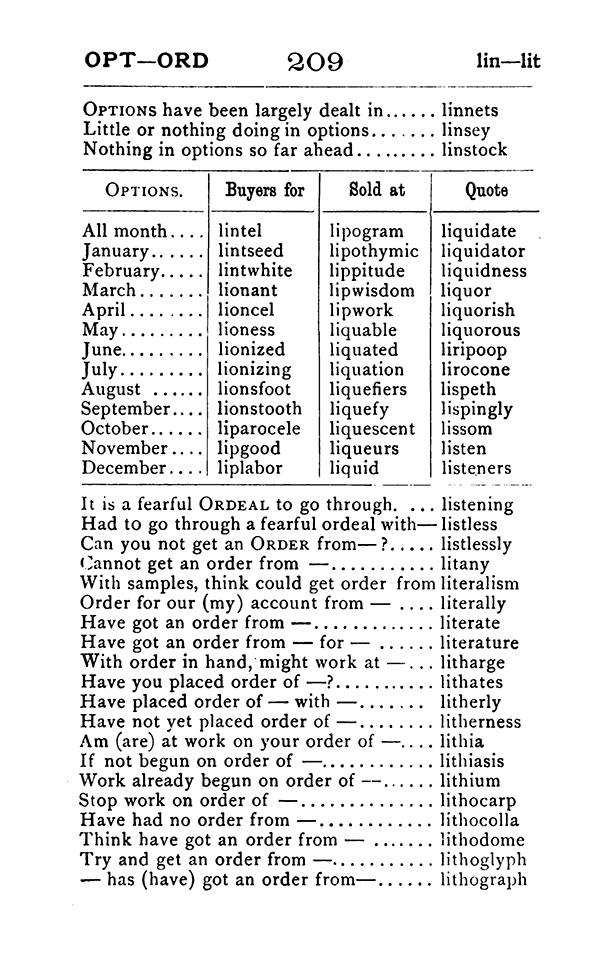
showing phrase and in-line tabular matter, The A.B.C. domestic code (1881)
![]()
description and view of copy (private collection) : link
NYPL copy (via hathitrust) : link
1881
Table of fifteen signs for indexing telegrams and other purposes.
Manchester: Palmer and Howe, n.d. (but accession Bibliotheca Bodleiana May 1881)
permalink (access to pdf) : link
also BL 8756.ee.29
These tables provide “indicator” figures, each indicating the topics (and their associated tables) from which subsequent codewords are to be looked up. Here is an example of such figures and “index” letter sequences —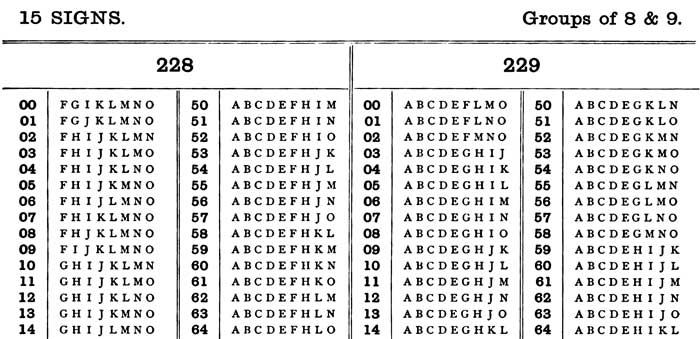
⬆
ex Macgregor’s Variation Tables for Code Telegraphing (1881), p98 (detail)
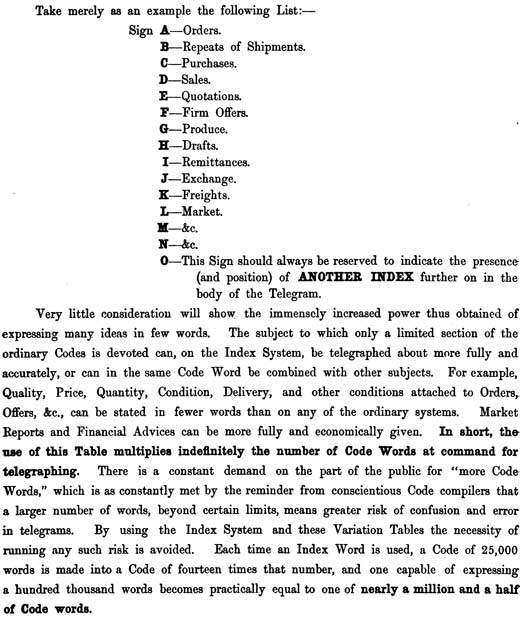
⬆
ex Macgregor’s Variation Tables for Code Telegraphing (1881), p vii (detail)
Macgregor’s system is designed to work with tables; this section feels like an afterthought, but in fact integrates well with index code just described, and is a pretty good exposition of a method for assembling tables for use with a figure code. I don’t however have a good sense of the degree to which it was used in practice. Shown below is the second example provided for a four-column (four heading) table, “within the power of a Code of 10,000 words” (“words” here meaning, separate items/indications) —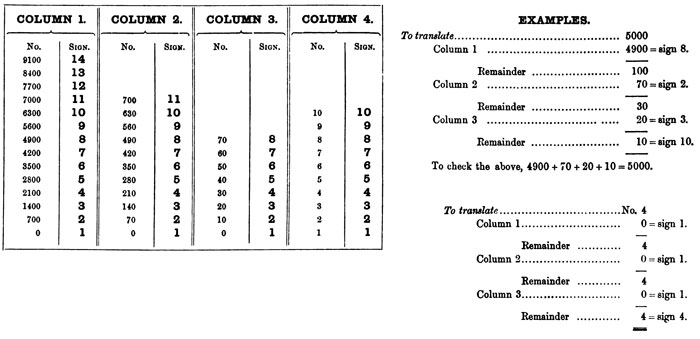
⬆
two examples for a “table of four unequal columns... within the power of a Code of 10,000 words,”
ex Macgregor’s Variation Tables for Code Telegraphing (1881), pp 149-50 (rearranged for this presentation)![]()
Column 1 : month or other timeframe, 14 possible meanings;
Column 2 : price (possibly “partical price,”), 11 meanings;
Column 3 : quality, 8 meanings; and
Column 4 : some other specification (e.g., color, or indicator for following code word/figure), 10 meanings —
The largest figure in Column 1 that is contained in that figure is 5600 (sign 9). Remainder (6,291 minus 5,600) is 691.
Largest figure in Column 2 is 630 (sign 10), remainder 60.
60 in Column 3 is Sign 7.
There is no remainder, and so there is nil value for the fourth position.
Macgregor offers no examples containing phrases or full (plaintext) messages.
Barto discusses what is essentially the same system in his Economy and Technique of Codes and Code-Condensers (1934) pp38-41, at the end of a section on tables. Barto gives an example taken from C Herb’s Code-telegrafie voor handel en nijverheid (Amsterdam, 1903 — itself a free translation from Herb’s Kaufmännische Telegrammatik (Leipzig, 1900)) — employing 46,800 code words in five headings (or columns) in a table. (I may show this later).
The title page asserts that “This work is copyright, both in principle and detail,” and each copy of the book is said to bear the written signature of the author (as this one does). The principle is probably more important than the text, in this case, and it might arguably be better protected by patent than copyright. Indexing systems were patented in the United States; this may not have been the case in Britain at the time, however.
1881
A Secret, expansive code for ordinary business purposes. With code words representing fractions, weights, numbers, pounds sterling, merchants’ orders, every date in the year, &c., including blank pages and extra lines available for 4,148 special messages. All Code Words revised under the latest International Regulations.
London: W. B. Whittingham & Co., 1881
permalink (and access to pdf) : link
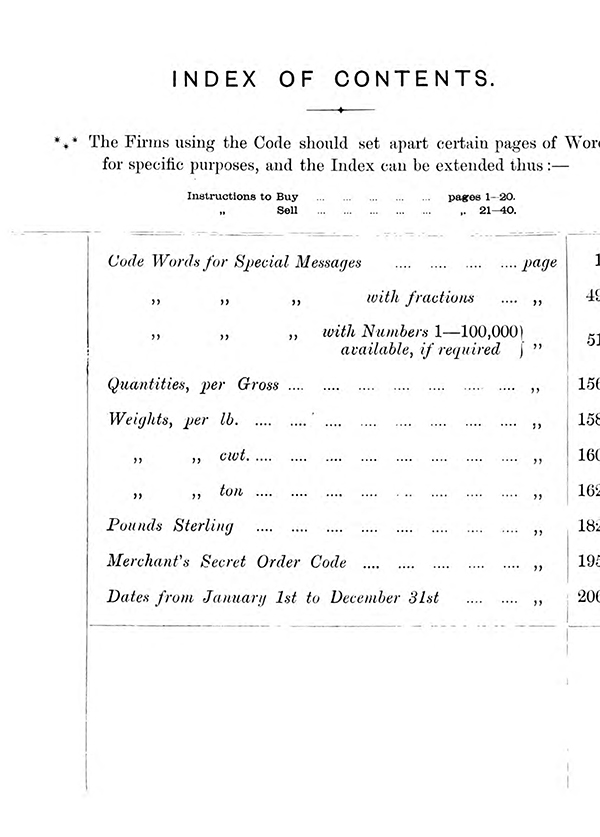

Table of Contents, and page 49 (showing fractions)
not a spread, from Whittingham’s Skeleton Telegraph Code (1881)
![]()
“Wholesale & Retail Manufacturing & Export Stationers, account book makers; commercial, law and general steam printers; lithographers & engravers of bills of exchange, bills of lading, promissory notes, bankers’ cheques. Printers in all heads of Plain and Chromo-Litho Circulars and Price Currents. Booksellers and Publishers. Office for The Peninsular and Oriental, The British India, Australian, Eastern Trade, Cape, Continental, Sailing, and other Bills of Lading.”
Works — 4, White Hart Court, Bishopgate Church.
91, Gracechurch Street, London, E.C. (six doors from Cornhill).
1881
Compiled specially for chartering negotiations.
London: Effingham Wilson, 1881
permalink (and access to pdf) : link
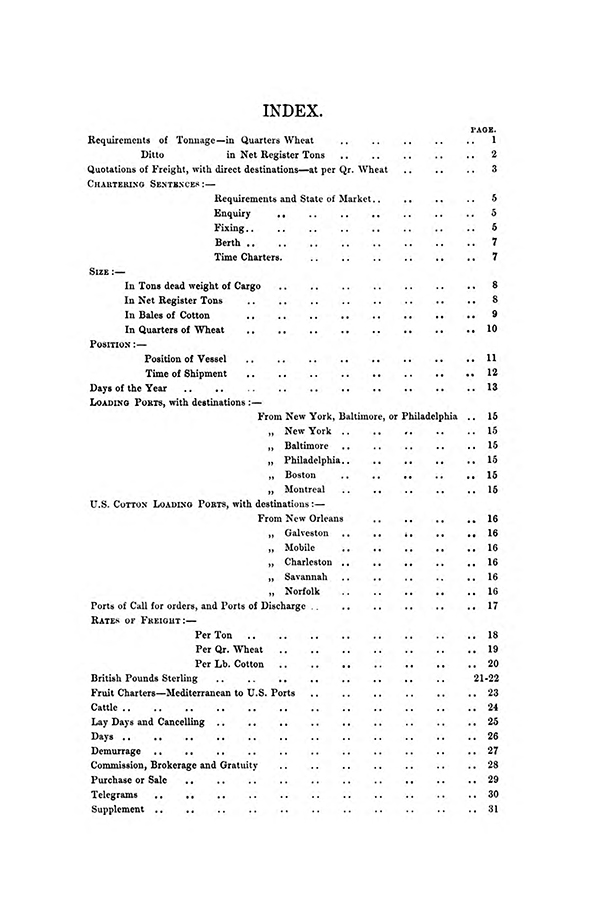
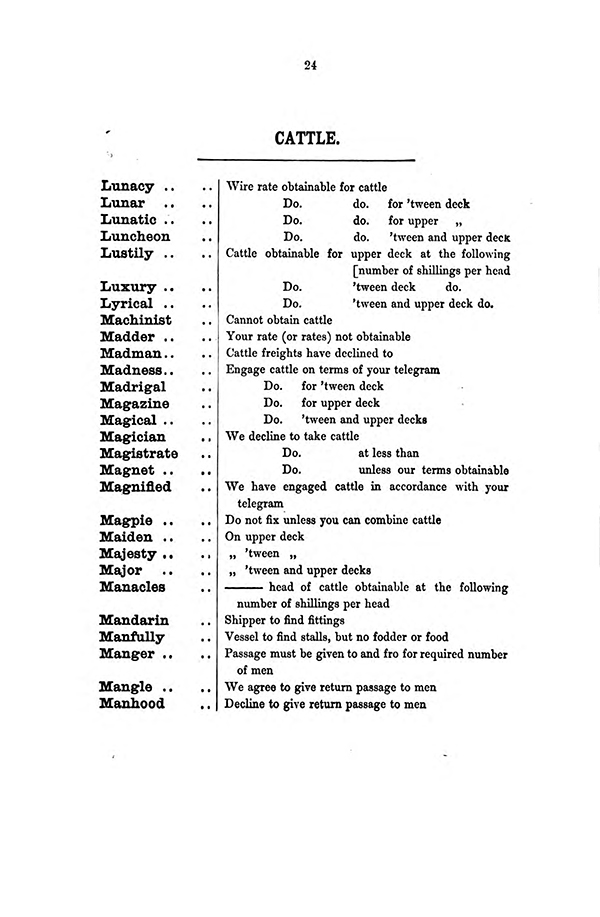
Index, and p.24
not spread, ex Wilson’s Ship Broker’s Telegraph Code (1881)
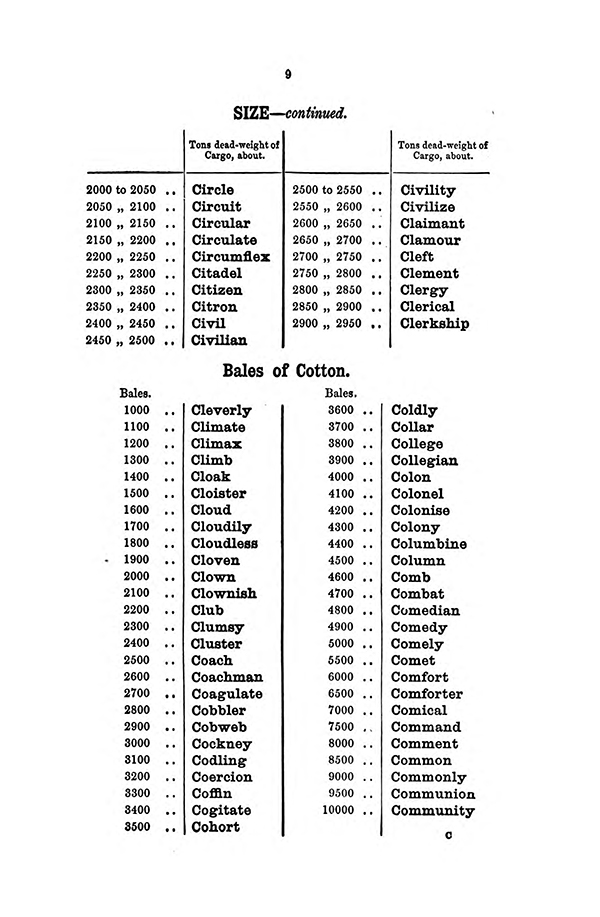
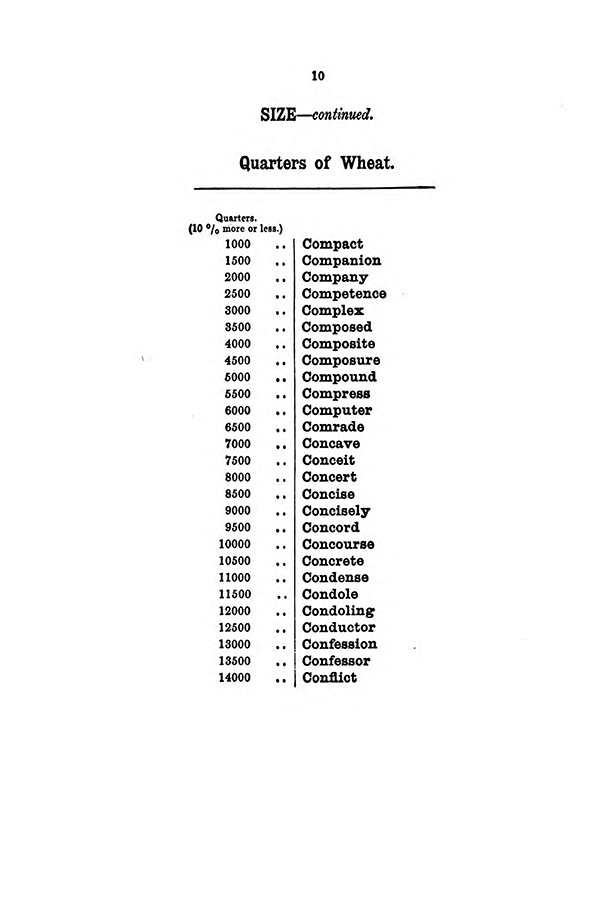
pages 9 and 10
not spread, ex Wilson’s Ship Broker’s Telegraph Code (1881)
![]()
1881
Liverpool, 1881. Third Edition.
Printed at the “Liverpool Mail” Office, Central Chambers, South Castle Street.
permalink (and access to pdf) : link
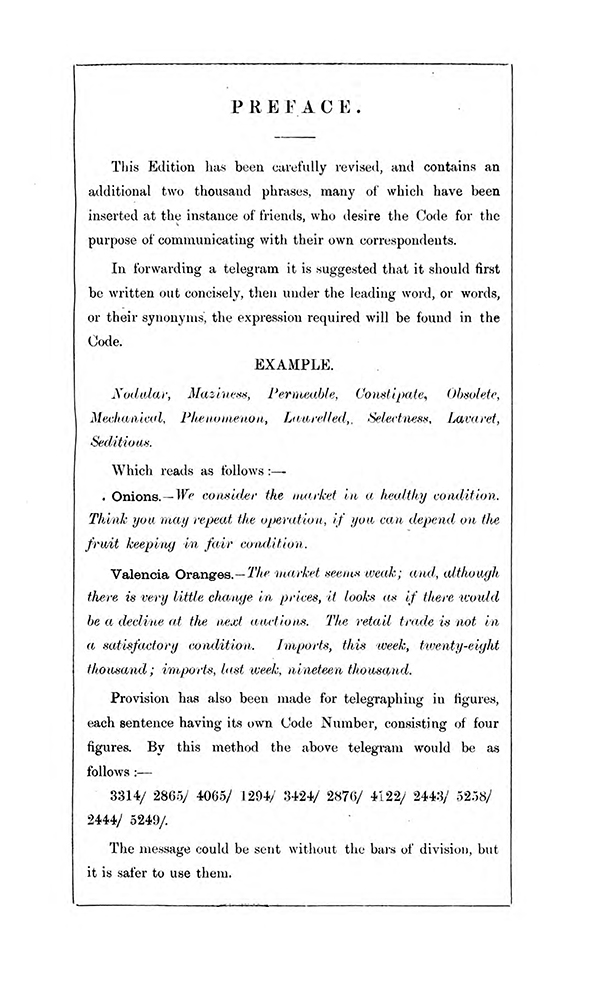
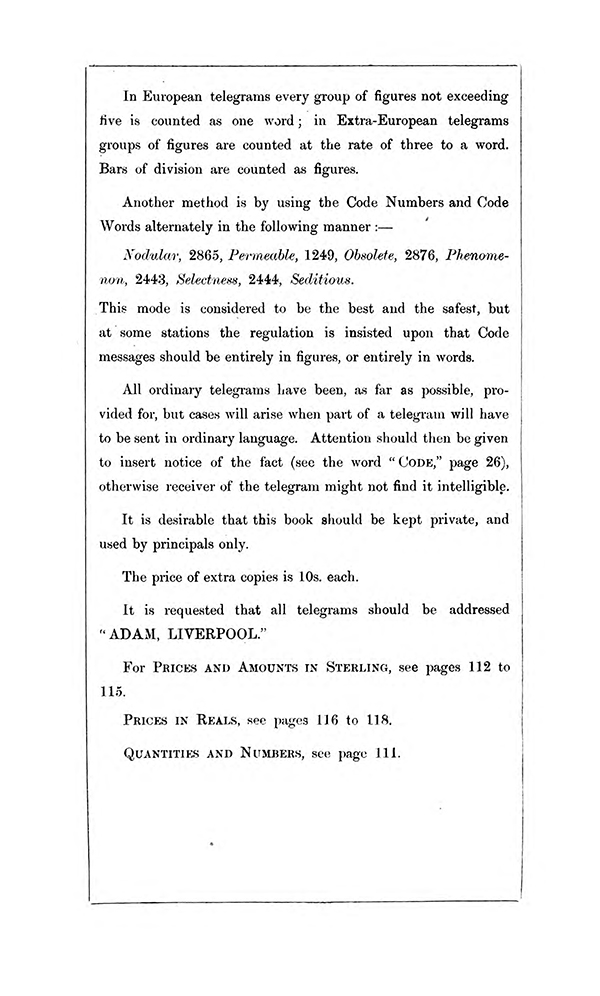
preface, entire
ex James Adam code (1881)
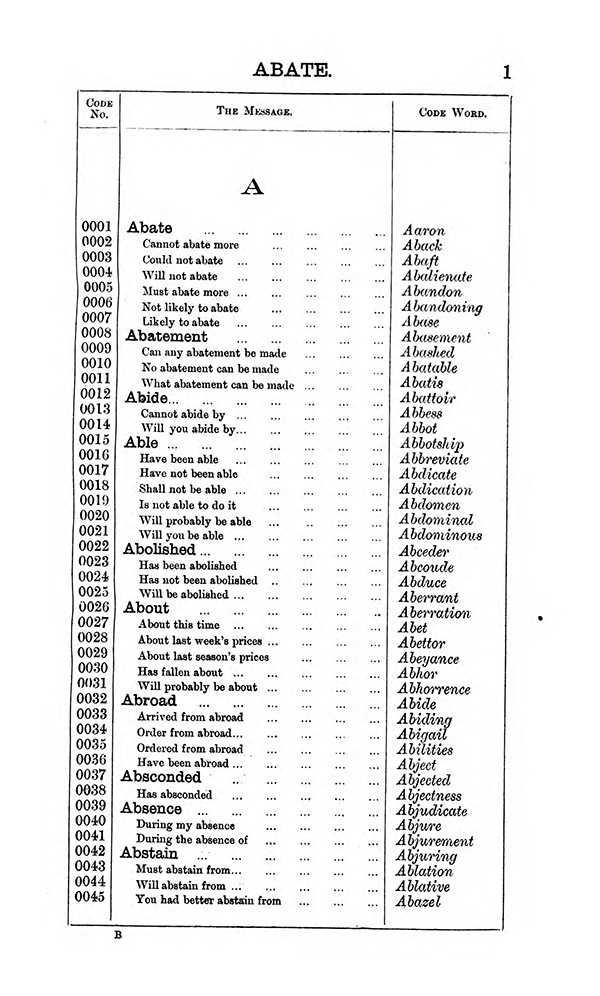
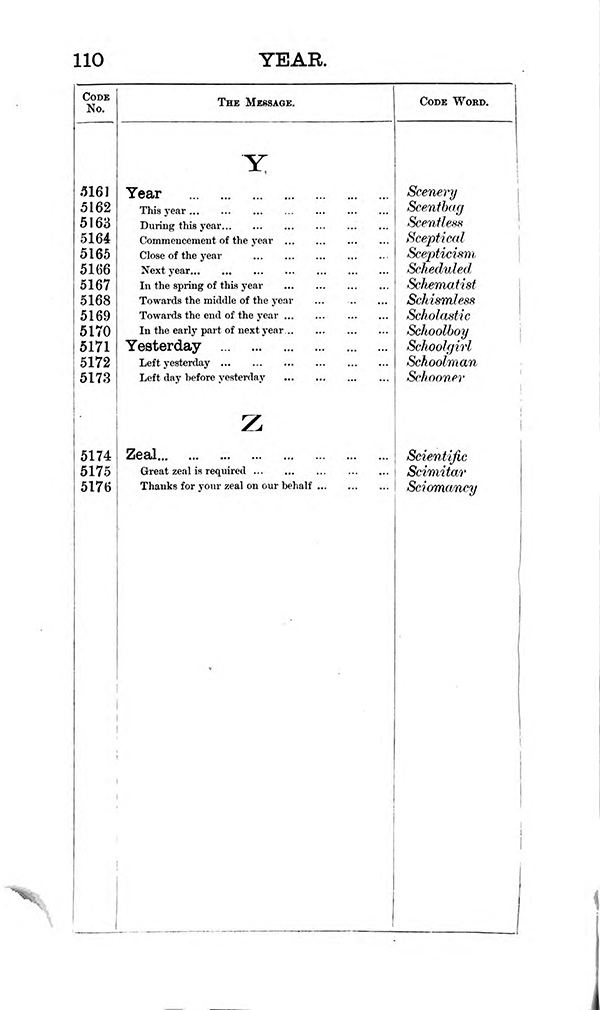
code pages 1 and 110
ex James Adam code (1881)
1810 Glowing / Eloped and 1811 Glowworm / Has eloped from this : link
1882
by Frank Miller (Sacramento, California)
New York: Charles M. Cornwell, 247 Pearl Street. 1882
LC copy HE7673 .M65
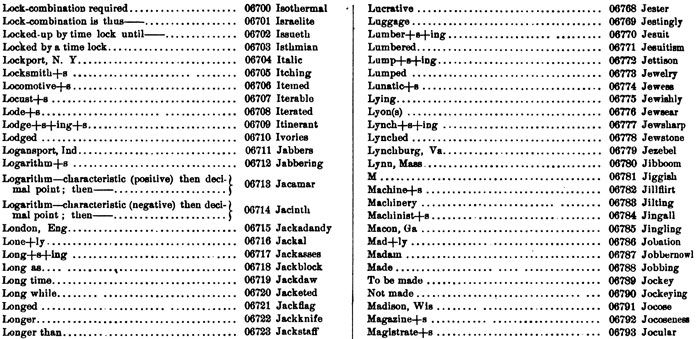
⬆
Detail, page 54 ex Miller, Telegraphic Code (1882)
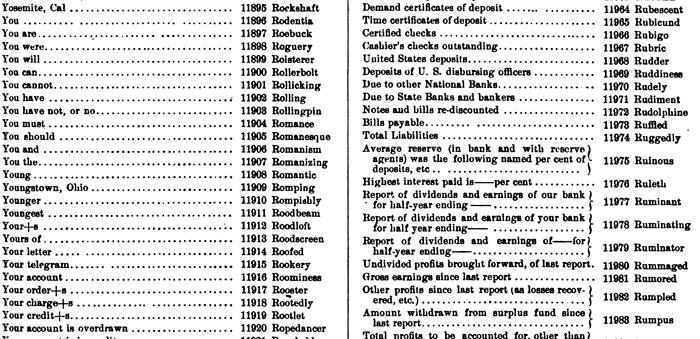
⬆
Detail, page 91 ex Miller, Telegraphic Code (1882)
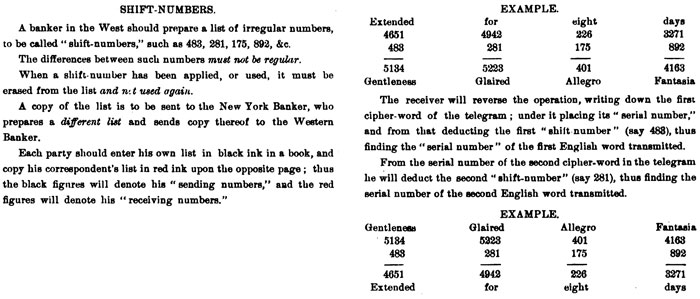
⬆
Detail from Preface (p4), ex Miller, Telegraphic Code (1882) (rearranged for this presentation)![]()
within Dirk Rijmenants’s “Cipher Machines and Cryptology” : link.
1882
for the use of mercantile firms and their agents and correspondents. with ciphers of ten letters or under, to conform to the Rules of the London International Telegraph Congress of 1879.
Compiled by H. R. Meyer. Liverpool and London, 1882
permalink (provides access to pdf) : link
1883
The Ship Owners’ Telegraphic Code 1880.
By E. B. Scott.
Reprint, with Supplement 1882 combined.
London: Published by the Author, at 2, Brabant Court, Philpot Lane, E.C.
Liverpool and London [1883 from internal evidence]
permalink (and access to pdf) : link
Preface : i-v
Alphabetical list (= index) : vi-xxiv
arrivals and sailings tables, at pp 124-125
e.g., Section 79, Ship’s Business & Stores
e.g., collisions; assistance and supplies; stranding & wreck; salvage, assistance &c.; pumps & divers; prospect of saving; condemnation, &c.; jettison, damage or loss of cargo; nature & cause of damage, etc., etc.
blanks pp 262-270
“vocabulary” here meaning, codewords in alphabetical order
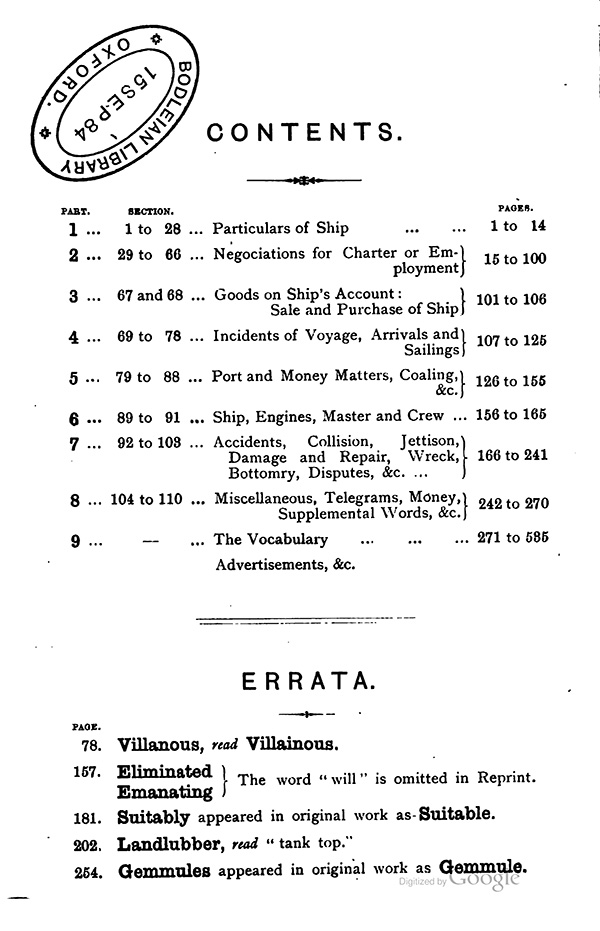
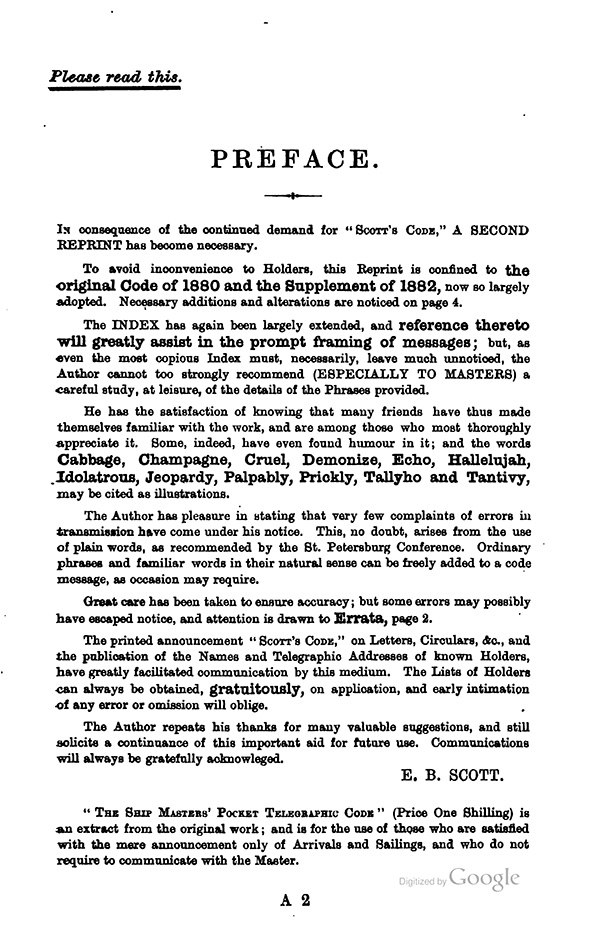
ToC, preface
ex Scott’s Code (1882, 1880) : link
two passages from the preface :
“...the Author cannot too strongly recommend (especially to Masters) a careful study, at leisure, of the details of the Phrases provided.”
and
“Some, indeed, have even found humour in it; and the words Cabbage, Champagne, Cruel, Demonize, Echo, Hallelujah, Idolatrous, Jeopardy, Palpably, Prickly, Tallyho and Tantivy, may be cited as illustrations.”
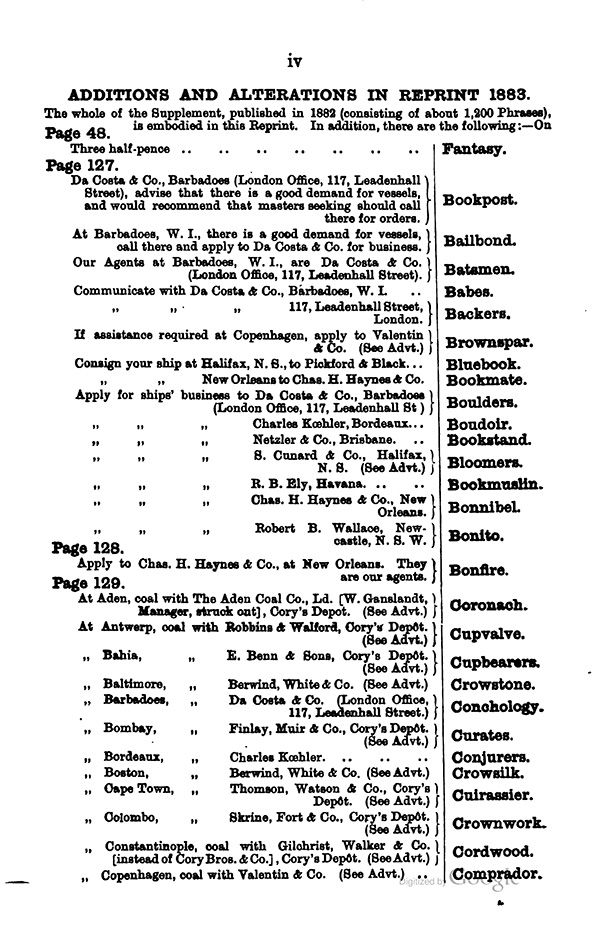
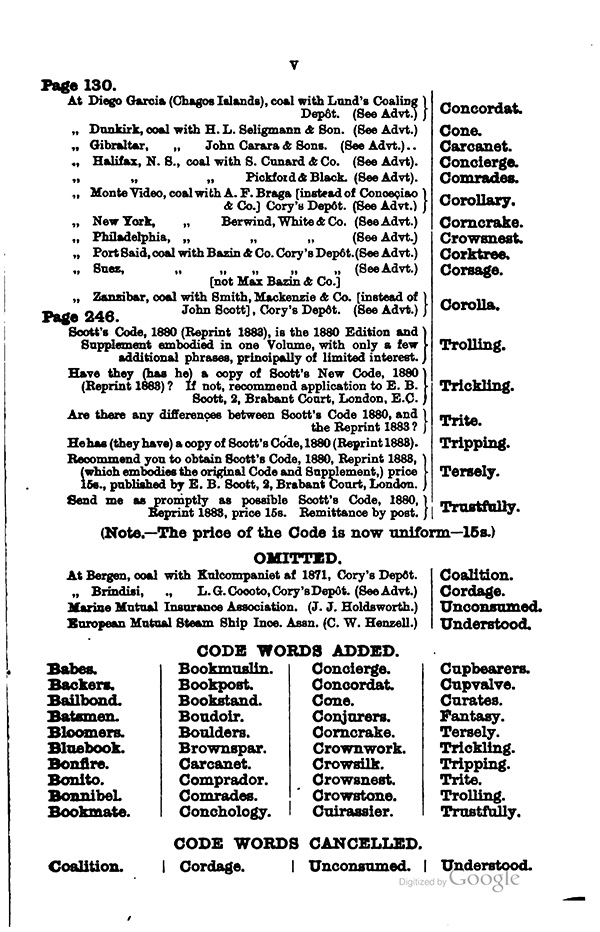
Additions and alterations in reprint 1883, pp iv and v
ex Scott’s Code (1882, 1880) : link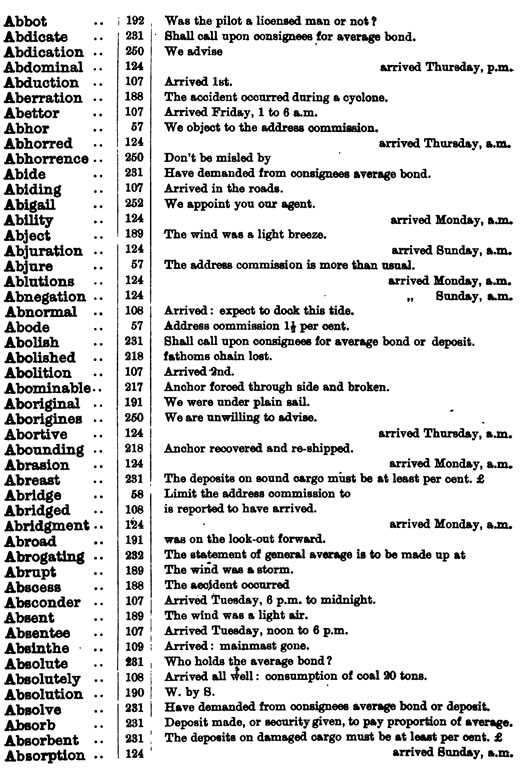
⬆
p272, Scott’s Code (1882, 1880)
1883
Preston, Kean & Co., Bankers
100 Washington Street, Chicago, Ill.
same (via hathitrust) : link
Amounts, 38; Character of Firms, 28; Chicago Banks, 35; Collections, 30; Commercial paper, 27; Correspondence, 32; Foreign Exchange, 25; Government Bonds and Miscellaneous Securities, 18; Land Warrants and Scrip, 21; Lost or Missing Drafts, 34; Municipal Bonds, 20; Purchase and Sale of Securities, 22; Rates, 40; Tranfers, Remittances, Etc., 36
Established in 1860, we have for twenty-three years transacted business as the custodians and conservators of the money of others.
The Chicago fire, and the various financial panics that resulted disastrously to so many banks, have passed over us without any interruption to the steady growth of our business...
p4
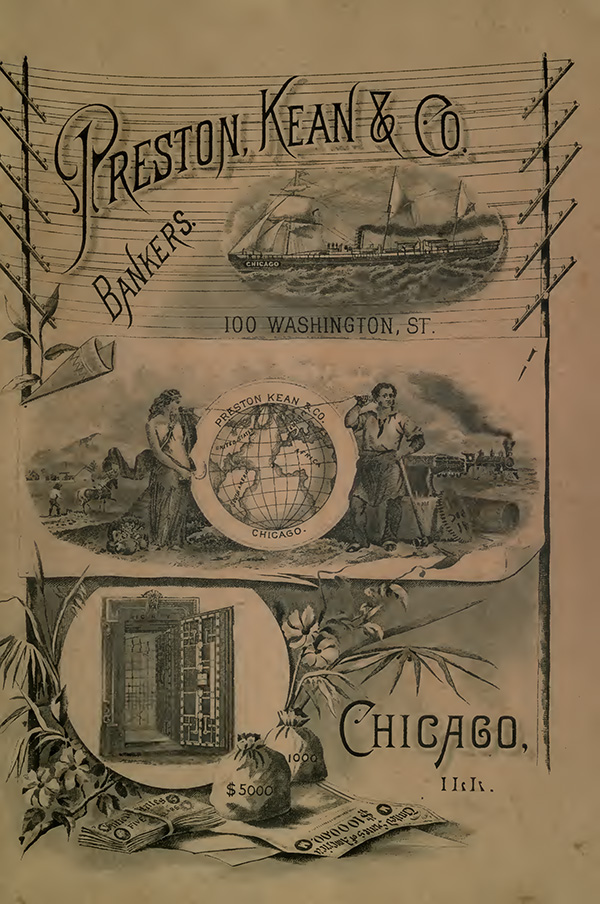
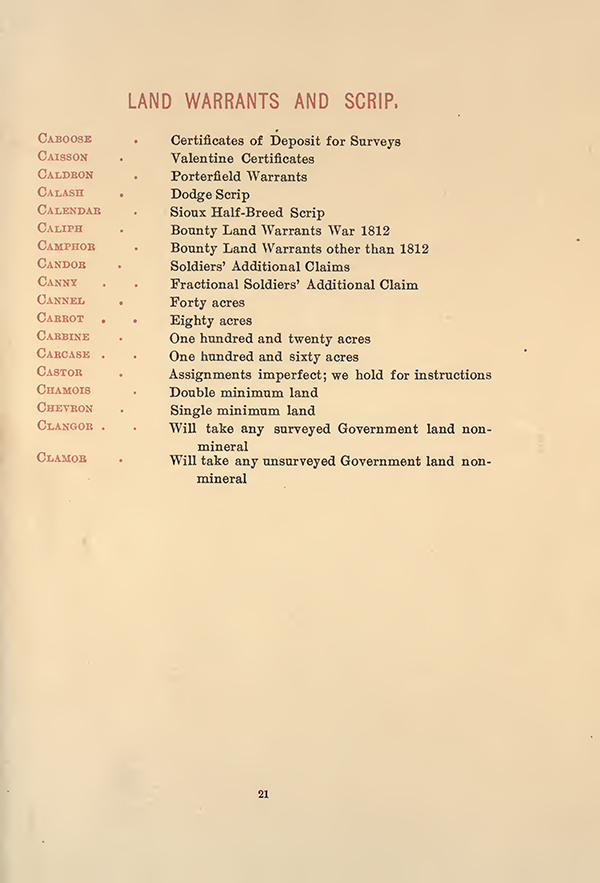
cover and p 21 (not spread)
ex Telegraphic Code Preston, Kean & Co., Bankers (1883)
1883
Specially compiled to meet the requirements of all branches of the mercantile profession throughout the world. On the two letter difference principle,in accordance with the Rules of the Telegraph Convention.
By E. Garsin
London: Wm. Dawson & Sons / New York: George Cumming, 1883
permalink (and access to [faulty, missing pages] pdf) : link
Index of roots, arranged according to last letters (=in terminal order) : viii-xv
The Morse alphabet : xvi (potential errors)
the code : 1-44 (number of two-page spreads, not pages)
(note : spreads 39-44 are not root and terminal, but codeword + blank)
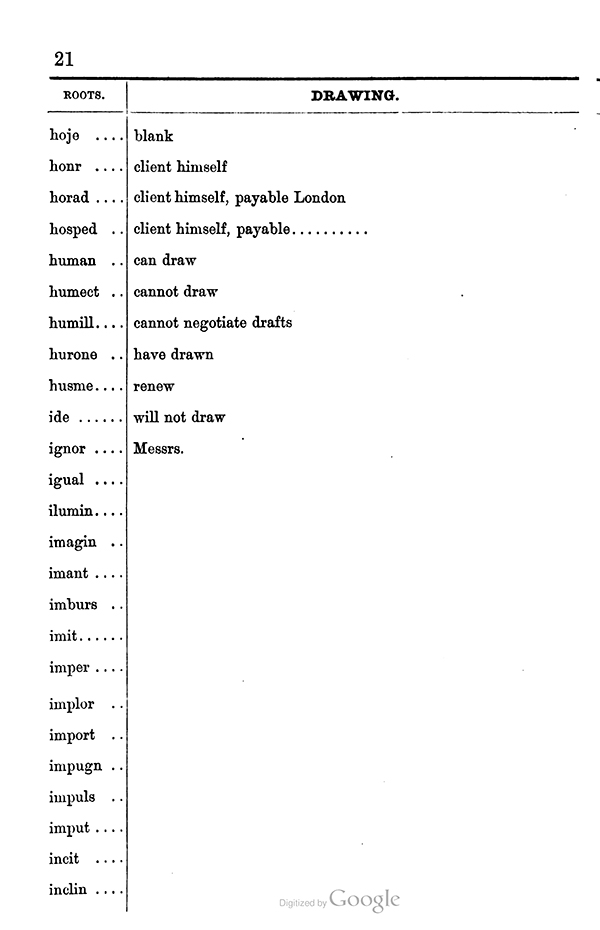
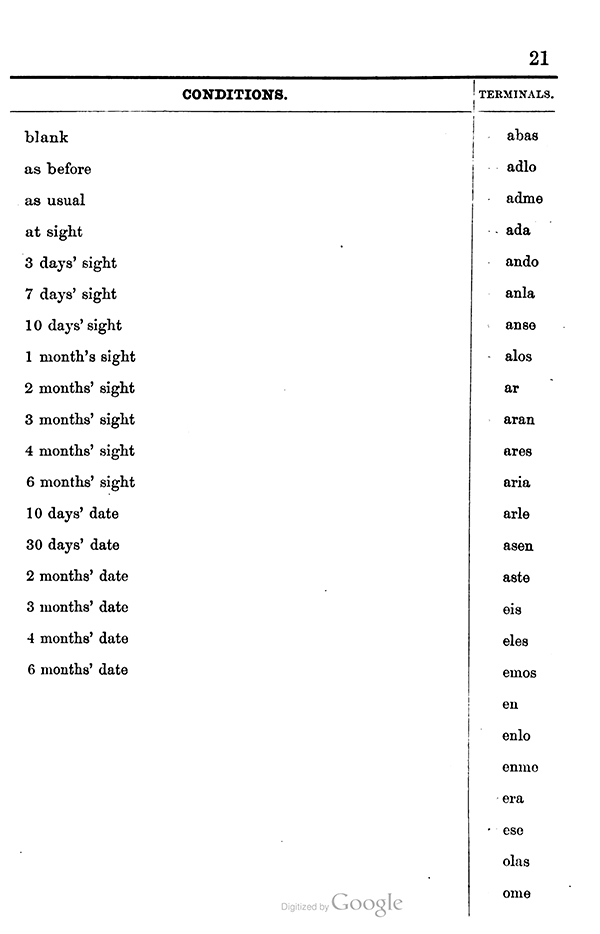
spread no. 21 (roots and terminals)
thus, honr + alos = client himself drawing, at one month’s sight
ex Garsin, The Globe Telegraph Code (1883)
1884
arranged for use with telegraphic codes, vocabularies, etc., etc., etc.
By Thomas S. Dunn
London: Waterlow & Sons Limited, Printers, London Wall, and 49, Parliament Street, 1884
permalink (and access to pdf) : link
1885
John Crossley & Sons, Limited. Halifax, England. 1885.
permalink (and access to pdf) : link
viii, 1-72pp; blank code pp 55-72
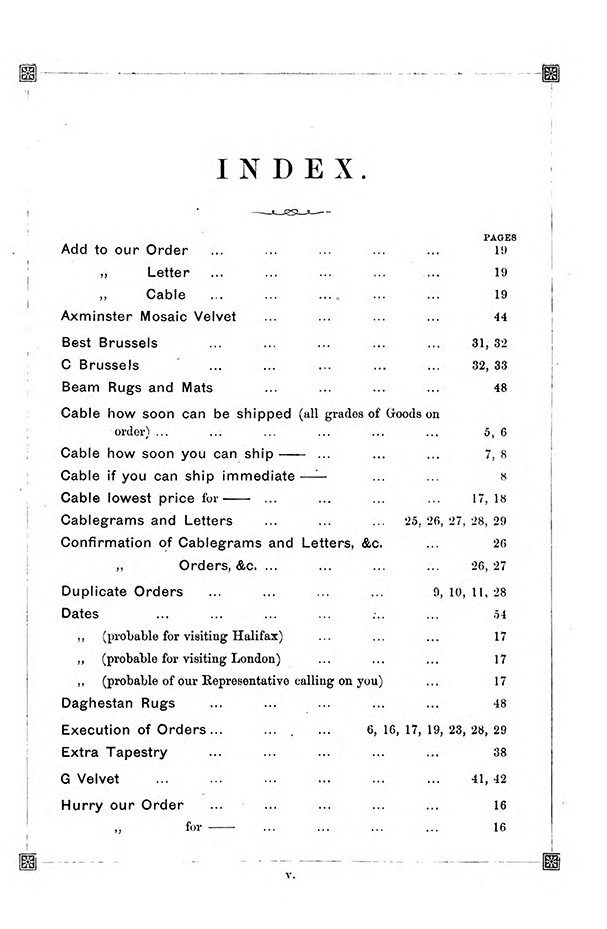
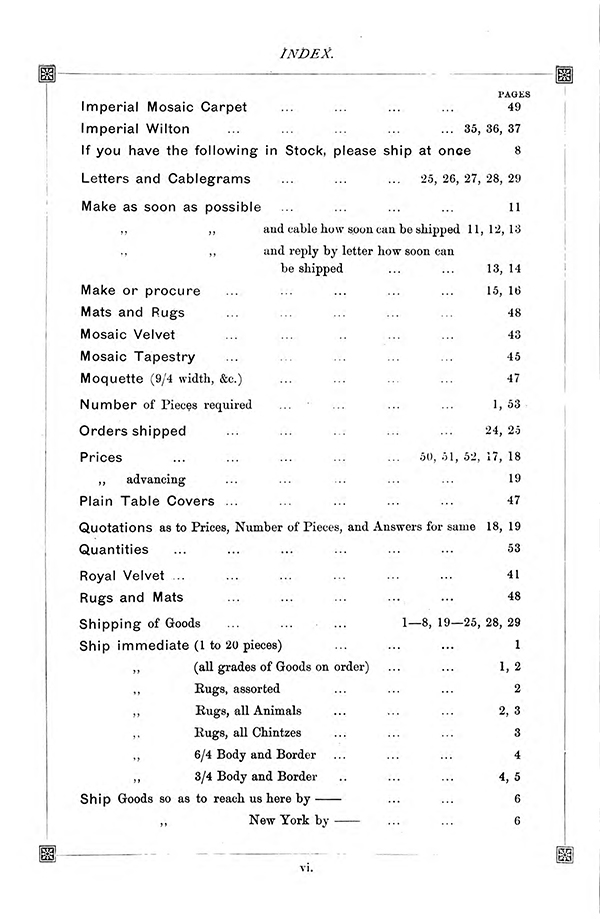
index, pp v-vi (not spread)
John Crossley & Sons Cable Code (1885)

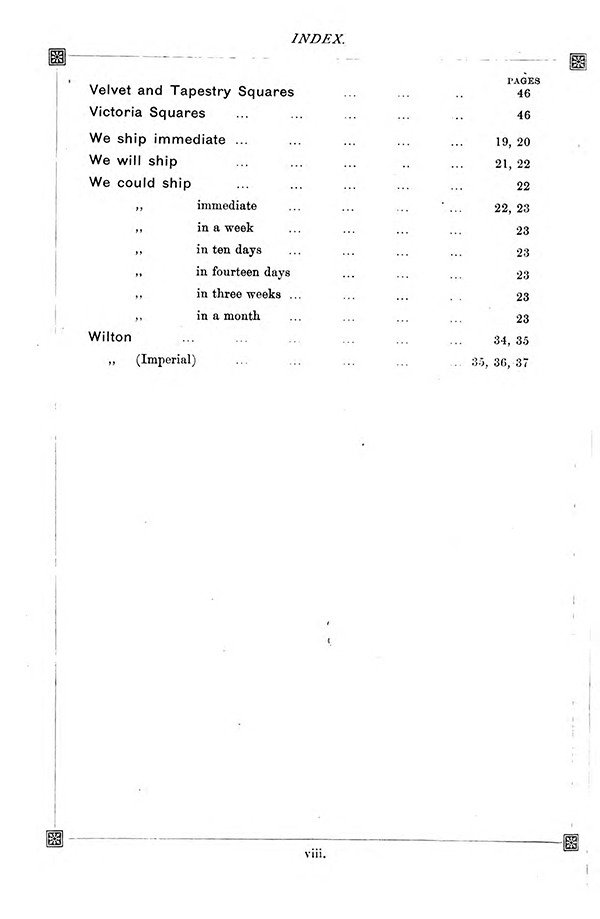
index, pp vii-viii (not spread)
John Crossley & Sons Cable Code (1885)


pages 16-17
John Crossley & Sons Cable Code (1885)
1885
The Ship Owners’ Telegraphic Code (1885 “sixth edition” edition)
permalink (and access to pdf) : link
Part Second, Negociations for charter or employment : 16-108
Third Part, Goods on ship’s account; sale and purchase of ship : 109-114
Part Fourth, Arrival (etc) : 115-136
Part Fifth, Port and money matters : 137-177
Part Sixth, Ship, engines, master and crew : 178-189
Part Seventh, Accidents : 190-277
Parth Eighth, Miscellaneous : 278-
Part Ninth, The Vocabulary : 315-621
1885
Compiled by W. G. Press & Co. Chicago. (for the exclusive use of themselves and their correspondents.
Chicago: Press of Cameron, Amberg & Co., 1885.
same (via hathitrust) : link
note : described as comprised of “chiefly tables” but no x-y tables within.
Grain (mainly) and pork; trade, commission.
Index and specimen pages below.
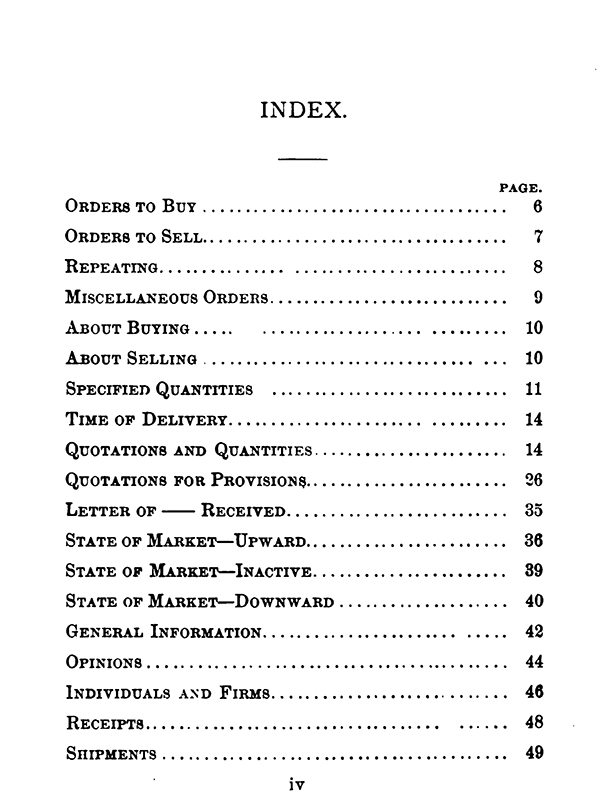
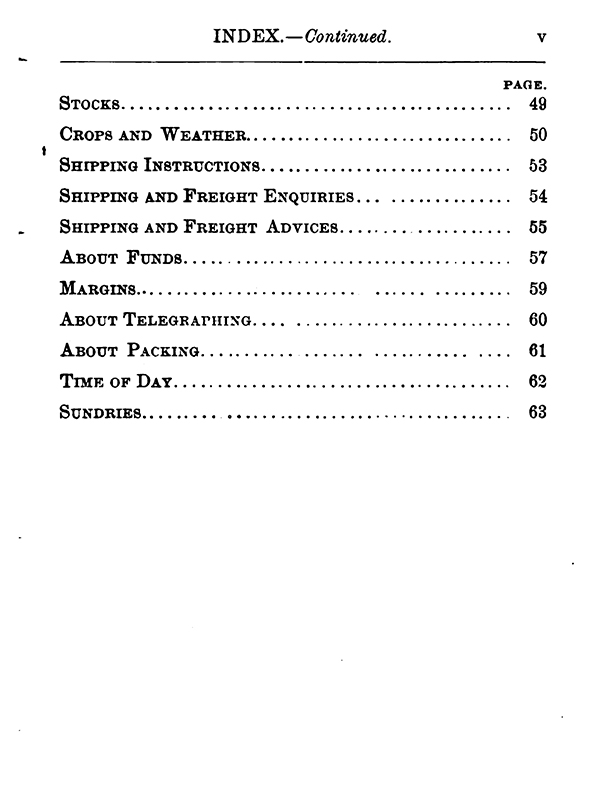
pp iv-v, W. G. Press Telegraphic Cipher (1885)
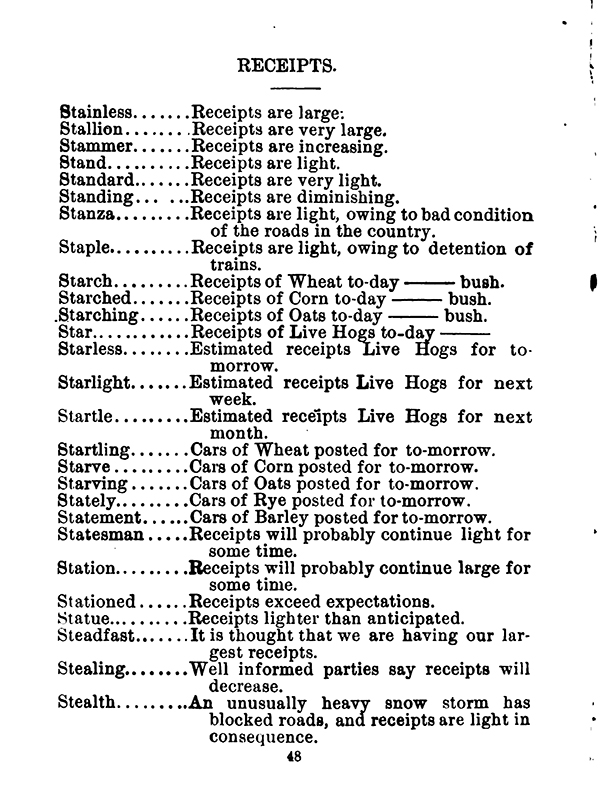
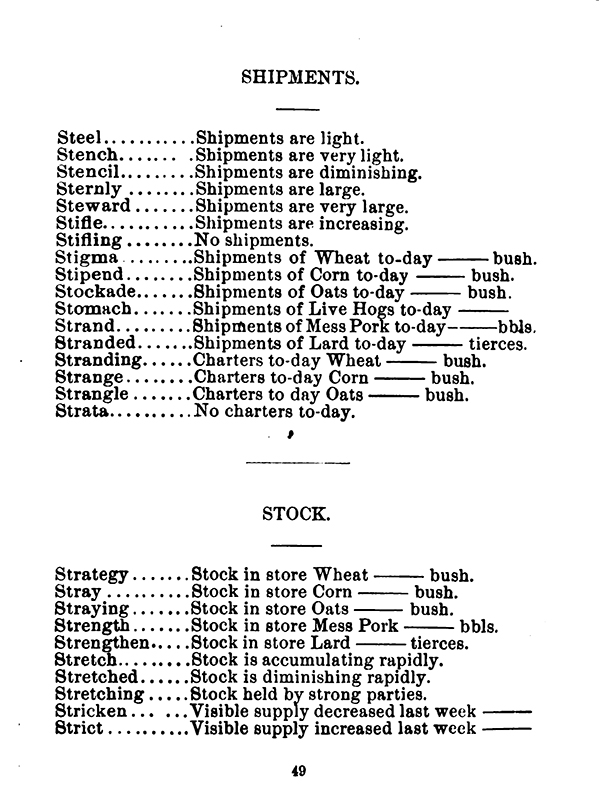
pp 48-49, W. G. Press Telegraphic Cipher (1885)
1885
Containing more than 300 one-word telegrams.
London: W. H. Beer & Co., 1885
permalink (and access to pdf) : link
Absence from Home; Appointments; Betting; Bookseller; Bootmaker; Buying and Ordering; Cabs and Carriages; Calls; Dinner, Not Coming Home, Bringing Friends Home, &c.; Dressmaker; Gunmaker; Health, Questions and Answers Concerning; Houses, Hotels and Apartments; Invitations, Giving and Receiving; Legal Proceedings; Letters, Sending, to be Called for, &c.; Livery Stable Keeper; Milliner; Money, Telegraphing for, Transmitting; Pastry Cook; Physician or Surgeon; Servants, Engaging &c.; Tailor; Telegrams on Business (Agents and Correspondents); Theatres and Concerts, Taking Seats for; Washerwoman; Weather.
Zymo / Better not cross to-day.
1885
Scott’s Concise Commercial Code of General Business Phrases
By E. B. Scott. Author of “The Ship Owners’ Telegraphic Code.”
London, published by the author.
permalink (and access to pdf) : link
The figures are described as “carefully selected” and run : 12345 12346 12347 12348 12349 12351... (no zero’s, and no figures repeated in a single group)
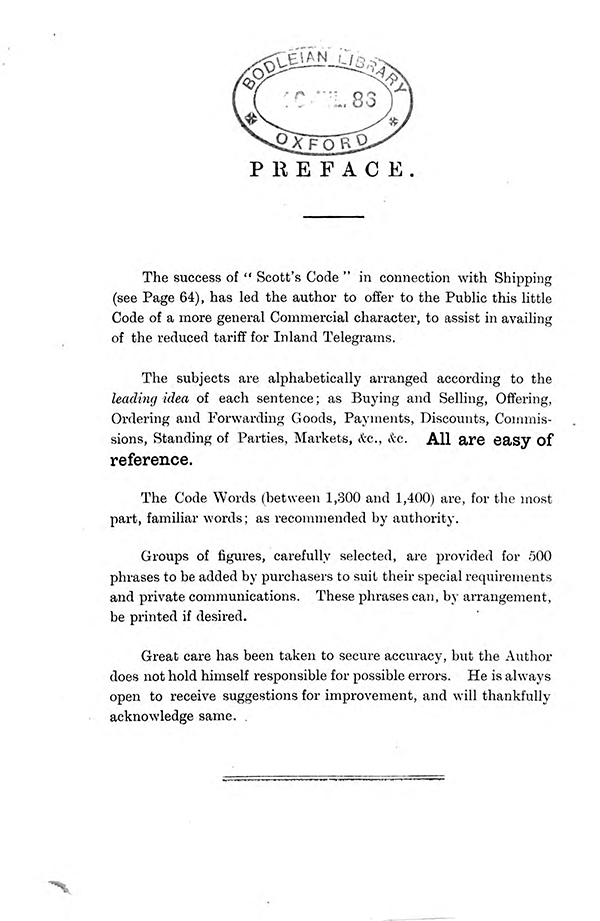
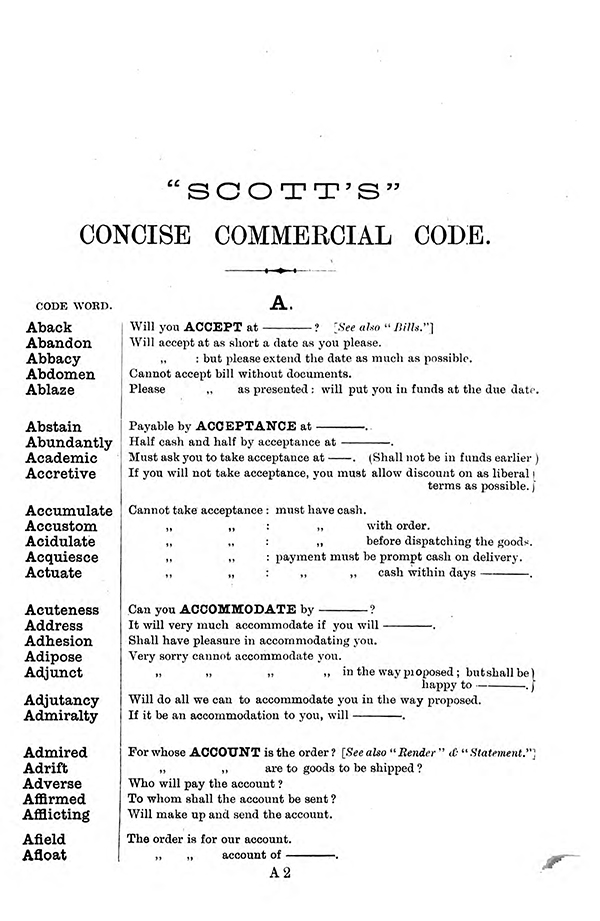
preface and facing page 3, Scott’s Concise Commercial Code of General Business Phrases (1885)
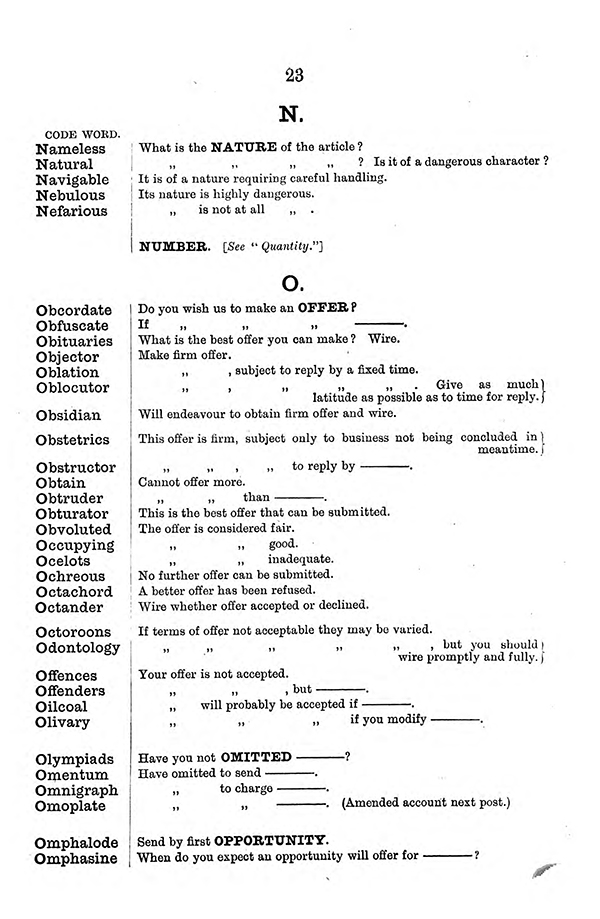

pages 23 and 34 (not spread), Scott’s Concise Commercial Code of General Business Phrases (1885)
1885
ex The American Florist, A Semi-Monthly Journal for the Trade 1:7 (November 15, 1885) : 1
Abrogate. In case you cannot fill order, telegraph at once. Anticipate. Answer at once, stating whether you can or cannot fill order. Ambition. If you can only partially fill order, do so, and reply, stating what. Ambulance. Want all of order filled or none, and prompt answer back. Admiral. Order must be sent on train mentioned only. Adjacent. If cannot send on train mentioned next one will do. Affection. Fill if possible, even at extra expense. Affable. Send prepaid by baggage master, if no express messenger on train. Ancestor. This order is in addition to my regular order. Admission. This order is a substitute for my regular order. Decorate. If cannot send all on train mentioned, send all you can, and send balance on next train. Dancing. If cannot fill exactly as specified, you may substitute according to your best judgment. Durable. These flowers are for funeral purposes and colored flowers must not be substituted for white. Fabricate. Flowers ordered are to be reshipped to a distance, therefore buds must be cut specially close. Fortunate. Select extra stock and charge accordingly. Devotion. For cheap work, and can use second-class flowers if at reduced price. Flattery. If price has advanced since last quotation do not send goods, but telegraph. Forgery. This order countermands all previous orders. Fandango. This order to be duplicated daily till further notice. Formation. Add these items to the order which you already have, but in case first order is already shipped, cancel this addition. Flamingo. We are In a bad pinch; send us something to help us out, even If of poor quality. Flocking. Have sent mail order; if not yet received, send following at once, and cancel mail order when received. Foraging. This order includes all items previously ordered and wanted for this date.
1885
The Stock Exchange Speculators’ Guide to Cheap Telegrams compiled expressly for the use of stock brokers & their clients, by F. W. Spalding.
permalink (and access to pdf) : link
“...For convenience of referrence [sic] it has been divided into two Parts: — the firt part being adapted to the use of speculators and the second to that of the Brokers.”
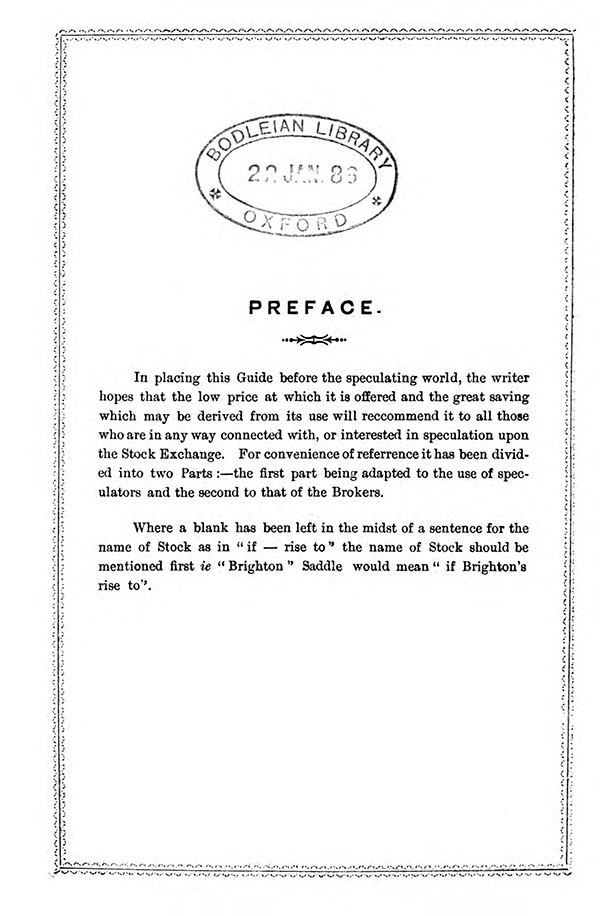
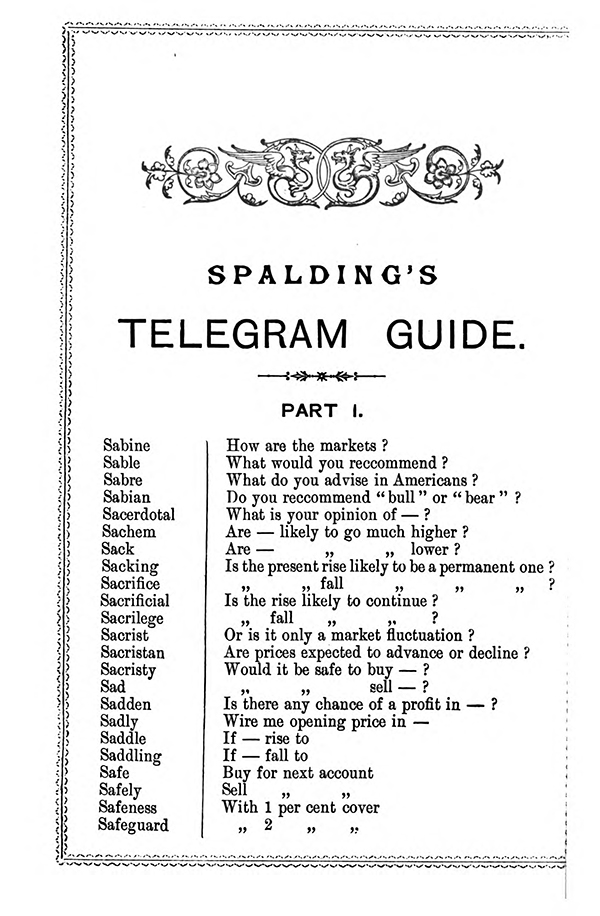
preface and (facing) p3, Spalding’s Telegram Guide (1885)

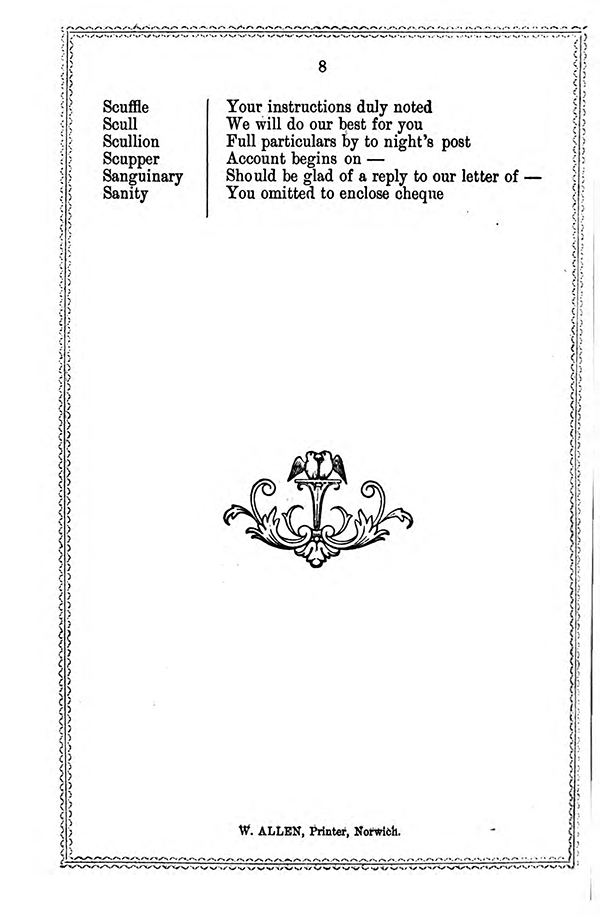
pages 5 and 8 (not spread), Spalding’s Telegram Guide (1885)
1887
in Publishers’ Weekly 32:5 (Educational Number; July 3, 1887) : 133
same (via hathitrust) : link
the first and second being the first two letters of the author’s or series’ name... ;
the third and fourth the designation of the book by that author or in that series;
the fifth and sixth the abbreviation of the publisher.”
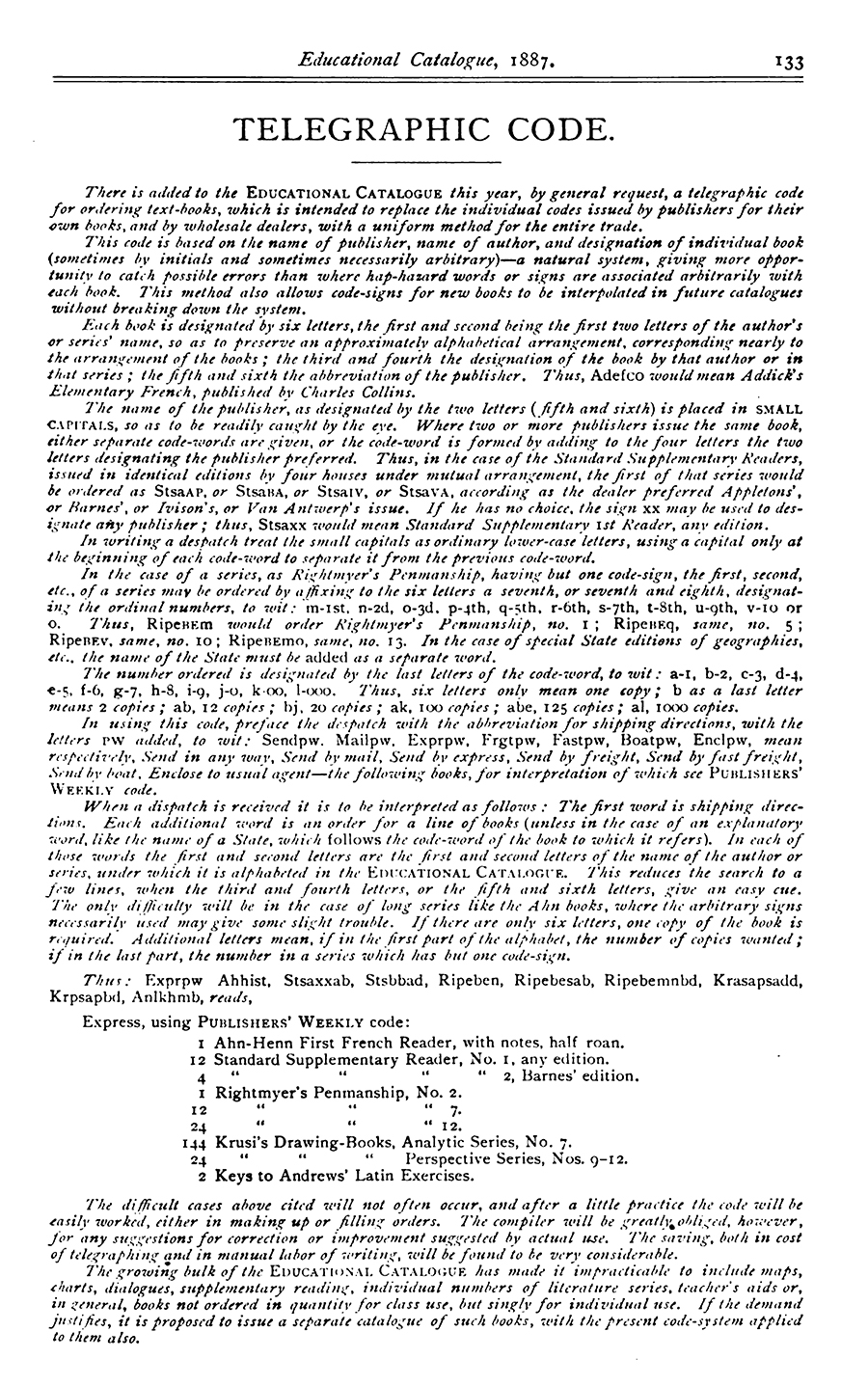
Telegraphic Code, The American Educational Catalogue (1887)
1887
Compiled by Benjamin Graham. c1883. Third Edition 1887
John C. Hartfield & Son., Printers and Publishers of Cable Codes, 6 South William Street and 207 Fulton Street, New York.
same (via hathitrust) : link
code pp 1-101
“Appendix” of spare codewords, pages 1-10, Forgives > Fruticious.
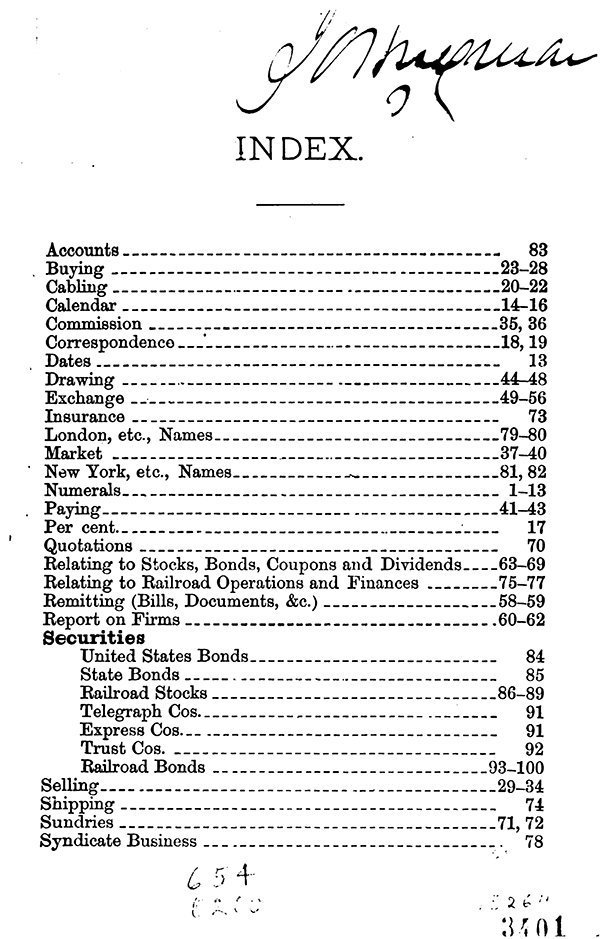
⬅
Index. Private code, John Paton & Co. (1883; third edition 1887)

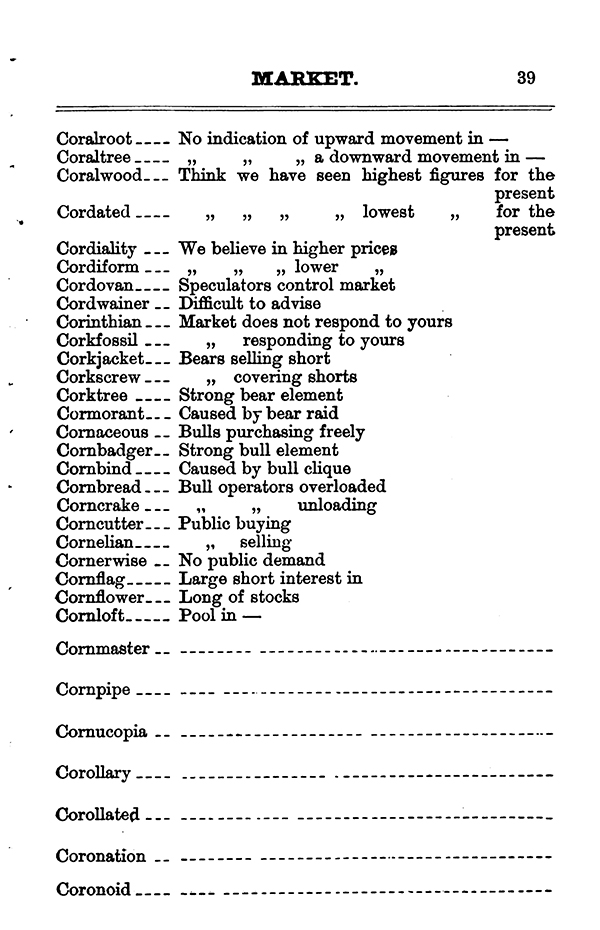
pages 38-39. Private code, John Paton & Co. (1883; third edition 1887)
1888
by Robert Slater, Secretary of the Socièté du Cable Transatlantique Français, Limited.
Third Edition. London: W. R. Gray, 1888
1888
Pour réduire le coût des Télégrammes et en assurer le secret, par A(rmand). Coste
Paris: A l’Administration du Code Télégraphique Français, 1888
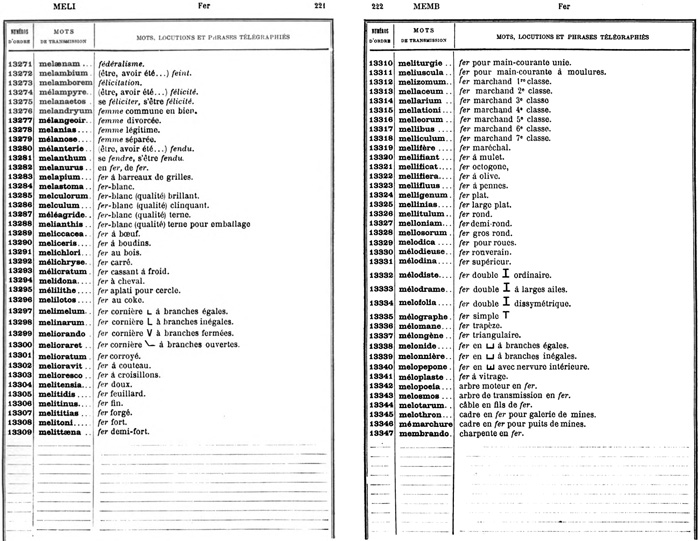
successive pages 221, 222 (not spread)
Code Télégraphique Français (1888); note diagrammatic shapes (detail below)
One finds code for marks/shapes also in cotton codes (indicating “marks” on bales, other packaging.
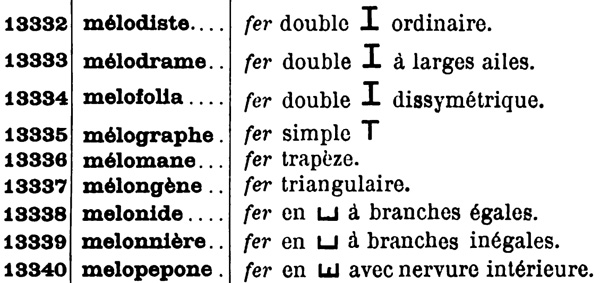
⬆
detail, p222 Code Télégraphique Français (1888)
Table of contents —
- Première Partie : Nombres et Quantités
Nombres abstraits (entiers et fractionnaires) 1
Numéros de 1 à 1,000 11
Sommes en francs et centimes 19
Sommes en piastres et cents (centimes et piastres) 23
Sommes en livres sterling, shellings [sic] et pence 27
Nombre de mètres, centimetres et milimètres 31
Nombres de kilomètres 41
Nombres de millimètres carrés 43
Nombres d’hectares 47
Nombres de litres 49
Nombres de mètres cubes 51
Nombres de kilogrammes 53
Nombres de tonnes (de 1,000 kilogr.) 55
Taux pour cent 57
Dates (du 1er janvier au 31 décembre) 61
Dates (Millésimes de 1790 à 1980) 65
Longueurs des barres métaliques 67
Longueurs des plaques ou feuilles métalliques 69
Largeurs des barres & plaques métaliques 71
Epaisseurs et diamètres des barres, plaques et fils métaliques 73
Mots disponibles pour nombres, quantités et mesures 75 - Deuxiéme Partie : Code Génèral 79
here begin selections of Mots, locutions et phrases télégraphiés 81
8001 / gabaliorum / abaissement — (note, handwritten notes here and throughout the phrase section)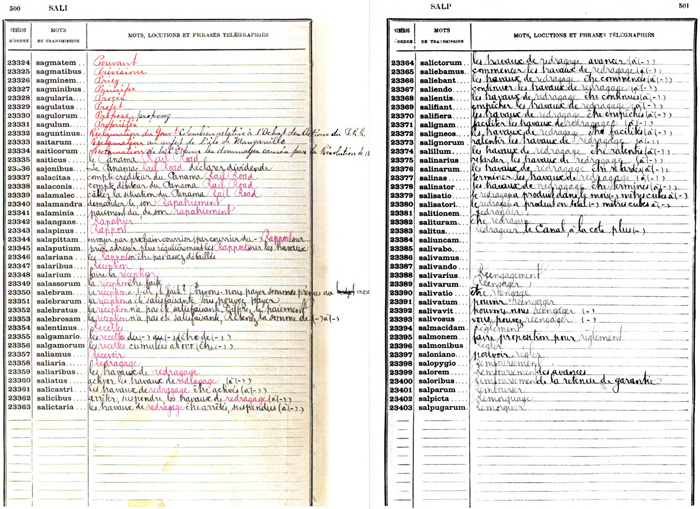
⬆
pp500-501, Code Télégraphique Français (1888)Dépêches spéciales pour la banque / la bourse et la commission 517
- Troisième Partie : Tables Géographiques / Administrations et services publics / fonctionnaires 563
Tables Géographiques 565
Noms de villes 571
Administrations et services publics / fonctionnaires 581
- Quatrième Partie : Personnages et Établissements Divers / Journaux et revues / Tables syllabétiques 605
Personnages politiques 607
Établissements financieres et industriels / maisons de commerce et individus 610
Journaux et revues 614
Table Syllabétique 617Example below left shows syllabic s-p-e-l-l-i-n-g of a name; page at right shows codewords for first syllables in alphabetical order.
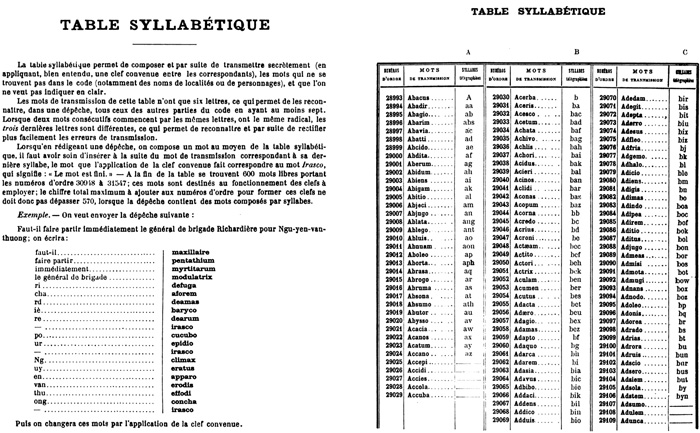 ⬆
⬆
successive pages (not spread) pp617-618, Code Télégraphique Français (1888)Mots disponibles / A l’usage des clefs employ´es pour chiffrer des depéches 633
Alphabet Morse 637
Table des matières 639Followed by 11 pages of advertisements.
| 1889
Clave telegráfica-telefónica mercantile arreglada para el uso del comercio U Michigan copy/scan (via google books) : link instructions pp 3-4; code pp 5-377; index pp 379-380 |
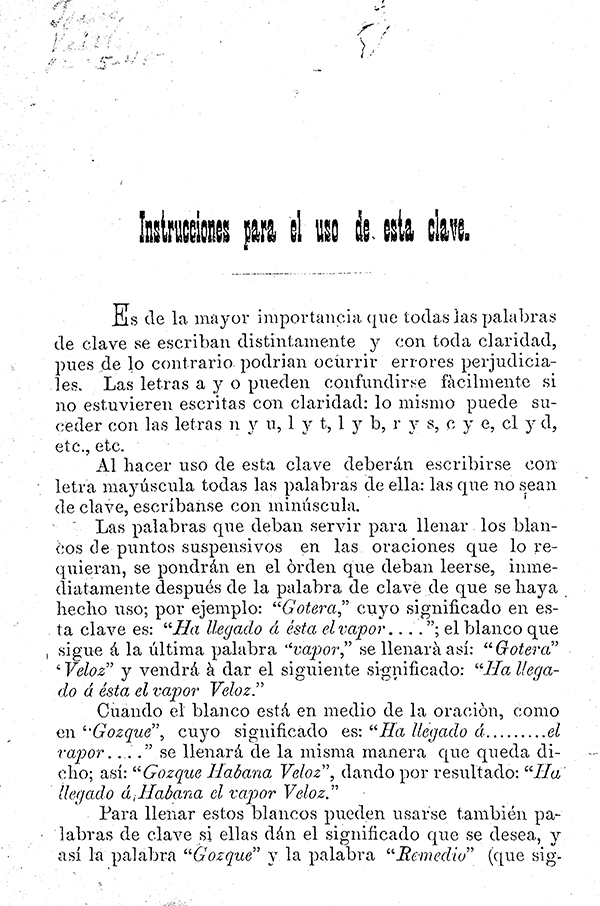 |
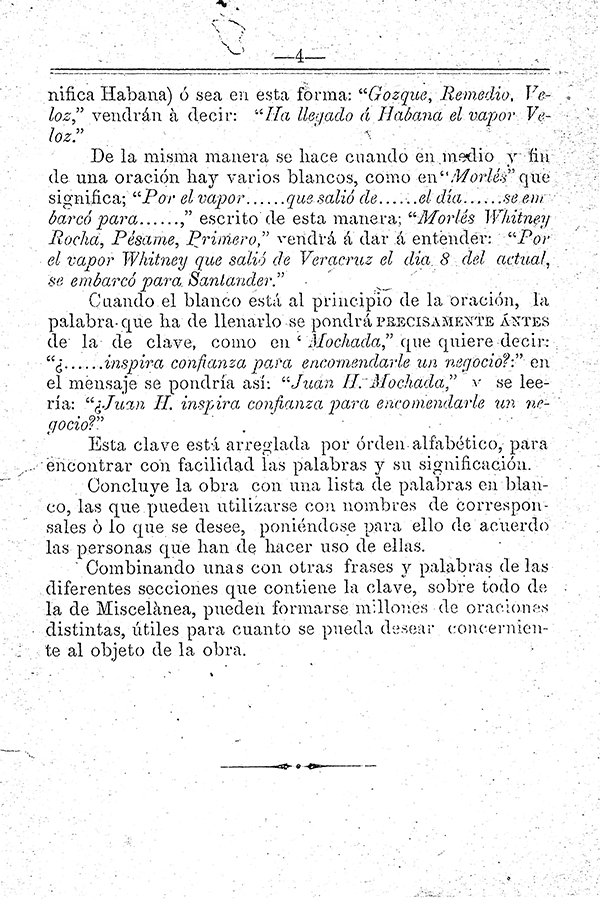 |
⬆
instructions, pp 3-4. Clave telegráfica-telefónica mercantile (second edition, 1889)
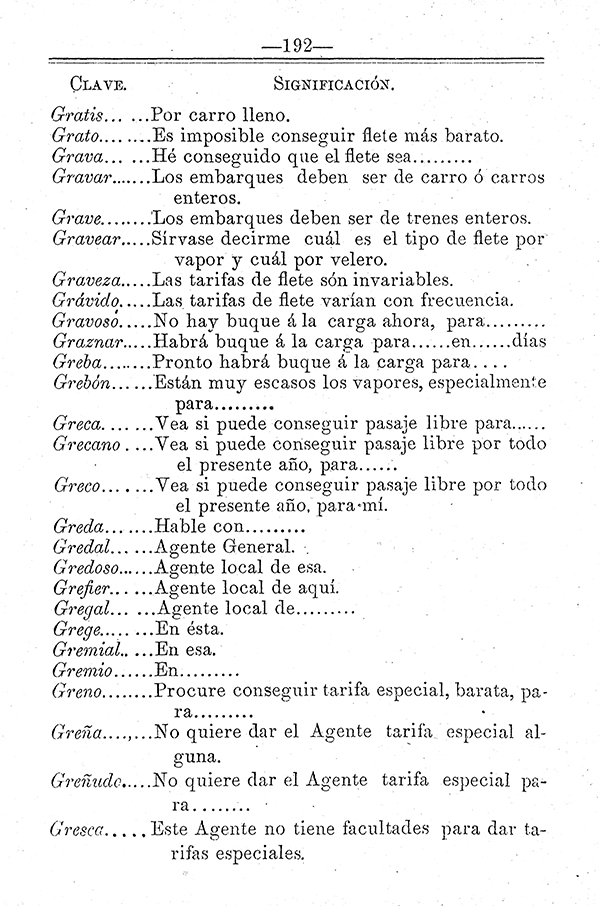 |
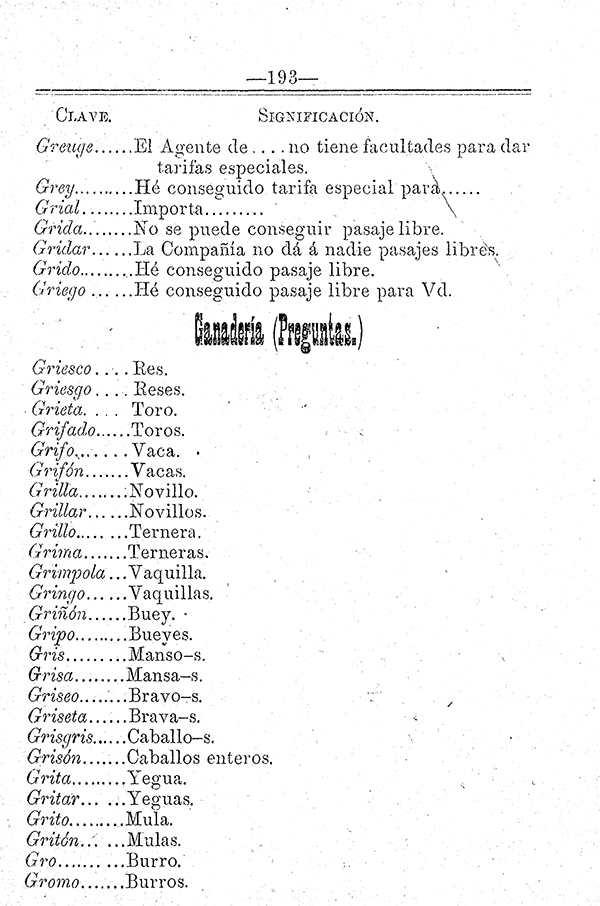 |
⬆
pp 192-193 : freight (replies); livestock (queries)
Clave telegráfica-telefónica mercantile (second edition, 1889)
![]()
Index (=ToC) : pp379-380 (provisional translation below)
| Nombres y definición de la Mercancías | 1 | names and definitions of goods |
| Empaques y clases | 16 | packaging and classes (or qualities) |
| Preguntas sobre cosechas | 25 | questions about crops |
| Respuestas sobre cosechas | 27 | answers about crops |
| Existencias y entradas al mercado (Preguntas) | 39 | stocks & market entries (queries) |
| Informe sobre existencias y entradas al mercado | 41 | report on stocks & market entry |
| Consümo y ventas (Preguntas | 57 | consumption & sales (queries) |
| Consumo y ventas (Respuestas) | 66 | consumption & sales (replies) |
| Compras (Preguntas) | 87 | shopping [?] (queries) |
| Compras (Respuestas) | 97 | shopping [?] (replies) |
| Muestras (Preguntas) | 124 | samples (queries) |
| Muestras (Respuestas) | 127 | samples (replies) |
| Consignaciones, embarques y fletes (Preguntas) | 131 | consignment, shipping and freight (replies) |
| Consignaciones, embarques y fletes (Respuestas) | 134 | consignment, shipping and freight (replies) |
| Clases y colores (Preguntas) | 139 | classes & colors (queries) |
| Clases y colores (Respuestas) | 139 | classes & colors (replies) |
| Importaciones y Exportaciones (Preguntas) | 142 | imports and exports (queries) |
| Importaciones y Exportaciones (Respuestas) | 143 | imports and exports (replies) |
| Mercado al día (Preguntas) | 145 | market day (queries) |
| Mercado al día (Respuestas) | 147 | market day (replies) |
| Adición á consumo, compras y ventas (Pgtas.) | 151 | addition to consumer purchases and sales (queries) |
| Adición á consumo, compras y ventas (Rptas.) | 154 | addition to consumer purchases and sales (replies) |
| Comisión y Corretaje (Preguntas) | 157 | commission & brokerage (queries) |
| Comisión y Corretaje (Respuestas) | 158 | commission & brokerage (replies) |
| Seguro (Preguntas) | 161 | certain [?] (queries) |
| Seguro (Respuestas) | 163 | certain [?] (replies) |
| Cambios, giros y remesas de fondos (Pregunta) | 169 | exchange, transfers and remittances (queries) |
| Cambios, giros y remesas de fondos (Rptas.) | 173 | exchange, transfers and remittances (replies) |
| Fletes (Preguntas) | 186 | freight (queries) |
| Fletes (Respuestas) | 187 | freight (replies) |
| Ganadería (Preguntas) | 193 | livestock (queries) |
| Ganadería (Respuestas) | 198 | livestock (replies) |
| Telegramas (Preguntas) | 207 | telegrams (queries) |
| Telegramas (Respuestas) | 209 | telegrams (replies) |
| Cartas (Preguntas) | 215 | letters (queries) |
| Cartas (Respuestas) | 217 | letters (replies) |
| Para conocer si una plaza es buena (Preguntas) | 223 | to know if a place is good (queries) |
| Para conocer i una plaza es buena (Rptas.) | 224 | to know if a place is good (replies) |
| Miscelanea | 228 | miscellaneous |
| Operaciones Bancarias (Preguntas) | 253 | banking (queries) |
| Operaciones Bancarias (Respuestas) | 262 | banking (replies) |
| Opiniones | 272 | opinions |
| Capital, crédito, pagos y quiebras (Preguntas) | 276 | capital, credit, payments and bankruptcy (queries) |
| Capital, crédito, pagos y quiebras (Respuestas) | 279 | capital, credit, payments and bankruptcy (replies) |
| Filiación personal | 290 | personal attributes |
| Documentos y Libros | 294 | documents & books |
| Noticias de sensación (Preguntas) | 297 | “sense of the news” (queries) |
| Noticias de sensación (Respuestas) | 299 | “sense of the news” (replies) |
| Números | 302 | numbers |
| Tanto por ciento | 315 | percentages |
| Meses | 319 | months |
| Horas | 319 | hours |
| Fechas | 320 | dates |
| Años, meses y dias | 321 | translation |
| Monedas, pesas y medidas | 322 | coins, weights & measures |
| Divisiones de la Tierra y puntos cardinales | 341 | divisions of land, points of the compass |
| Divisiones del Agua | 342 | water divisions |
| Naciones y Ciudades principales (Europa) | 342 | countries and principle cities (Europe) |
| Naciones y Ciudades principales (Asia) | 358 | countries and principle cities (Asia) |
| Naciones y Ciudades principales (África) | 360 | countries and principle cities (Africa) |
| Naciones y Ciudades principales (América) | 362 | countries and principle cities (Americas) |
| Naciones y Ciudades principales [Oceanía] | 373 | countries and principle cities (Oceania) |
| Alfabeto para marcas y lista de palabras en blanco | 374 | Alphabet for brands and blank word list |
| 1889
telegraphic cipher Written and compiled by W. H. Miner; San Francisco (?), 1889 (?) U California (HD 9195 B72 M52 1889 BANC) copy/scan (via openlibrary.org) : link (opens to telegraphic cipher) telegraphic code a separate section, pages 53-78 |
contents
Introduction (7); Early History of Coffee (12); The Coffee Plant and its Cultivation (19); The Berry and the Bean (21); Harvesting and Preparation (25); Miner’s Mills — Coffee Roasting (29), Coffee Grinding (31), Spice Department <32), Packing Department (33); Miner’s Coffee Hulling and Cleaning Establishment (35); Medical and Dietetic Properties of Coffee (37); Statistical Tables (46); Coffee Shrinkage Table (49); followed by telegraphic cipher, “compiled and in use by W. H. Miner” —
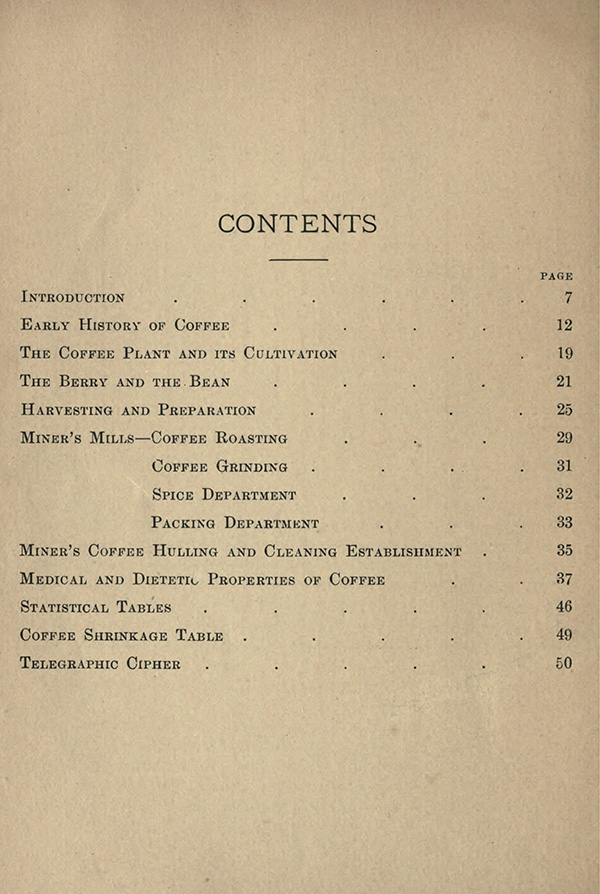 |
⬅ Index (left), and contents of telegraphic cipher (below) Brief Sketch Of Miner’s Coffee and Spice Mills (1889) Price of Coffee (53) |
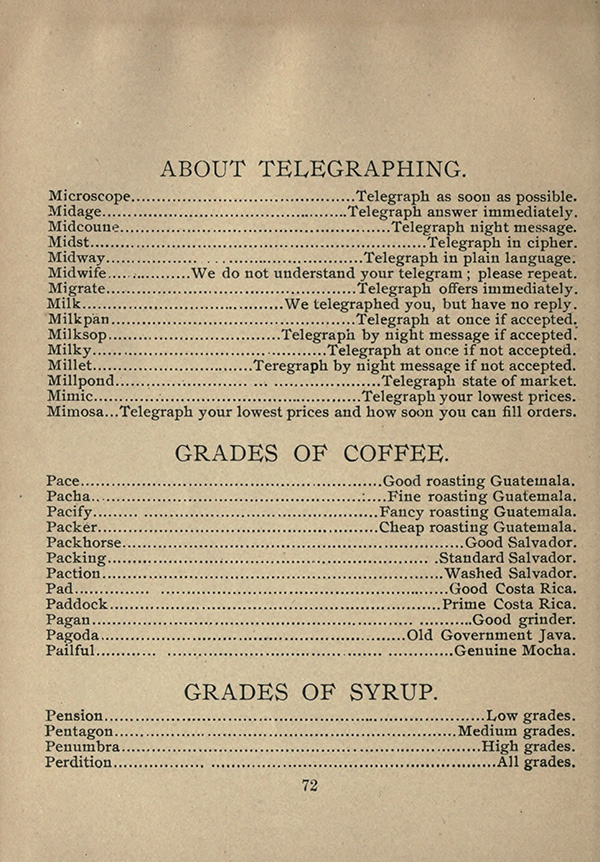 |
 |
⬆
pages 72-73, Brief Sketch Of Miner’s Coffee and Spice Mills (1889)
note : most of the code is figures, for prices, numbers, amounts.
| 1889, 1896
“Unicode” The Universal Telegraphic Phrase-Book. U Michigan copy/scan (via google books) : link social code between 102-103, is unpaginated sheet (both sides), two columns of codewords (Antitodum — Siquando), headed by “The following cypher words have been added to ‘Unicode’ since its first publication.” |
| 1896
“Unicode” The Universal Telegraphic Phrase-Book. U Michigan copy/scan (via hathitrust) : link social code same as 1889, but reformatted and with revised (updated) list of users. |
selected pages (from Michigan copy/scans) shown below.
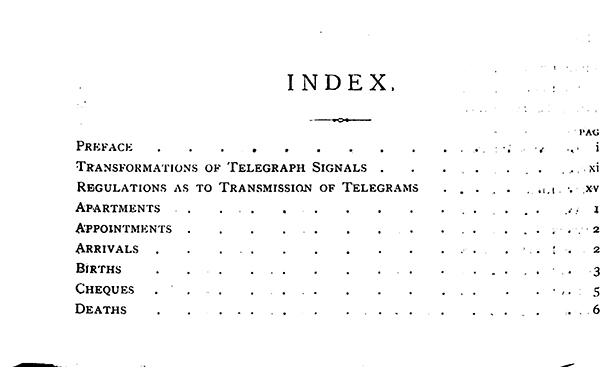 |
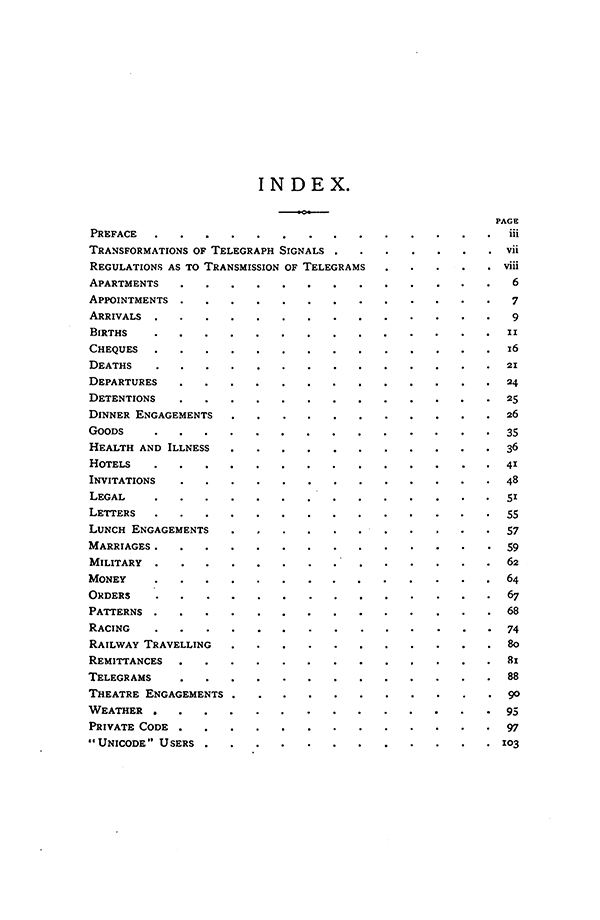 |
 | |
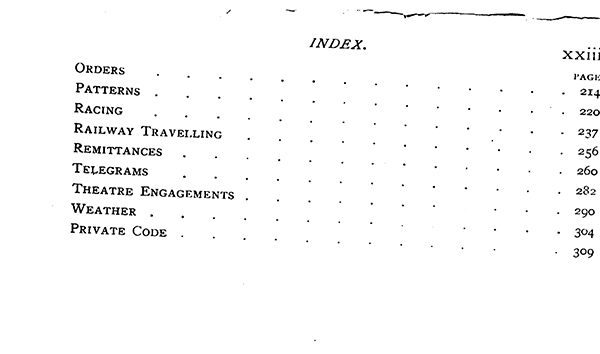 |
⬆
index, “Unicode” (1896, at left; 1889, at right)
 |
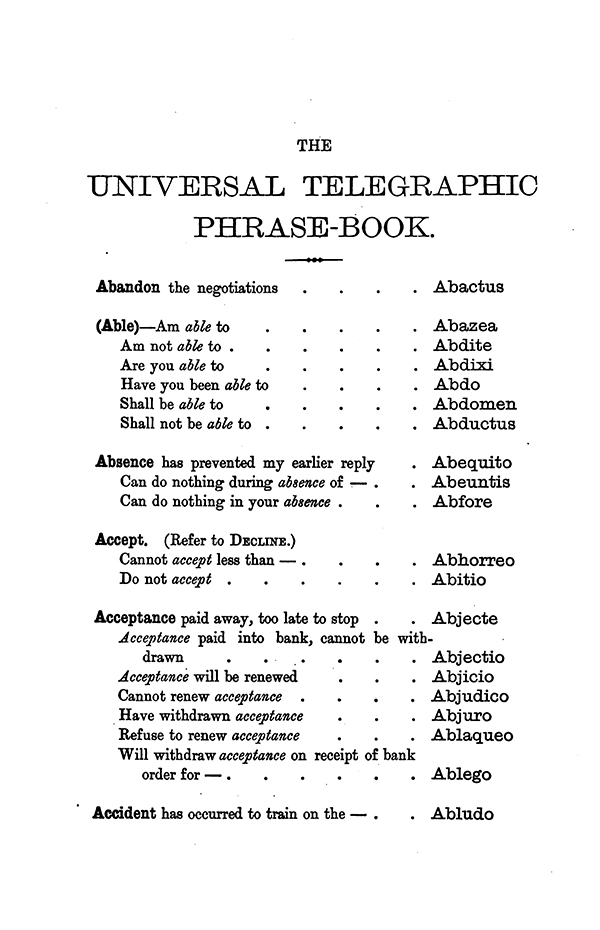 |
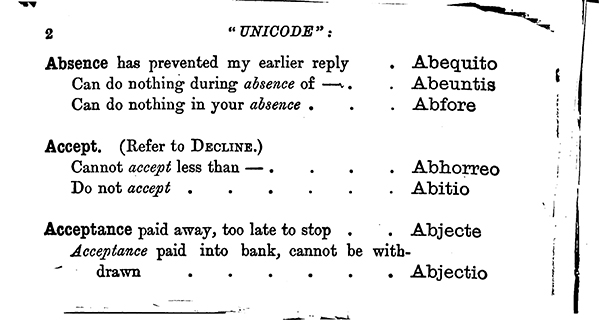 | |
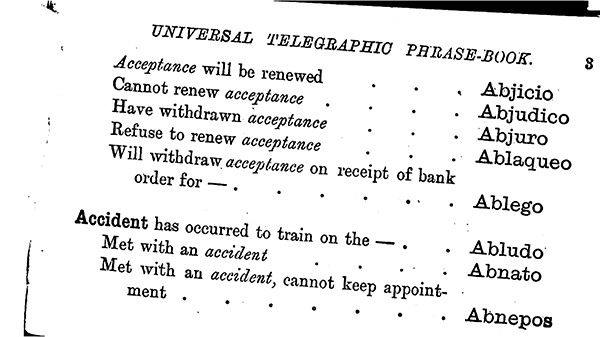 |
⬆
first code page(s), “Unicode” (1896, at left; 1889, at right)
| 1889
“Proposed Cable Chess Code” NYPL copy/scan (via google books) : link Each square bears a 2L (consonant) name; a move from one square to another involves a 4L “move-pair.” In order to form a word (in one of the eight permissible languages), one adds vowels as required. Thus, cncr yields concur, and rnpc yields ironspike or any other word, in any of the languages, that answers the purpose. |
| 1890
Chess Telegraphic Codes Harvard (SG 3673 14) copy/scan (via google books) : link Employs “Compass Notation” and a special form of same for the eight possible moves of a Knight. Figure code involves two tables (for two players remote from each other). Description of each move seems to depend on the coding for the opposite side’s move. A complete word code would require 315 pages, and so only one specimen page is printed. |
| 1891
The Anglo-American Telegraphic Code Published by the Anglo-American Code and Cypher Co.; Third Edition; New York, 1891 (1886)
U Michigan copy/scan (via google books) : link |
Made famous in the blog and tweeto-sphere by Ben Schott in his twittergraphy essay in The New York Times (2 August 2009) : link (well, no longer there, entire)
but some part of it (scroll down) at the author’s own website : link
and — prompted by that column and incorporating the Anglo-American — a clever “twitter secret code book” at tweetcode.xoxosoma.com — gone (now, 20231121), but not forgotten (although no longer functional) by the wayback machine : link
| 1891
Private Telegraphic Code. U California (Bancroft Library) copy/scan : link dictionary English codewords canned fruits, canned meats, soups, salmon, etc., (packed at various locations, including Alaska); dried fruits (sun-dried), evaporated fruits, raisins, honey, beans, dried peas, nuts, seeds, rice (Sandwich Island, China), salt salmon; descriptive phrases for all above commodities; pig tin, onions, morning glory, clothes pins, codfish, hams, hops, coffee, oysters, corn and succotash; freights, insurance, shipping, etc., samples, quoting, offering, buying, selling (instructions, inquiries, ability to, inability to, declining sale, advice of sale, market, names of firms, routes; On the Road and at Home (112-114); money; flour, wheat, corn, barley; miscellaneous (137-142); lumber; weather reports (145-46) |
| 1893
The United States Telegraphic Cipher U Michigan copy/scan (via google books) : link Abaft / New Layer Raisins |
| 1881-1925
The Adams Cable Codex. Many editions, scans listed below. |
- Cable Codex, ? Edition (1881)
C. L. Bartlett & Company
52 pages total
haven’t seen, but listed by google books : linkC. L. Bartlett appears to have been predecessor of E. A. Adams & Co.
The same firm published other titles, including The Handy Book of Synonyms (1879) : link (hathitrust)
whose entries sound much like the code words of a telegraphic code of the time : Abandon Abandoned Abase Abate Abettor Abbreviatenotice is given of an imminent (January 1880) move to 115 State Street, signed by C. L. Bartlett and Edward A. Adams (facing title page, same link)
- Adams Cable Codes, Sixth Edition (1892)
private collection code pages 8-140 - Adams Cable Codex, Seventh Edition (1894)
U California copy/scan (via hathitrust : link)
Harvard copy (via hathitrust) : link Harvard copy (via google books) : link code pages 8-161Preface explains the use of a cable code, to individuals who may for the first time need one. E.g., —
“In regard to illness, Mr. Towzer’s wife is ill at home and he must be notified of the fact. Turning to the Index, we find a number of pages under this heading, and from page 17 we can make the following message: — ‘MRS. TOWZER, ALBURNOUS,’ which would read, ‘Mrs. Towzer is ill. Sickness is not serious, but keep within reach of telegram so that we can communicate with you if wanted.’”
- The Adams Cable Codex, Eighth Edition (1896)
Northwestern U copy/scan (via hathitrust : link)
code pages 8-198 - The Adams Cable Codex, Ninth Edition (1896)
E. A. Adams & Co., Ship Brokers, Steamship Agents and Commission MerchantsHarvard’s Cabot (Science) Library Eng 4348.96 (via google books): link
same (via hathitrust) : linkcode pages 8-201
- The Adams Cable Codex, Tenth Edition (1913)
Boston: The Financial Publishing Company, 1913
U Michigan copy/scan (via google books) : HE7673.A22 1913: link - Adams Cable Codex, Eleventh Edition (1925)
U Illinois Urbana-Champaign copy/scan (via hathitrust : link)
code pages 8-201
Of the various editions of Adams Cable Codex,
pages 8-41 : codewords are a heavier font;
pages 42-140 : lighter font, new sections; blanks 138-140
those blanks are filled out in later editions;
141-161 : the eighth edition adds fractions and numerals, illnesses and accidents, some stocks
163-201 : these pages (in eleventh edition) for the first time include German and other European-sounding (if not actual) words as code.
| 1894
Inter-state Cipher. DULTC collection (scanned by Duke University from a private collection) : link domain : fruit shippers and jobbers code pp 3-182; index pp 183-84
|
| 1894
Private Cipher Code UC Berkeley copy/scan (via archive.org) : link code pages 5-154, in these categories (from Index) — Buying (109-1230; Calendar (90-93); Complaints and Allowances (67-72); Eastern Firms (124-142); Financial, Terms of Sale, etc (59-66); Grades and Qualities (79-89); Miscellaneous (143-154); Offerings, etc (19-24); Prices, etc (51-52); Responsibility (55-58); Samples, etc (5-11); San Francisco Firms (107-108); Selling (25-31); Shipping and Ordering (43-50); Shipping Routes (73-78); Stock and Market Prospects (12-18); Table of U.S. Gold Cents (94-97); Table of U.S. Gold Dollars (98-106); Writing and Telegraphing (32-42). |
code words: aback, abaft, abasement, abatable > gruff, grumpy, gruntle
| 1894
H. & W. Pataky’s Telegraphic Code for use in Obtaining and Negociating Patents. NYPL copy/scan (via google books) : link [11pp] + 1-128pp (odd numbers on verso side) |
Table of contents provides subjects and their subdivisions, which are presented in what might be called (but is not) “tables.” The headings below are taken not from the TOC but from actual pages. For each section, phrases head columns (at top), and respective countries (and subcategories for different durations, etc.) head rows (at left).
| Subject | pages |
| Instructions relating to the Filing of Applications, etc. | 1-8 |
| Instructions relating to the Amendment of Applications, etc. | 9-16 |
| Instructions relating to Appeals in the case of Applications being Rejected | 17-24 |
| Instructions relating to the Payment of Annuities and the Working of Patents | 25-32 |
| Instructions relating to Withdrawal of Applications and Extension of Time | 33-40 |
| Instructions relating to the forwarding of Papers, etc. | 41-48* |
| State of the Case | 89-96** |
| Assignments of Patents; Copies of Patents and Applications (Papers); Requests for Certificates of Filing and Annuity Receipts | 97-104 |
| Inquiries relating to Applications for, Granting of, and Validity of Patents, Costs of Applications, Annuities and Working | 105-112 |
| Dates | 113-115 |
| Time | 116 |
| Special dates for Filing | 117 |
| Dates at which Annuity due / Working due | 118 |
| Action where case rejected | 119 |
| Dates of Granting / Issue | 120 |
| Forwarding of papers, Remittances, etc. | 121-122 |
| Correspondence | 123 |
| Telegrams sent and received | 124 |
| Sales of Patents | 125-126 |
| Assignments | 127 |
| Costs | 128 |
* page 47 is given as page 55.
** pp 89-96 is correct, pp 49-88 do not appear.
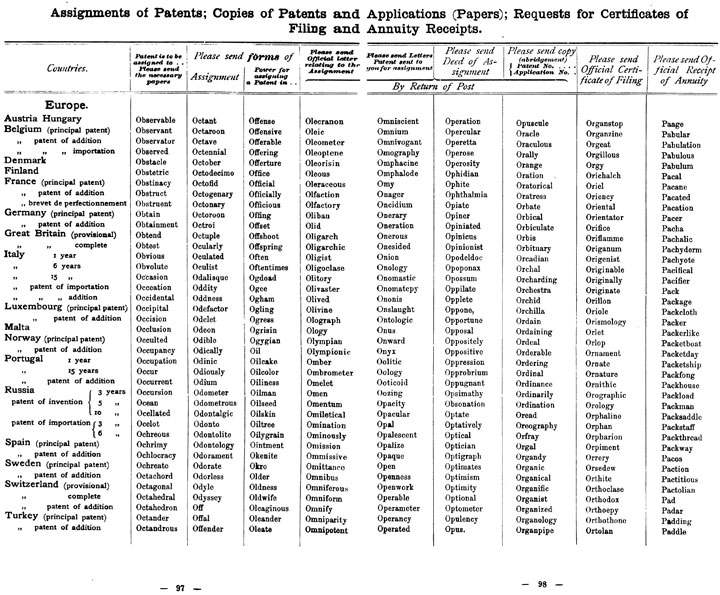
⬆
ex Google scan of NYPL copy, H. & W. Pataky’s Telegraphic Code (1894)
| 1896
The Atlas Universal Travelers’ and Tourists’ Telegraphic Cipher Code Compiled by T. Walter Hartfield for the proprietor, C. Amory Stevens, 30 Broad Street, New York, U.S.A. NYPL copy/scan (via google) : link same (via hathitrust) : link xviii + 726pp ; codewords selected from those published by the Berne Convention; phrase lists, excepting only calendar and similar tables. |
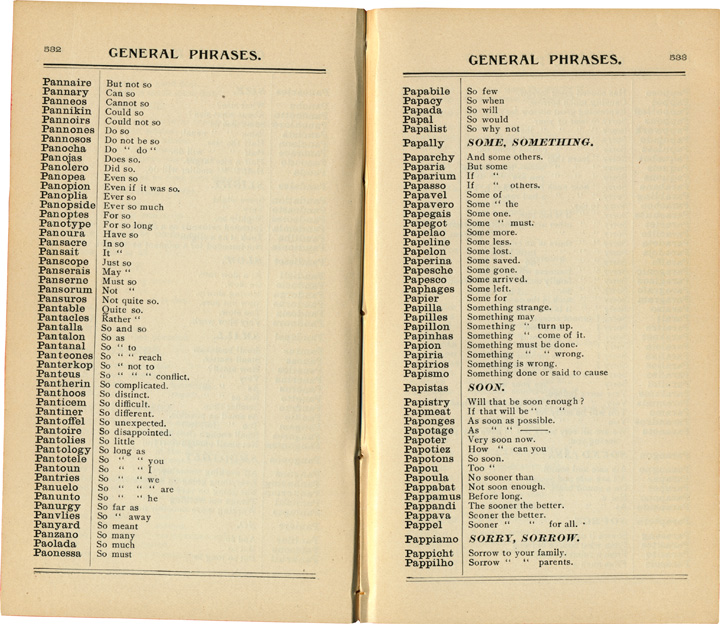
⬆
pp 532-533, The Atlas Universal Travelers’ and Tourists’ Telegraphic Cipher Code (1896), private collection.
An example of a (Gertrude) Steinian phrase sequence... (Beckett listening in, too)
| 1896
Lièber’s Standard Telegraphic Code U Toronto copy/scan (via archive.org) : link more (same) via hathitrust : link B. Franklin Lieber.New York: Lieber Publishing Co., 1896 Pronounceable code words of five to ten letters taken from the Berne Official Vocabulary. 75,878 entries (including blank phrases). |
The Premier Cypher Telegraphic Code William H. Hawke, comp. London: Effingham Wilson, 1896 Harvard copy/scan (via google books) : link An elaborate code, involving phrase vocabulary and multi-orientation tables that roughly approximate later figure code/condenser arrangements. The tables economize on codebook length, and theoretically aid quick location of needed phrases or other expressions contained within them. They merit close study. From the 3-page preface, one page of which is given over to example phrases, this : “This ‘saving in expense’ is of course the primary object of a Code, but the next consideration is to arrange a Code so that what is required to be transmitted can be sent with the least possible trouble and waste of time. ¶ This has been most carefully studied, and entirely novel and simple methods of tabulation introduced (as well as abundant references and cross-references) to make the Code rapid of use in every aspect.” |
From notes to my own copy :
- pp 1-185 abaissais / A(an) [and instruction “See page 309” being a “sundry combinations” table : cross referencing throughout ] > ayudado / Zinc-lined
- 186-195 ayudantes > badehemd (blanks)
- 196-197 a blank combination table [ 1-60, a-k ]
- 198-200 “Reserved Tables. For combinations of 10 x 6 x 5.” blank table, first orientation a > k, second and third orientations indicated by figures 1>30, in table.
Some of these tables have been filled in by user : example : where three orientations in one codeword can be seen in action.
- 201-500 “consist of tables incorporating the whole of the ordinary English language as required in business and social communications, besides useful tables embodying the most important subjects which require to be telegraphed about.” The code’s Index to Tables provides the following “summary of tabulations” :
reserved 196-199; verb tables 202-273; auxiliaries 274-283; adjectives, etc. 284-305; interrogatives 306-307; [“sundry”] combination phrases 308-347; names combined with phrases 348-351; dates, time, etc. 352-399; prices, amounts, etc. (sterling) 400-413; prices combined with quantities, etc. 414-453; finance 454-461; decimal currency 462-470; quantities 471-479; terms and ports 480-481; shipping 482-485; market 486-493; telegrams, letters, etc. 494-499.
A sundry combination phrase might involve : g / there is some + 29 / misunderstanding about = expletioni.
a “names in combination with sundry phrases” might involve : k / [blank for name] + 16 / ’s consent has been obtained = ficedulis
389 “Firm offers with quantities and dates” might involve : n / We make firm offer 250 (bales, cases, tons, or other quantities) + 14 / Feb., Mch., Apr. OR Aug., Sep., Oct. = grediner
427 “CAN BUY combined with QUANTITIES and PRICES” might involve : i / Can buy 50 (bales, cases, tons, etc.) + 24 / [here, any one of six partical price ranges, each range offering as many as six possibilities] = investida (this page is among several missing from scan — though I’ve not checked the PDF; see instead pp 442-443, for “you may sell” combinations.
The Dynamic Chess Notation pages 26-28, in F. Startin Pilleau. The Dynamic Chess Notation : whereby any possible move in a game of chess can be accurately described by the use of two letters only. “Illustrated by the complete set of games of The Petersburg Tournament, 1895-96.” Published with the imprimatur of the British Chess Club. London, 1896. appeared as a supplement to the Chess Monthly; nicely designed cover : link Harvard copy/scan (SG3673 231.2), via google books : link |
The code enables any possible move to be described by two letters; it does not indicate position on board, thus, every piece must have a name (or label).
The Robinson Telegraphic Cipher. Cornell copy/scan (via google books) : link originally published by S L Robinson, Author and Proprietor, Board of Trade, Chicago. This copy bears the pasted stamp of American Code Company, Publishers of Telegraph Codes, 83 Fulton Street, New York City.
The whole is 103pp (plus 29 page supplement), 3. x 5.25 inches. |
Grain, market, trade. Also provisions (hogs, pork, lard, “green meats,” bulk or dry salt meats, boxed or English meats, &c.), hay and straw, in salt, in pickle, etc. Pages with new content (that is, additions to an 1872 edition), are asterisked in the Index.
Uses what Barto calls “particle prices” — “When the price is manifestly above 1.10 the dollar will be understood and not expressed, as “Churl,” for 1.35 1/4.” (“Churl” means “35 1/4”).
The Supplement has a separate pagination pp 4-29 (following its own title page, introduction and index), and covers breadstuffs (barley, buckwheat, corn, flour, oats, etc), as well as railroads, transportation lines, indemnities, miscellaneous.
Private Telegraphic Cipher Code. Nicholas Gessler, DULTC collection (via archive.org) : link 32 pages, of which pp 3-8 are information about Kerr, Gordon & Co., and about investments; p 9 treats “How to use our code;” and pp 10-32 are the code proper. Pages 15-26 are arranged in three columns, providing code for (1) Quantities, quotations, numbers; and (2, with fractions) Quotations for provisions. No blanks. investment broker, grain, stocks, etc. |
The South Indian Telegraph Code, Roja Muthiah Research Library copy/scan (via archive.org) : link trade, commerce; polyglot i-ii Preface (in English) a beautiful code, in what appears to be stanzaic form, three lines per stanza. Roja Muthiah Research Library, Chennai (website) : link |
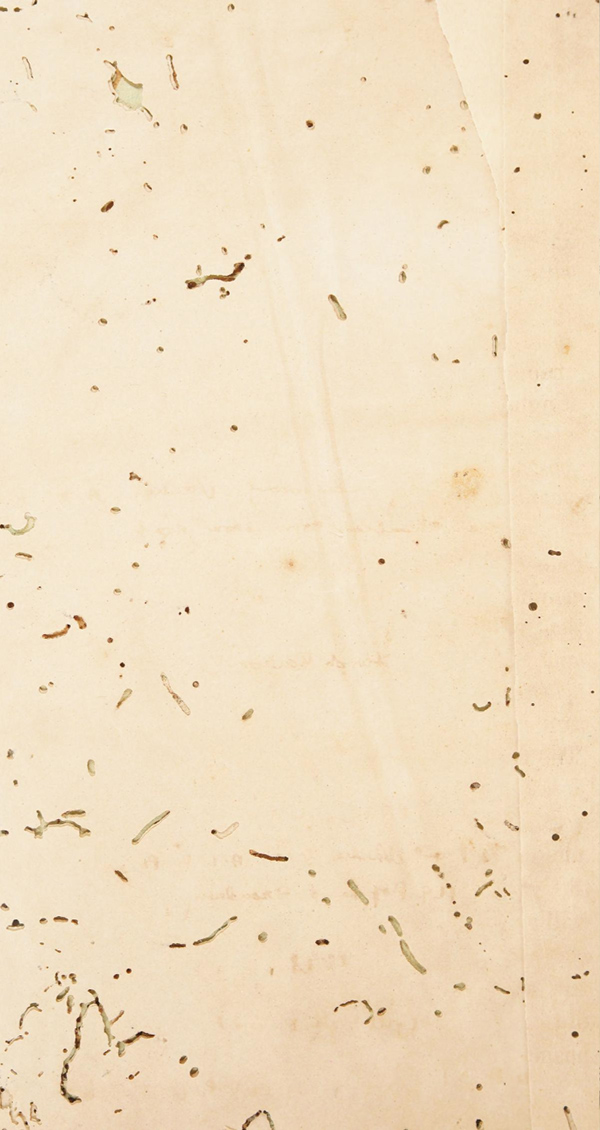 |
 |
⬆
The South Indian Telegraph Code (1898)
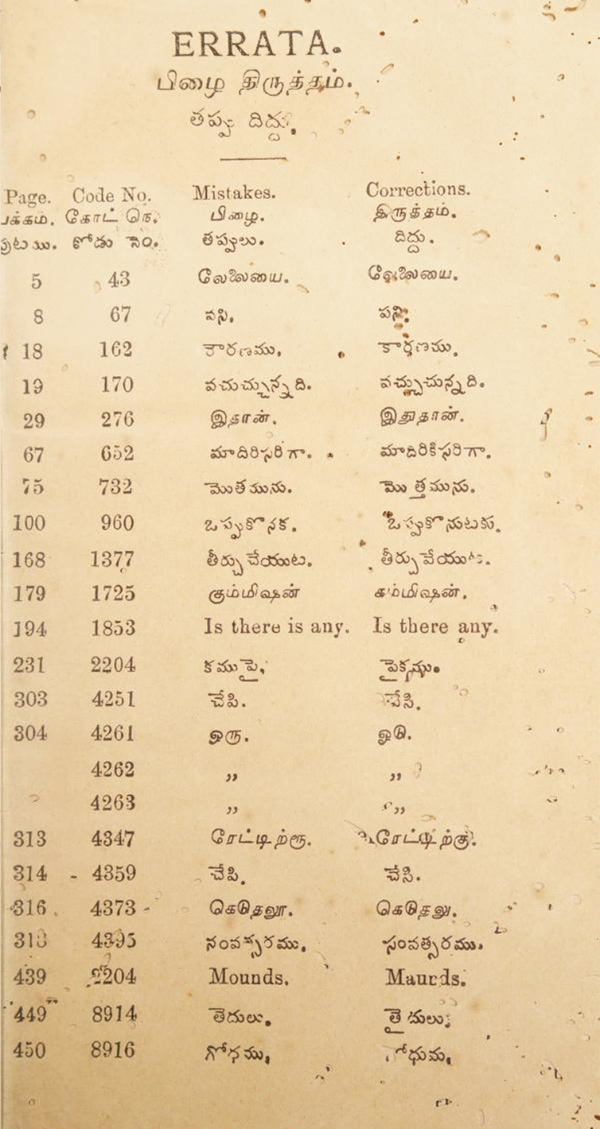 |
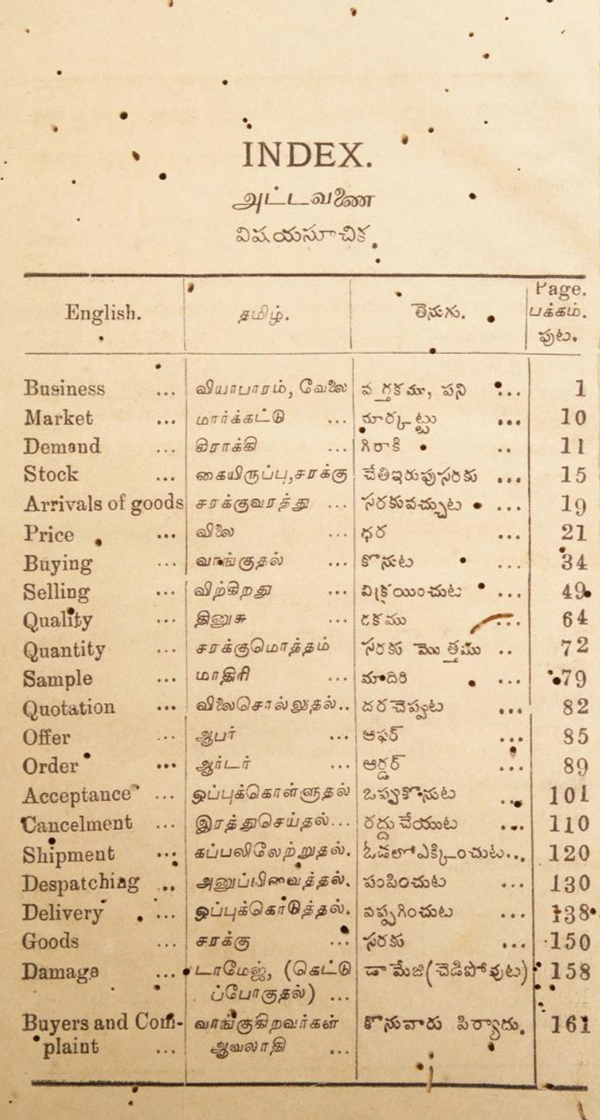 |
⬆
errata, and p xi (Index), not facing pages
The South Indian Telegraph Code (1898)
 |
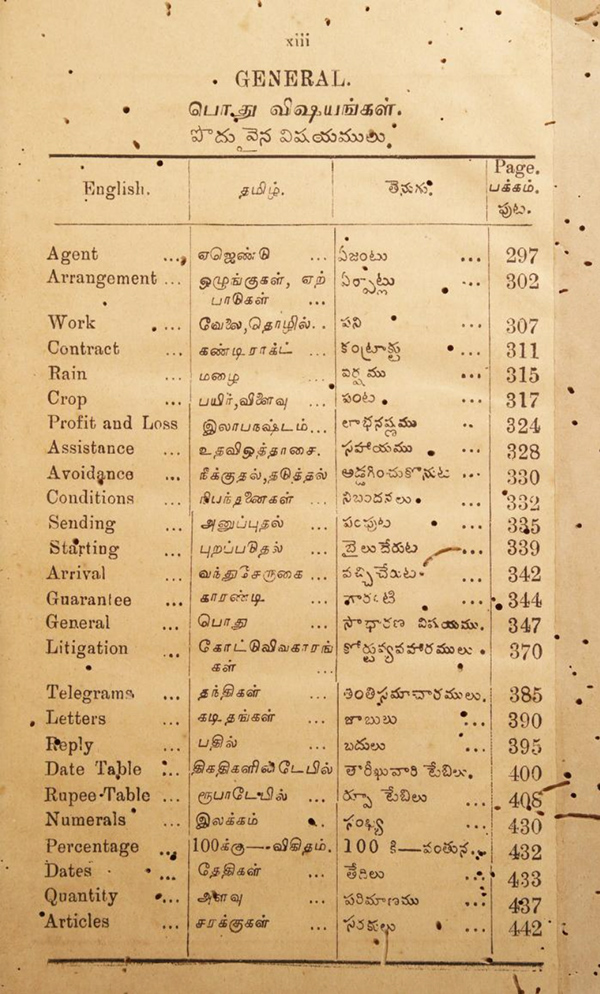 |
⬆
pages xii-xiii (Index), The South Indian Telegraph Code (1898)
 |
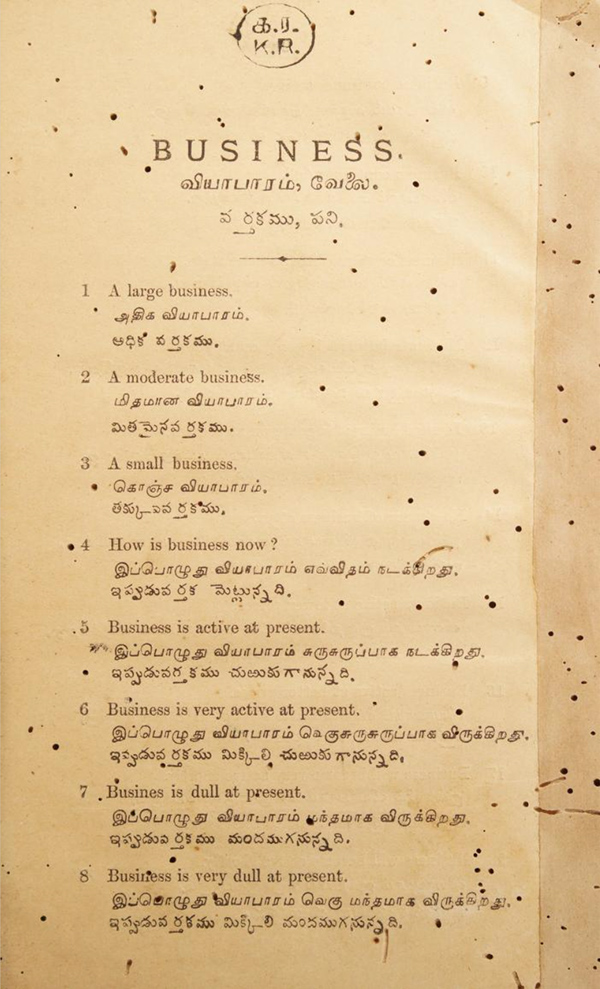 |
⬆
page 1 (of code), The South Indian Telegraph Code (1898)
Krishaswamy Naidu is mentioned in two U.S. trade publications in 1914, when he is evidently involved in tanning and (other?) trade. Transcriptions of those mentions follow.
- Visitor from India.
Oriental Tanner Making World Tour.
Now in Boston.
Mr. P. B. Krishaswamy Naidu, B. A., of the firm of S. Hajee Abdulla Saib & Co.., Madras, India, who is on a 30,000 mile trip visiting his various agencies in France, London, America, Chiba and Japan, was a visitor in the Boston market last week, in company with his American agent, Mr. A. C. Needham.
The firm owns and operates six tanneries in India. Mr. Naidu visited several of the local tanners of India tanned skin, who are interested in getting from an India tanner information as to the process of tanning now in vogue in India. Mr. Naidu is the first Madras tanner tanning on an extensive scale that has visited this market for some years, and information of value as to exactly ow the business is carried on their from the first collection of raw pelts to the final sale to dealers and brokers in Madras by tanners for shipment to America, was given to buyers here.
Hide and Leather 47:1 (March 19, 1914) : 8 : link - A Visitor from India
P. B. Krishnaswamy Naidu, of S. Hajee Abdulla Saib & Co., Madras, India, tanners and merchants, visited leather factories of Salem and Peabody last week. He was accompanied by A. C. Needham, of Boston, American agent for his firm. Mr. Krishnaswamy is on a 30,000 mile trip among the countries of the world, observing industrial progress. He stopped in Peabody, to observe leather making methods, and, also, to inquire what leathers from India could be used to best advantage by Peabody manufacturers, his firm operates several tanneries in India, and sends large quantities of sheep, kid, kip and buffalo pelts to London auctions. Plans are being made to equip the tanneries with American machinery. Young men have been sent to the Leather Sellers’ College, London, to learn modern leather making. They will be employed in the tanneries.
Shoe and Leather Reporterr 47:1 (March 21, 1914) : 19 : link
![]()
Preface (English language, transcription)
The undersigned has much pleasure in presenting this book to the Public and the Mercantile public more particularly. In India the local and to some extent foreign trade is being carried on by merchants unacquainted with English, and in consequence, they are, comparatively speaking, in a backward condition, as they do not possess such facilities as the English-knowing merchants do, such as Telegraph Codes, &c. Therefore the writer has thought that a book like the present one is indispensably necessary for the safe conduct of business. This is the very first attempt that has been made of compiling a Code in English and native vernaculars together, so as to curtail the telegraphic expenses and thus induce facilities for trade by cheap means of quicker communication. The use of this code will enable the public to wire full informations on any given subject at a minimum cost, which would otherwise prove impracticable and costly to forward by means of telegram, and the writer has not the least doubt that this book will serve as a help to the development of business in every way as the Codes in other languages. Though this work was specially undertaken at the request of a large number of native merchants who have had business connections outside India, such as Singapore, Rangoon, Colombo, Mauritius, Natal &., the compiler has taken advantage of the opportunity to include other subjects for purposes of internal trade as well. The book will be found highly useful to the general Public also, as general expressions of every day life, legal communications, &c, have been likewise included.
In making up this Code great care has been taken to secure accuracy of expression in simple and plain language. The writer’s close connection with large Export and Import houses, both European and Native, and his experience of the requirements of the local and foreign trade, have enabled him to compile this work and he therefore hopes for a favourable reception from the discriminating public, as a careful perusal of the book or at least its index will enable every one to appreciate its real merit and to find the increased economy obtainable by an intelligent use of it.
The sentences and phrases contained in the book have been classified under various headings to facilitate speedy coding of a message.
Any suggestions respecting improvements will be thankfully received and included in the future editions.
Purchasers are requested to recommend this book to their friends and correspondents.
p i-ii : link
![]()
other items listed under heading “telegraph” in catalogue of the Roja Muthiah Research Library, Chennai :
- Trathic code [for “traffic” ?] / Government of India, Telegraph Department, 7th ed
Calcutta : Superintendent, Government Printing, 1900
xxvii, 272 p. ; 24 cm.
RMRL Shelf mark.9242 : link - தந்தி போதினி [Danti Bodhini] : Telegraph instructor
சென்னை [Chennai] : s.n, 1900
136 + p. ; 22 cm.
RMRL Shelf mark.37973 : link - தபால் தந்தி மித்திரன் : இதனுடன் தவணை, நடப்பு வட்டிகள் விபரமும், தந்தி எழுதும் மாதிரியும், நகரக்கோவில்களின் விபரமும் இன்னும் பல முக்கியமான விஷயங்களும் சேர்க்கப்பட்டிருக்கின்றன
இரங்கோன் : வைசிய நேசன் கம்பெனி, 1919
machine translation :
[Postal Tandhi Mitran : It includes details of installments, current interest rates, sample of writing telegrams, details of city temples and many more important things.
Irangon : Vaisya Nation Company, 1919]
xii, 84 p. ; 28 cm.
RMRL Shelf mark.89434 : link
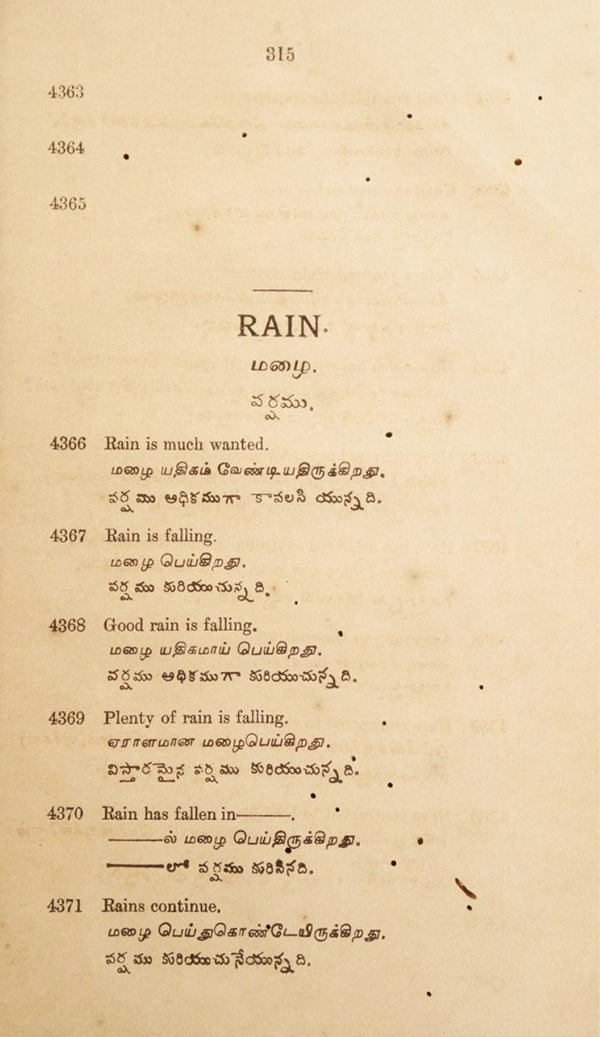 |
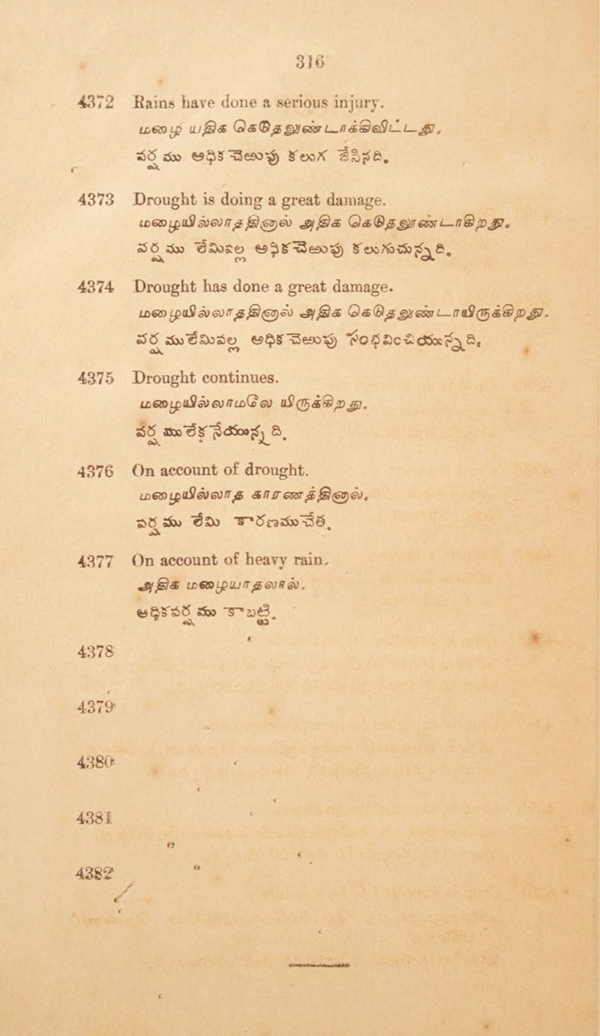 |
⬆
“Rain” (pp 315-316, not facing pages)
The South Indian Telegraph Code (1898)
Liebèr’s Standard Telegraphic Code (1898) Harvard (Cabot Library) copy, via google books : link general, 800 pages A German edition arranged by C. C. Beyer would appear in 1910 |
Private Telegraphic Code of Lunham & Moore, U Minnesota copy/scan HE7677.P9 L9 (via hathitrust) : link 51, [1] p.18 cm. Tables pp 4-30, followed by “General Phrases” pages 31-50, and “Addenda” (phrases) pp 51-60. Appears to be sheets slipped/pasted in, pp50-52, including a list of other codes (Hinrichs, also ABC). Mainly grain, but other commodities too (cotton, lard, tallow, turpentine). Page 3 provides explanatory “Notice” and an “Index” (=table of contents). |
| 1900
Low’s Pocket Cable Code (Alphabetical) Published by F. T. Low, 1123 Townsend Building, New York. With list of European Bankers with their telegraphic addresses.. U Michigan copy/scan (via google books) : link code pages 12-199 (“appendix” 197-199); followed by Abbreviated List of Bankers pp 200-205 |
| 1900
The Heath telegraphic cipher for the use of flouring mills and flour merchants Sold only by G. M. Heath, Author and Proprietor, La Crosse, Wisconsin, 1900 Private collection, scanned by Duke University for the DULTC collection (via archive.org) : link [8], 1-128, [4]; index last two unnumbered pages in front.
This copy no. 149 (rubber stamped on “property of” page), property of Listman Mill Company, La Crosse Wisconsin and is loaned to E. Provost & Fils, Lewiston, Me. some pasted-in additions (printed) |
| 1901
Western Union Telegraphic Code (Universal Edition) U Michigan copy/scan (via google) : link index (3-8); code (9-803); Regulations for Cable Messages (804) |
| 1901
Telegraph Code. Harvard (Cabot Science Library, Eng 801.24 copy/scan (via google books) : link |
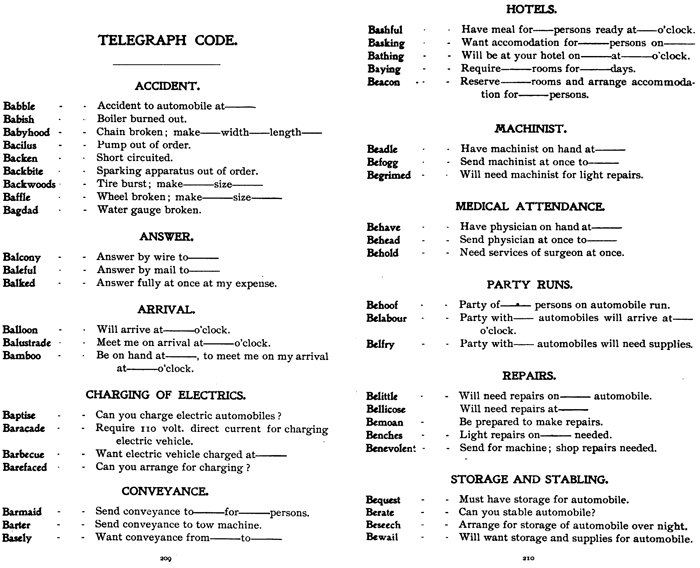
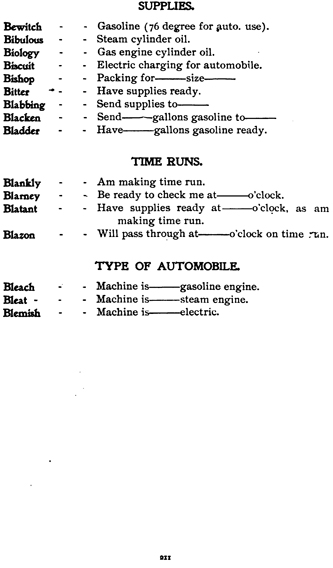
⬆
pages 209-11, entire text of “Telegraph Code,” Official Automobile Blue Book (1901), from Google scan
The code is to be used by members of this automobile club while touring, particularly with reference to the service stations associated with it. An introductory explanation of the “Use of Stations” includes this passage about the telegraphic code —
“While our stations carry supplies, etc., sufficient to meet the demands of ordinary touring, and for their regular customers, it should not be expected that they will be able to care for a number of automobiles without notice. We therefore suggest that in the case of club runs or even parties of five or six, they be notified in advance by letter or telegram so as to assure sufficient supplies and attendance. Our telegraph code is intended to cover such notification, and a little forethought in its use will absolutely assure sufficient attention and possibly save much valuable time.” (p8)
Not to be confused with Robert Edwin Pye, his The automobile telegraphic code, (San Francisco: Code Publishing Company, San Francisco, 1917), 834pp
| 1902
Codigo brazileiro universal. NYPL copy/scan (via hathitrust) : link H. L. Wright |
General code, emphasizing trade, shipping, banking (see table of ship classifications, below right). Index at pp xi-xii. Phrases in Portuguese pp 1-416 (blanks starting at 399), followed by tables (pp 417-542 and “Tabellas em branco” (blank, pp 543-638).
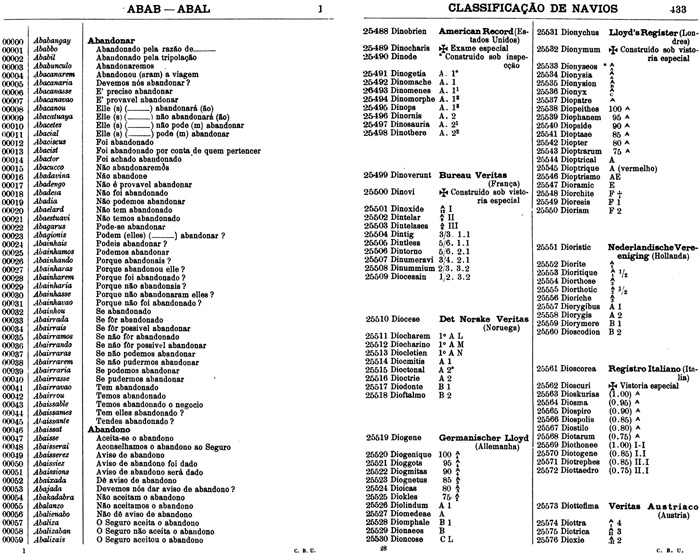
⬆
pages 1 and 433, Codigo brazileiro universal (1902)
Codewords look like Berne vocabulary, and the book itself has something of the flavor of the ABC Telegraphic Code (Fifth Edition). All (phrases and table cells) numbered. (N.B. : None of the scans shown here accurately indicate relationship of textblock to page size, or even to facing textblock where shown in spreads.)
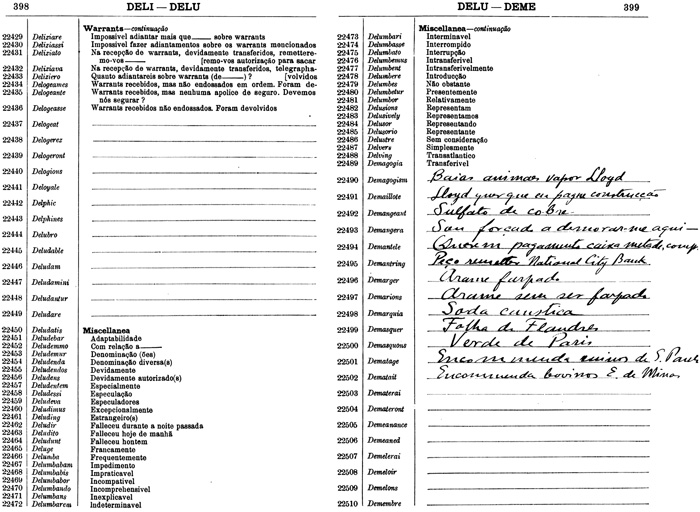
⬆
last two pages of phrases (before blanks), ex Codigo brazileiro universal (1902)
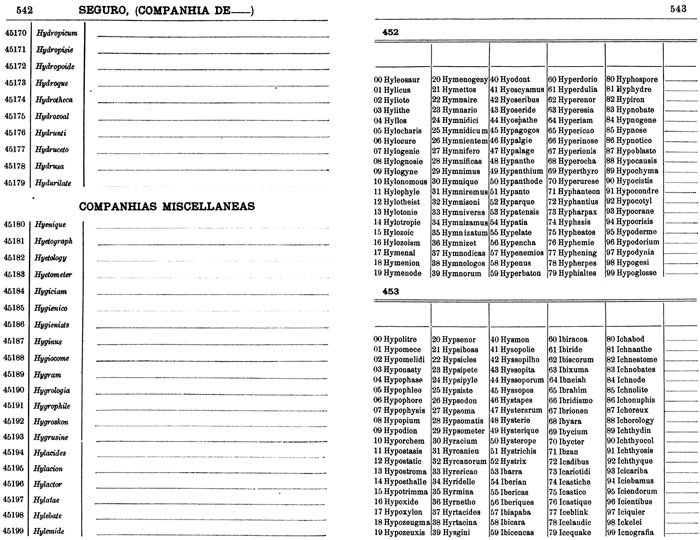
⬆
blank tables pp 542-43, Codigo brazileiro universal (1902)
| 1902
The Westinghouse Code. Harvard copy/scan KE4561 (via google books) : link |
Index v-xii
Instructions for Using the Westinghouse Code xiii-xiv
Code Condenser xv-xvi
Cable Addresses xvii-xviii
General Phrases 1-432
Index of Machinery and Apparatus 433 —
specs presented in tables 435-495
| 00001 | Kabache | Abandon |
| 00002 | Kabakos | Abandon for the present |
| 00003 | Kabasdah | Abandon the whole thing |
| 00004 | Kabasjes | Abandoned on account of |
Codewords begin with the letters K through W exclusively. Hence, as is (confusedly) explained in the introduction, the code may be used in conjunction with Lieber’s (code and appendix), whose code words begin with the letters A through E.
Users are invited to send “phrases in frequent use, not found in this code” to the Westinghouse Companies’ Publishing Department, for inclusion in printed slips of additional phrases to be attached to page margins.
| 1902
The International Cable Code, Third Edition. James Gopsill’s Sons, Publishers, Philadelphia U Chicago copy/scan (via google books) : link 1 p. l., 5-276 p. 26 x 33 cm. |
The book is wider than tall, and much of it in tabular format. It is designed for provisions, grain (e.g., lard, pork, bacon, meats, cotton, wheat, corn, petroleum), and divided into three main sections (my assessment):
- 22 pages devoted to rules and regulations about telegraphy and commodities trade in various markets (and languages);
- the telegraphic code, with codewords and phrases or (conventional) tabular message molecules (pp 34-123, although spare codewords are found throughout); and
- largely blank tables (pp 124-276), in various configurations.
Headings are as follows :
- Quotations (34-41);
- Numbers (42);
- Packages (43);
- Dates (44-45);
- Shipments (tabular, 46-51);
- Orders and Offers (52-53);
- About Buying (54-56);
- About Selling (56-58);
- About Cables (59-60);
- Consignments (61)
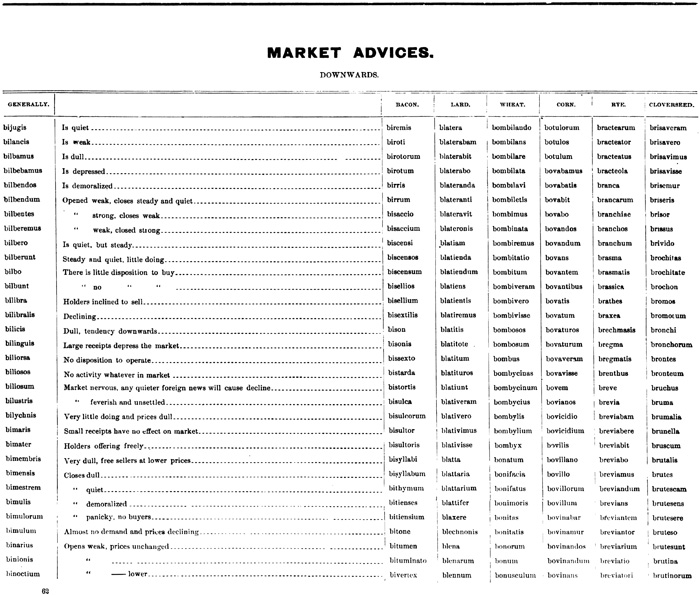
⬆
p62, cropped - Market Advices (62-68, including petroleum markets at p65);
- Insurance (69-70);
- Freights and Charters (70-74);
- Steamers (75-81);
- Weather and Crops (82);
- Receipts and Shipments (83);
- (sentence) Fragments (84-90);
- Articles (91-108);
- Qualities (109-111);
- Brands (111-114);
- Drafts and Credits (114-116);
- List of Bankers (117-123, some tabular form for draw 3 and 30 days’ sight);
- List of Buyers (124-144, various blank tabular formats); blank tables (offer / order executed) 145-253;
- Quotations / market upwards (254-255);
- Quotations / market downwards (256-257);
- Seller’s Option (258-269);
- various other tables (as many as 14 columns, but other configurations too), 270-176.
| 1903
Appleby’s Copyright Code for Correspondence by Telegram. U Wisconsin-Madison copy/scan : link different volumes, editions via hathitrust : link Something like what would later be Sweet’s Catalog. |
Each of the volumes has its respective code name :
Section I, Prime Movers Admugitum
Section II, Hoisting Machinery Adnatobat
Section III, Pumping Machinery Adociria
Section IV, Machine Tools Adoliridas
Section V, Contractor’s Plant and Railway Materials Adumbrato
Section VI, Part A (Mining, Colonial and Manufacturing Machinery) Adonteremo
Section VI, Part B Adopterus
This code can be used to indicate page number, etc., in any of these volumes; and be used in conjunction with others (the A1 Code is referenced at page iv)
| 1903
Telegraphic Code. Harvard copy/scan : Econ 5588.1 (via google books) : link |
All codewords start with L, e.g.,
Labadist / 1/16
Lazaroni / Bid and offered prices for coupon 5’s of 1904 to-day are ——
Lemming / Your telegram came too late for execution to-day.
| 1904
The tourist’s pocket-book. George F. Chambers. Seventh Edition. London: Hugh Rees Limited : 124 Pall Mall, S.W. U California copy/scan via archive.org : link ex libris C. K. Ogden. The code is pages 93-98 of this 112-page volume. aa ab ac ad ae > zx zy zz, followed by aaa aab aac > bci bck bcl (“f” is not used), and one letter each for numerals, some fractions, and to pluralize a word. |
“The following example will illustrate the use of this cypher Code:—”
WP ABT AEE AIG AFY ACG ABA ZM CD XQ BE TB AVT AQG XA AVX XL AVT DF BBL BCI AVW FT L N AWK ALICE ZL DX FQ WZ IG ZL ARS CT AEE XT ABC VVAZI VT AMM Q AILS SZ B ADTS.
“Have lost my portmanteau, omnibus man left it at hotel, am forced to sleep here to-night, hope to be with you to-morrow by 10.15 train. Alice is better, but her cold is still bad. My house let, got very good rent, 50l. for 2 months.”
—
C. K. Ogden — from whose library this volume comes — was the devisor of BASIC (for “British American Scientific International Commercial” English. He might have drawn instruction from this and other polyglot phrase books, particularly relating to the reduction of vocabulary to a bare minimum within respective topical groupings. Here are the categories for this polyglot phrase dictionary :
cardinal numbers. ordinal numbers. fractions. various numbers. the seasons. the months. the days of the week, etc. articles of food and drink. short sentences. railway. steamboat. at an hotel. post office; telegraph office. travelling by road. illness. in a shop. useful words of various kinds. washing lists.
Ogden’s “panoptical” reduction of expressions down to the 850 words in Basic English parallels — if it does not owe something to — the analytical and synthetic work that underlies the telegraphic codes in their selection and topical arrangements of phrase matter and which, in some instances, received extended explanation — in one case something like a theory of language — in prefatory sections.
The Ogden papers are held in Special Collections, Young Research Library, UCLA. The finding aid is available at content.cdlib.org/ark:/13030/kt7p3021p9/. Acquisition of the Ogden collection is described in Lawrence Clark Powell his Books in My Baggage: Adventures in Reading and Collecting (Cleveland and New York, 1960): 130-136. The collection totalled 403 packing cases, some 80,000 volumes, including hundreds of manuscripts. The material was dispersed (“divided,” sometimes by lot) amongst the various UC libraries. No codes are contained in the Ogden archive, I was told some years ago.
An essay relating the Ogden’s BASIC Panoptic Conjugation and “eliminator” with the arrangements of some telegraphic code dictionaries is under way abandoned.
| 1904
Special Cable Code for the Use of Delegates. NYPL copy/scan (via google books) : link pp 51-52, The Rev. John Kerr, Curling in Canada and the United States: A record of the tour of the Scottish team, 1902-3, and of the game in the dominion and the republic (Edinburgh and Toronto, 1904) |

⬆
Special Cable Code for the Use of Delegates (1904)
| 1905
Omnibus: télégraphique français de poche à l’usage Paris: Boyveau et Chevillet, 1905 NYPL copy (via hathitrust) : link phrases, some tables |
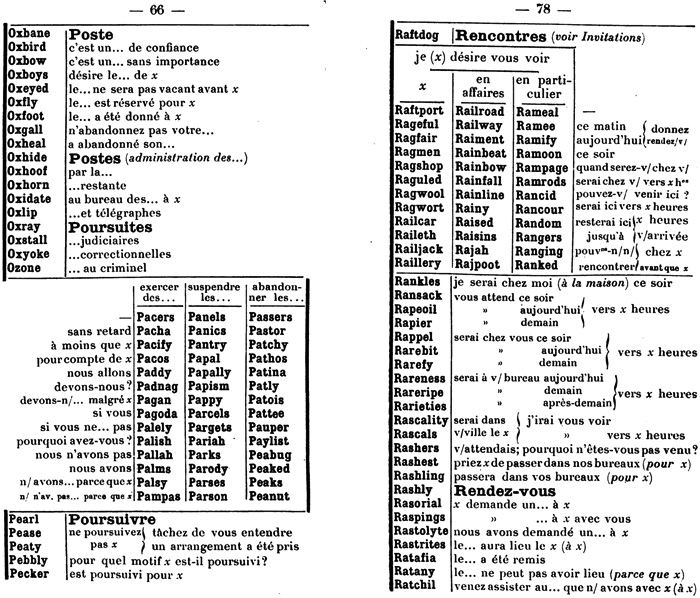
⬆
two pages (not spread), ex Omnibus: télégraphique français de poche à l’usage (1905)
| 1905
Lieber’s Bankers and Stockbrokers’ Code and Merchants’ and Shippers’ Blank Tables B. Franklin Lieber and Charles J. Dawson
6 p. l., 10-487 p.20 cm. NYPL NYPL copy/scan : HE7677.B2 L7 (via hathitrust) : link root and terminal tables only, no phrases. |
Tables, many for stocks, and set up in root and terminal pairs (facing pages).
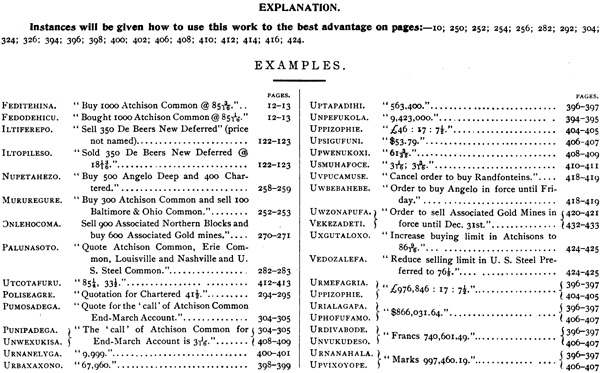
⬆
Lieber’s Bankers and Stockbrokers’ Code and Merchants’ and Shippers’ Blank Tables (1905)
from the Preface —
“In addition to its simplicity and economy, attention is called to its great elasticity. Owing to it tabular arangement throughout and to the large number of Blank Tables, it wil be found a matter of great ease for users to vary, or add to the Tables as here printed in order to meet their own special needs—a point hitherto overlooked or insufficienty provided by amost all Code compilers. Thus, should the Tables for Australian Mines (pages 180 to 217) not be required with any particular correspondent, it is a simple matter to substitute other headings.”
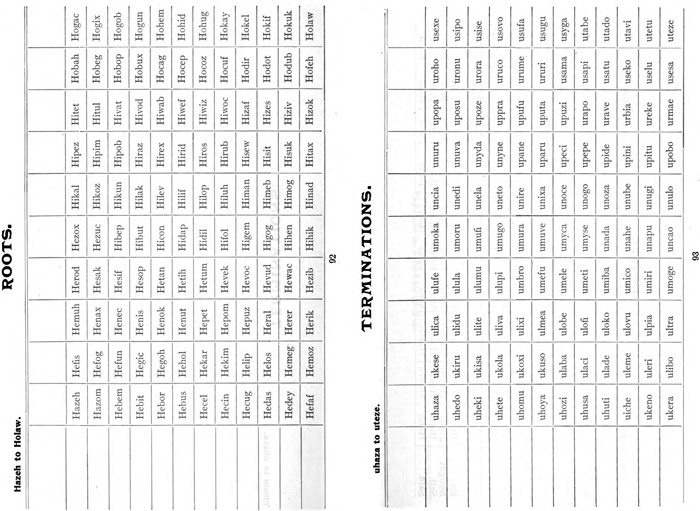
⬆
pp 92-93 ex Lieber’s Bankers and Stockbrokers’ Code and Merchants’ and Shippers’ Blank Tables (1905)
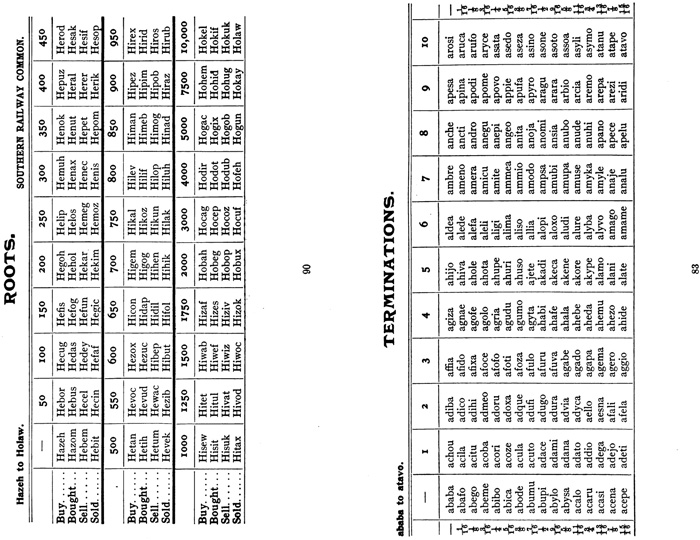
⬆
pages 90, 83 (taken from spread, in scanned copy) Lieber’s Bankers and Stockbrokers’ Code and Merchants’ and Shippers’ Blank Tables (1905)
| 1905
Telegraph Cipher Code. NYPL copy/scan (via google books) : link “A great part of the articles listed in this catalogue are given Cipher words or names by which they may be ordered by telegraph.” Deming also uses the ABC 4th Edition and the Western Union Telegraphic Code. Many — even most? — industrial catalogues of this period incorporate telegraphic codes throughout. |
| 1906
Travellers’ Telegraphic Code. edited by Edmund C. Stedman and Thomas L. Stedman. New York: William R. Jenkins / London: Baillièe, Tindall & Cox, 1906 Harvard copy/scan : KC11692 (via google books) : link travel, social. Dictionary English codewords; ample blank cyphers. Same code is found in Cassell’s Complete Pocket-Guide to Europe, Revised and enlarged; Planned and edited by Edmund C. Stedman; Compiled by Edward King (1897) : 492-499
|
sample code/phrase pairs —
| Cardinal | Return at once. Important matters demand your presence here. |
| Careworn | Things look blue. Unless strong reason to the contrary, should like to have you shorten your trip. |
| Cargo | You need not return. |
| Demon | Am without funds; send money to — —. |
| Gazette | Do as you think best. |
| Gender | Can you arrange? |
| Genial | We can arrange. |
| Geyser | We cannot arrange. |
| Gothic | Keep this confidential. |
| 1907
Standard Lumber Reference Book and Code. Copyright, 1907, by The Franklin-Turner Co., and Benj. F. Ulmer The code is but 44 pages, following 205 pages of rules of classification. NYPL copy/scan HD9754.S7 (via hathitrust) : link Codewords are from (English) dictionary; some stem and terminal (in tables). |
Rules, classifications, specifications pp 9-204, followed by
1 page (unnumbered, link) “Private Cypher Code” of Lunkenheimer Co., Cincinnati, Ohio (valves, gauges, whistles, injectors, ejectors, lubricators, grease cups, oil cups); followed by
Ulmer’s Yellow Pine Code (copyright 1904), separate pagination pp 1-44 : link.
Ulmer’s car number; Board measure contents; Dollars and cents; Specific lengths in feet and inches; Specific dimensions, thickness by feet, in even inches (all tabular); Thicknesses and widths in inches and fractional inches; Time of delivery in weeks and months; Time table by hours, days and months; Questions; Instructions, miscellaneous phrases, etc.; and Railroad companies
Nice code/phrase pairings; a few examples —
| Frolic | Cut all you can |
| Lantern | If we can |
| Latin | If we cannot |
| Linger | In addition to |
| Liquid | In box cars |
| Lizard | In flat cars |
| Minister | Let us have |
| Miser | Let us know |
| Mission | Let us know when |
| Mister | Let us know where |
| Monkey | Load last |
| Monstrous | Load next |
| Motto | Make a price |
| Mumble | May be cut in multiples |
| 1907
Postal Code (Telegraph-Cable). by Frank Shay and Richard V Day; San Francisco: Freygang Publishing Co., 1907 Columbia copy/scan (via google books)) : link |
“Official vocabulary”, or (for landline only) five figures. Totals 862 pages; 93,480 numbered entries (including blanks), phrases (and names, numbers, prices, etc.) but no analytical tables. An expansion from Shay’s 1888 (and 1899 reprint) Cipher Book published by Rand McNally.
Title page bears two seals, for the Commercial Pacific Cable Company and The Commercial Cable Company, respectively, containing maps showing their Pacific and Atlantic cable routes.
Good phraseology.
| 1908
The Billionaire Phrase Code. Harvard copy/scan KE5922 (via google books) : link |
No phrases other than contained in flexible tables; similar structure and arrangement, even typographical detailing, to the Master Telegraph Code (1909), the Miners’ & Smelters’ Telegraph Code (same year), Brentano’s (1909), etc.
Flexible tables generate ciphers of 10 letters, ciphers beginning from letters U through Y. Ciphers must be taken from each of the used columns consecutively: the first two (or three, if one assembles ciphers in that way) columns provide pronouns, adverbs, modals, etc.; the “Fourth Column” pp9-39 contains the topics.
All contained in 56 pages total.
| 1909
Bentley’s complete phrase code U Toronto copy/scan (via archive.org) : link |
Title page stamped “C. Bensinger Co., Inc. Code-Book Supply Dept. / 15 Whitehall St. New York City”
Does not include 2-letter difference claim. One Million Cyphers appear at end of volume (compare with Bensinger edition described below. The following (odd, and even misleading) explanation faces first page of code : “Bentley’s Million Cyphers for the transmission of Numbered Sentences from Public or Private Codes in one word are to be found at the end of this Volume with full directions, showing that they can be indiscriminately mixed with Cyphers from this Phrase Code.”
See fuller discussion in description of the 1921 Bensinger reprint.
| 1909
Brentano’s Telegraph and Cable Code New York, Brentano’s; copyright by The Business Code Company. 1909. (published earlier?) Harvard copy/scan (via google books) : link |
Flexible Phrase Tables pp 1-10 (ten tables in all, e.g., Table No. 9 “affirmative and questions”) ; General Phrases 11-285; Tables 287-313 (some of these 3+2 or 4+1 flexible tables, say, for calendar; Supplement 314-320 (blanks, followed by Stocks 321-328)
| 1910
Private Jute Code. Bengal Library accession stamp (4 August 1910) compiled by A. C. Sen. Manager, Khetter Mohun Dey & Co. i-x, 1-209 pages Table of contents in alphabetical order; sections in a different (though logical) order figure code with its own condenser (and suggestions about multiple ways of coding) |
The Phrases start where they should, with 00001 / Sowing, at the first page.
—
from the preface —
“Every possible care and best endeavours have been taken in its compilation and to make the ‘Code’ complete and as far as possible self-contained, and in it the author has attempted to introduce, in their proper places, such matters as his experience in business for over 20 years has deemed necessary.”
![]()
A. C. Sen is also author of A Report on the System of Agriculture in the Dacca District, which drew favorable notice in the Indian Forester (March 1894, 116-117) and which is cited in subsequent literature, e.g., Radhakamal Mukerjee, The Changing Face of Bengal : A Study in Riverine Economy (1938) : 54
a wonderful code, for the depth and beauty of its phrases. Some extracts at asfaltics : link
| 1910
Jiao tong bi xi 交通必携. Chinese character code, pp126-37 (back to front), in this “Communications Handbook”
For the fourth character of the title, Japanese version is used (for now). U Michigan copy : HE 7678 .S37 C5 (google scan, via hathitrust) : link |
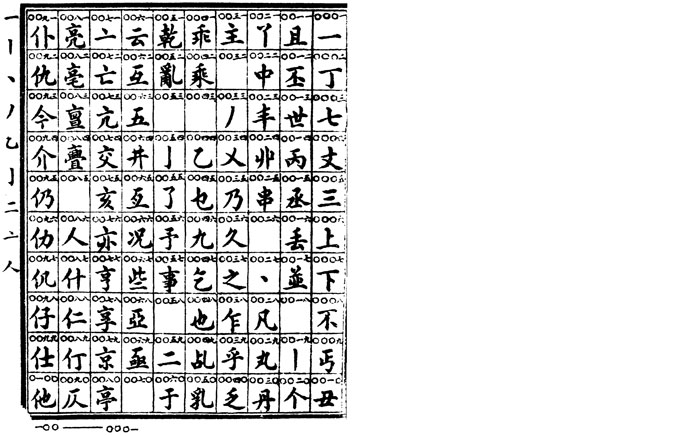
⬆
ex Jiao tong bi xi (1910), first page of telegraphic code.
Shown above is the first page of the character code. First character is 0001, followed down the first column by 0002, 0003, 0004, etc.; moving from left to right, second column: 0011, 0012, 0013 and so on. The code ends at page 37, with character number 9651.
Radicals appear in the outer margins. Shown below are the second and third pages of the code.
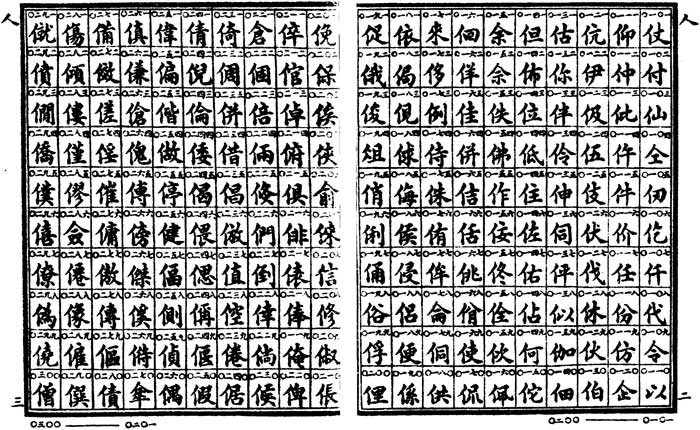
⬆
ex Jiao tong bi xi (1910), pages 125-24 (rearranged for this presentation), being the second and third pages of the character code.
This particular copy bears the owner’s signature at p161 : “Yamada Junzaburo, Shanghai;” there is also a handwritten kana code at p159, shown below.
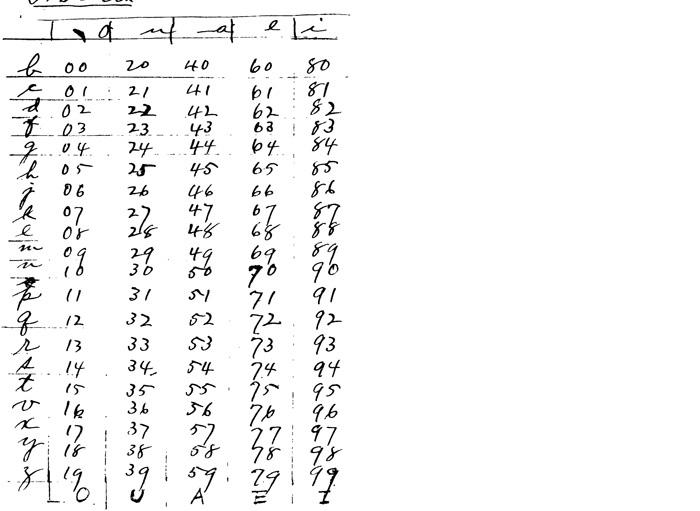
⬆
handwritten kana (Japanese) code at p159, Jiao tong bi xi (1910).
| 1911
Private Telegraphic Code. NYPL copy/scan (via google books) : link |
Sections (roman numerals in original) :
- Structural Shapes, Plates, etc. 1-18;
- Bars, Small Shapes, Hoops, etc, 19-64;
- Axles, Miscellaneous Forgings and Wheels, 65-72;
- Semi-Finished Steel, etc, 73-77;
- Steel Rails and Accessories, 79-111;
- Frogs, Switches and Special Track Work, 113-130;
- Rail Bonds, 131 to 145;
- Bridges and Structural Steel Work of Buildings, 147-202;
- Sheet and Tin Mill Products, 203-243;
- Tubular Products, 245-311;
- Pipe Fittings, Valves, Cocks, etc, 313-422;
- Wire Products, 423-568;
- Horse and Mule Shoes and Calks, 569-576;
- Coal, Coke and Pig Iron, 577-584;
- Shipment, Freight and Transportation, 585-680;
- General [phrase] Section, 681-948;
- Index, to Products, Materials and Erection Plant, 949-981
5L throughout, following the two-letter difference rule, and, it is claimed in Preface, no code word can be converted into any other “in this code or its supplements,” if two consecutive letters are reversed. Each of the first 15 sections is mostly tables, supplemented by phrases pertinent to those sections’s respective topic.
| 1911
Everybody’s Pocket Code. W. M. Saunders, comp. “for Merchants, Bankers, Brokers, and all Business Houses and especially adapted for the use of Railway and Steamship Passengers, Travellers, Tourists and to the needs of all Private Individuals who may require to Telegraph or Cable; Providing no less than 400 Million Phrases, for One Complete Cipher Word each.” [3], iv–xxiv; 1-551 Duke University scan, from a private collection (via archive.org) : link |
The code consists of phrases and some tables, utilizing 5L “half words.”
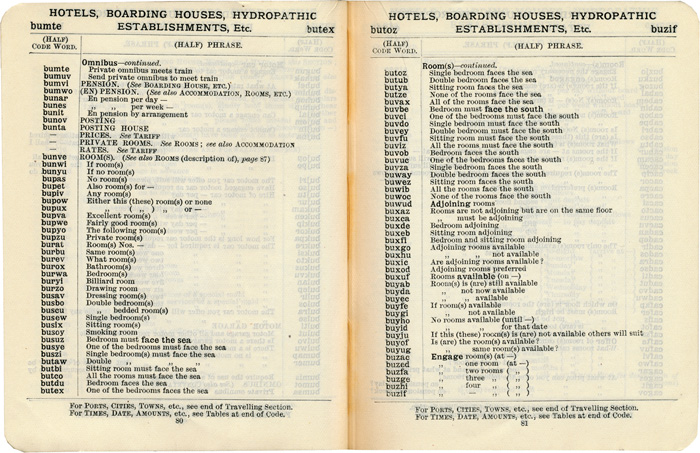
⬆
pp 80-81, Everybody’s Pocket Code (1911), private collection
Everybody’s Pocket Code begins with four sections devoted to use and/or communities of practice : (1) Travelling (1-49); (2) Hotel (51-91); (3) Shipping and Forwarding (93-126); and (4) Banking and Financial (129-200). These are followed by General 205-508; Tables 511-546 (Dates, Measurements, Numerals and Fractions, Percentages, Price (Sterling), Price (Decimal Currency), Time of Day, Weights (Ozs., Lbs., Cwts., Tons); and an Index to Advertisers (547-548). Advertising is located in front and back pages, and within the first four sections, a appropriate. Firm names are included in tables of, for example, cable addresses of steamship companies and banks.
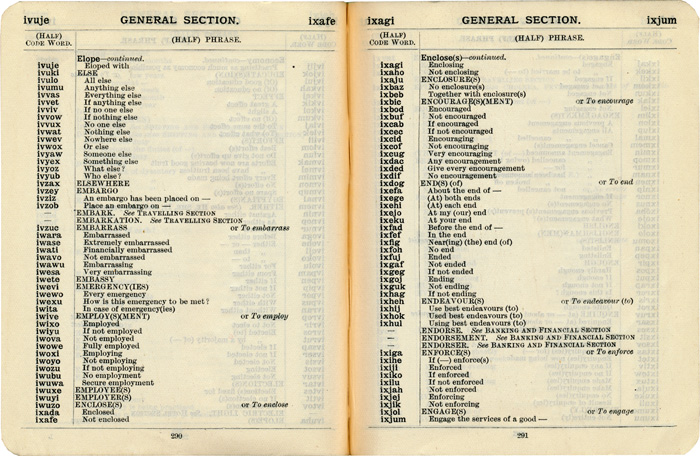
⬆
pp 290-291, Everybody’s Pocket Code (1911), private collection
The preface devotes several paragraphs to the use of so-called “Half Code Words of five letters each,” these enabling two artificial 5L words to be combined to fall within the 10L limitation on artificial code words. The General Section of the code provides numerous auxiliaries, that in combination with a “further half-word for a principal verb, will provide every variety of Person, Number, Mood, and Tense.”
| 1911
General information cable code / Llave telegrafica para informes generales. pages 9-12 in The shipping clerks’, correspondents’ and travellers’ handbook of Spanish invoicing, insurance, book-keeping, legal and technical terms, with Spanish powers of attorney, cable inquiry code 64 pages. Internet Archive, U.C. Berkeley copy : link Open Library indicates a second edition, revised, in 1921 (still 64 pages). |
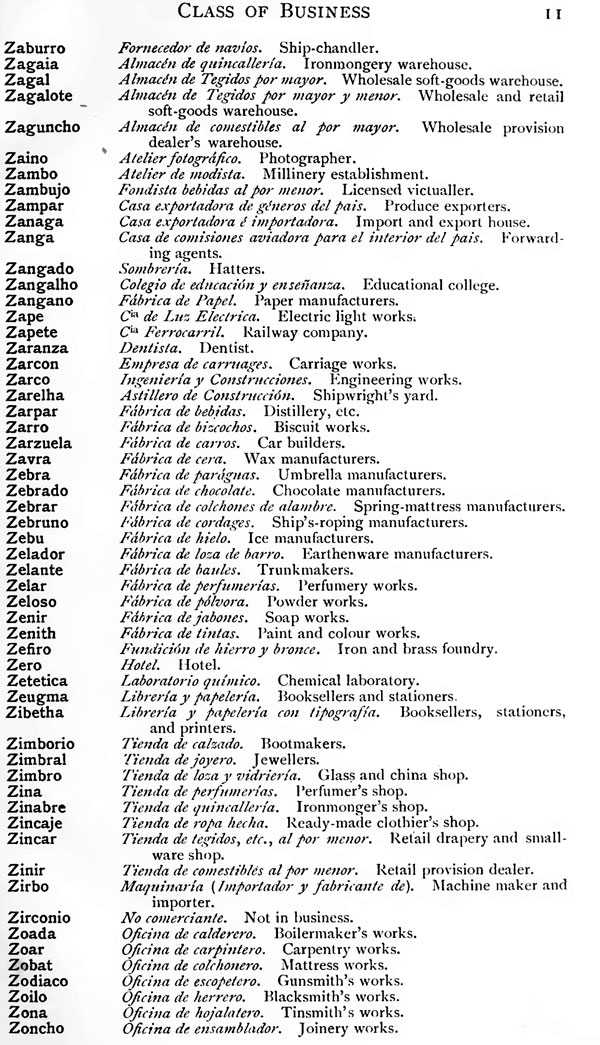
⬆
detail, p11, The shipping clerks’, correspondents’ and travellers’ handbook of Spanish invoicing (1911)
| 1912
The Emigre (P.C.) Cable Code. University of Toronto copy/scan : link description : |
ex preface —
“The ordinary telegraphic Codes are designed mainly for commercial purposes, and we have repeatedly, in communicating with clients in regard to Privy Council appeals and other legal matters, elt the want of a code containing legal phrases. For the convenience of our correspondents and ourselves... An amateur work is likely to be very imperfect, and we shall be grateful to any correspondents who may assist us with suggestions for insertion in a second edition.”
| 1912
Hartfield’s New “Wall street” (Newallst) Code.. Contains 156,563 cypher words numbered from 00000 to 156562. Also root and terminals forming millions of artificial words, conforming to the telegraphic regulations. (See preface.) Specially arranged for general banking in cable and telegraphic transfers; collections; commercial credits; discounts; exchange; letters of credit; loans; and financial transactions in bonds and stocks including arbitrage tables. Compiled by John W. Hartfield. 1912 Hartfield telegraphic code publishing co., New York.>br /> 2 p.l., iii [1], xvi, 2525 p. 22 cm x 15 cm. (from Reeds; I have not examined physical copy of this book). University of Chicago copy, poor scan |
Five and six figures, also codewords, roots and terminals. Preceding title page is a condenser, being “Hartfield’s 12-Figure Code / Allowing the transmission of 2 numbers, not exceeding 229,999 each, in one pronounceable Ten-letter word, inclusive of a check.” The scan does not capture all of the condenser, which begins here. Codewords appear to be “official” (Berne) vocabulary, or pronounceable in one of the eight European languages. Quite a bit of the preface is devoted to such regulations, suggesting uneasiness and/or tentativeness about the acceptableness of codewords. (Mention is made of the 5L count by United States carriers, for instance.) Roots and terminals are each 5L; presumably, the figure code and condenser could be depended upon to generate acceptable codewords.
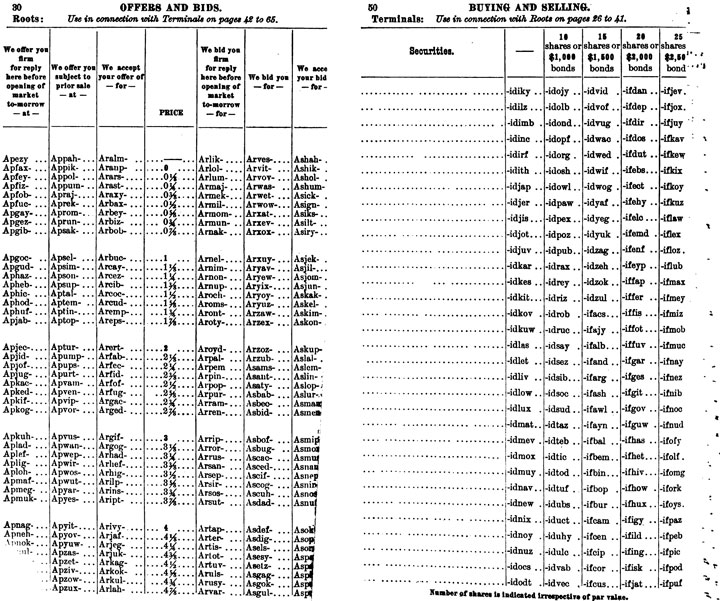
Roots and terminals, here pages 30 and 50 to be used in conjunction, Hartfield’s New “Wall street” (Newallst) Code (1912); image cropped, rearranged (from poor scan).
An index to Roots and Terminals (here) precedes the index proper.
Phrases extend through 106408 “Zitende / Yourselves and &mdash,” followed by several pages of spare figure/codewords ending at page 1815 with 106799 “Zoologisch / In future for this security use the code word —.”
The main phrase vocabulary is punctuated by conventional tables, e.g., “If” at pp758-65, “Offers” at pp1106-07, “Options – commodity orders and reports” at pp1146-47, “That – This” at pp1678-81 and “Think” pp1686-95 (which is followed by six additional pages — non-tabular ‐ of “think” phrases).
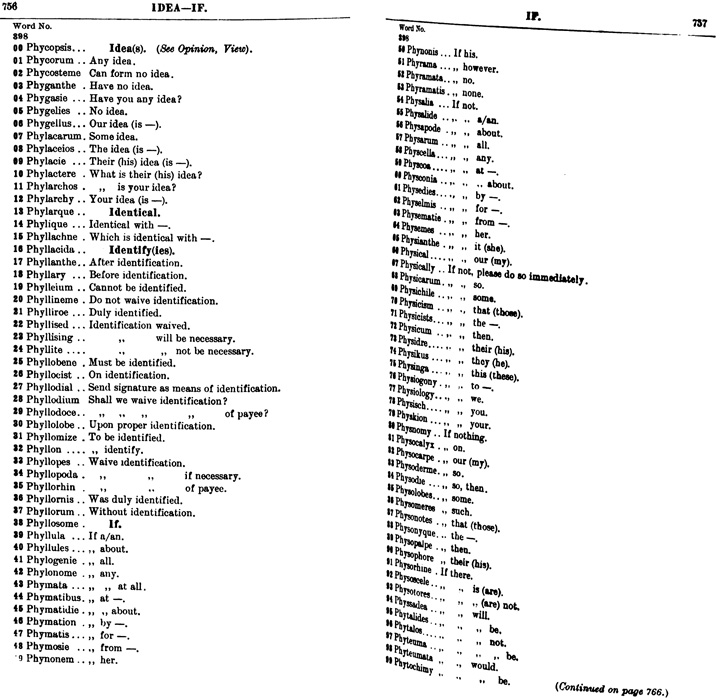
pages 756-57, Hartfield’s New “Wall street” (Newallst) Code (1912); cropped, rearranged (from poor scan).
Note:
The “if” phrases on page 757 are followed by eight pages of “if” tables.
The remainder of the book (some 710) is in the following sections:
securities (and names), commencing with at p1818 with railroad bonds (through p1912, followed by several pages of spare figure/codewords),
miscellaneous bonds (p1920 through p2061, followed by spares),
foreign railroads – stocks and bonds (p2070 through p2087, followed by spares),
government securities (p2092 through p2126, followed by spares),
railroad stocks (p2131 through p2142, followed by spares),
miscellaneous stocks (p2148 through p2206, followed by spares — several of which are taken on p2207 and following pages),
exchanges – stock, etc., (p2214 only, followed by spares),
companies (p2216 through p2222, followed by spares),
officials (p2224 through p2238, followed by spares),
names – banks with branches (p2240 through p2246, followed by spares),
names (banks etc., arranged by city, p2248 through p2428, followed by spares),
single words (p2437 through p2522), and
combinations for sending names (p2523 through p2525).
This 1912 edition “contains all of the data in” but could not be used in conjunction with its (1905) predecessor, Hartfield’s “Wall street” code. Contains about 467,000 cypher words, all conforming to the telegraphic convention regulations. New York: Hartfield telegraphic code publishing co. [c1905] (ix, 685p). The reason being its much larger scale. The earlier code also had root-and-terminal sections, and names of bonds, etc.
| 1913
Bauers code; der neue deutsche telegramm-schlüssel. U Minnesota copy, HE7678.B3 via hathitrust : link Leipzig, C. E. Poeschel, 1913 Vorwort p iii; instructions for use, v-vi; index (Inhaltsverzeichnis) pp vi-xxi, and code pp 1-1040. 8-L codewords with figures: 00001 abababal / Abändern through 177913 osefizit / blank. Some tables. |
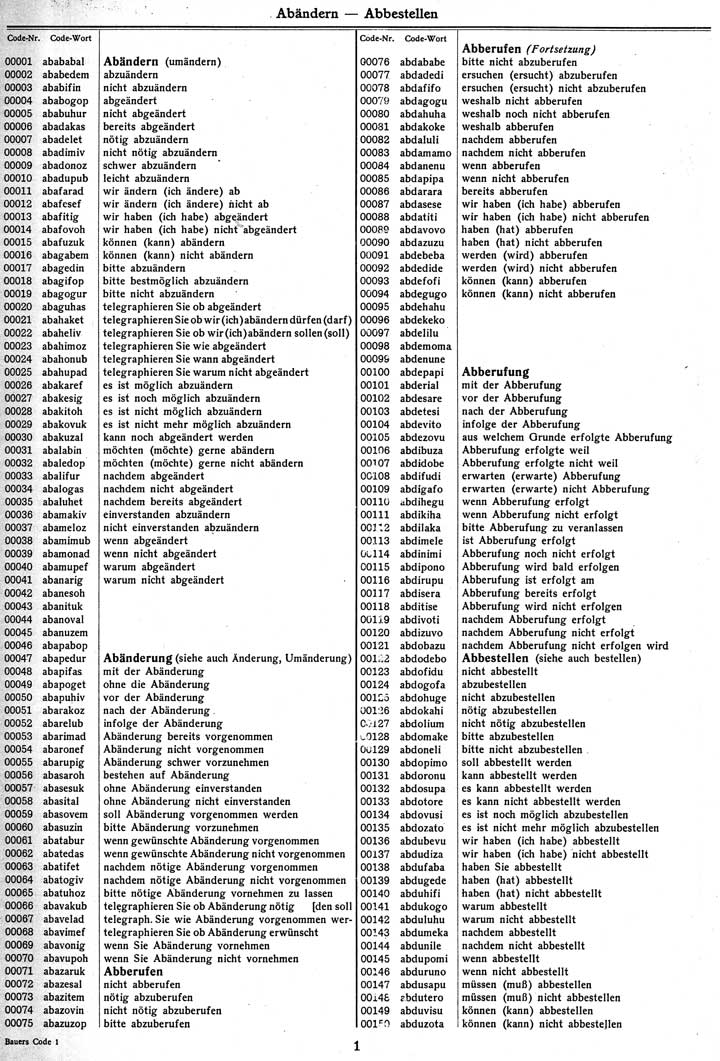
⬆
detail, page 1, Bauers code; der neue deutsche telegramm-schlüssel (1913); from my photocopy of LC copy.
This is a personal favorite code, for its dadaistic codewords, and also for phrase ranges that are unusual in such a code, e.g., 89285 hekuzula / Philosophisch, etc.
| 1913
Telegraph and Cable Code.. U Michigan copy/scan TS 273.T98 (via google books): link 5-L |
“There is a code word shown for each number of Ton-Cap screen in the following tables, also code words for specifying the number of pieces, dimensions of each piece, also whether brass, steel, copper, bronze or phosphor bronze is required. If no metal is mentioned, steel will be furnished...”
“Ton-Cap” is short for tonnage capacity : increased throughput afforded by the company’s superior screen design (oblong, rather than “round hole screen producing the same sizing” (p 16). The catalogue itself is nicely designed and illustrated.
| 1913
The Imperial Combination Code : Rubber Edition.. Compiled by Edward Barron Broomhall, author of “Broomhall’s Comprehensive Cipher Code,” “The Standard Shipping Code,” “The Arbitrage Code” and of eighty-nine distinct private telegraphic codes constructed for the principal British and foreign banks, companies and firms. copy/scan source(s) : link London: E. B. Broomhall, 30, Walbrook, London, E.G.4, England (4), 1-241, (1), 1-28
|
Note on (unnumbered page vi) reads (in red) : “Pages 131 to 178, both inclusive, in this Edition differ from the same pages in the Imperial Combination Code.” The preface to the Rubber Edition explains that a number of mining phrases were eliminated to make way for phrases “particularly applicable” to rubber. The “Rubber Section” runs from page 160 through 172; it includes, in addition to rubber, some phrases about “various articles of produce cultivated with Rubber,” like cinchona, cocoa, cocoanuts, coffee, pepper, sago, tapioca, tea, etc.
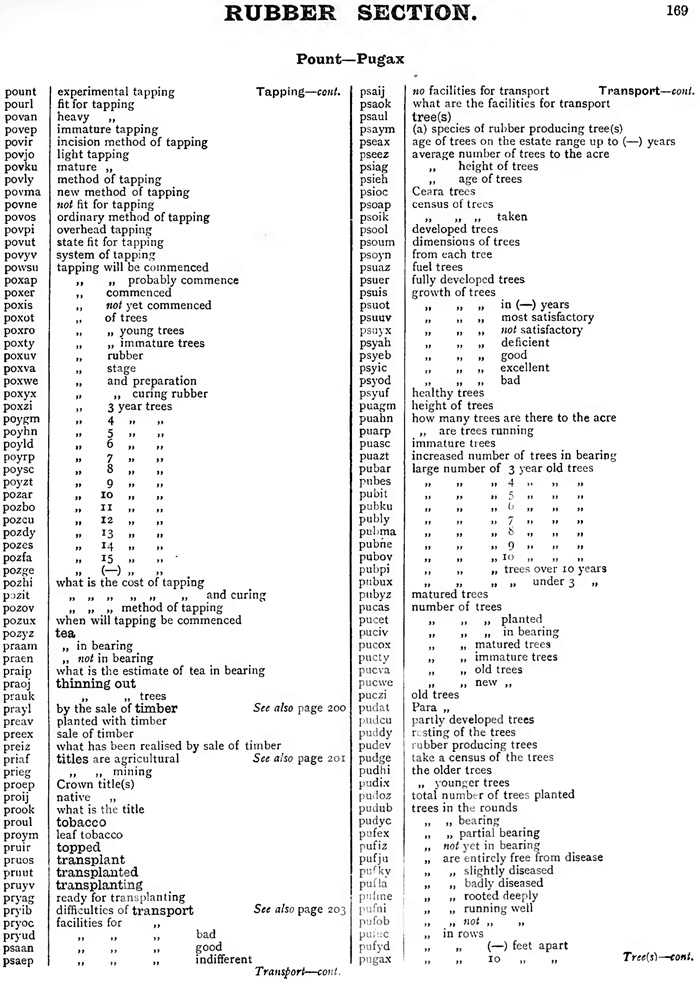
⬆
p169, The Imperial Combination Code, Rubber Edition (1913)
Mainly phrases (excepting tabular presentation for “Dates, Deliveries, Shipments, &c.” pp 240-241.). Provides plenty of auxiliary phrases.
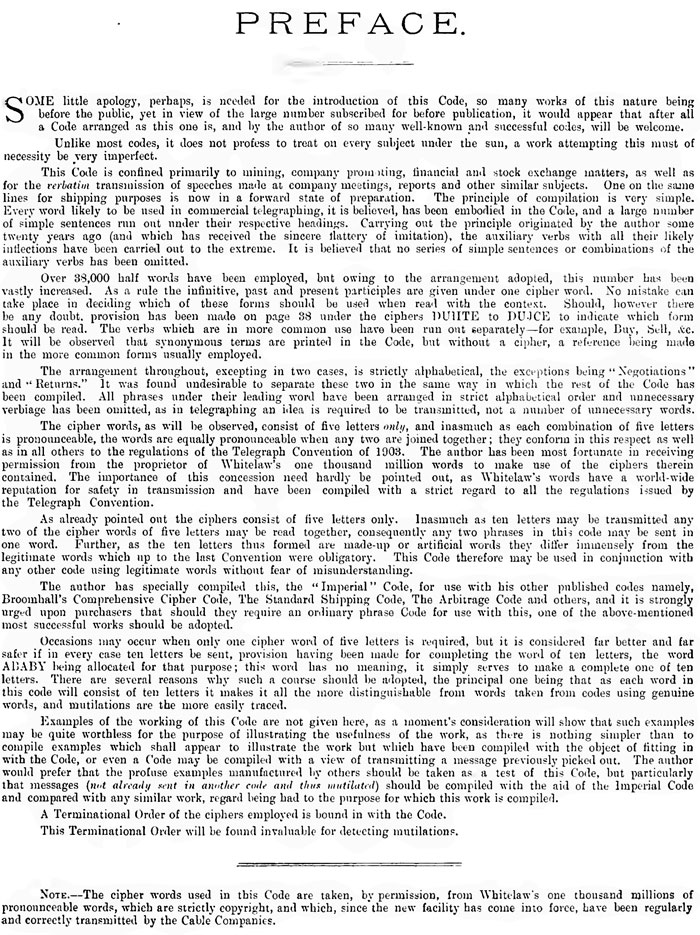
⬆
(general) preface, The Imperial Combination Code, Rubber Edition (1913)
By “Combination” is meant the provision of auxiliary verbs that, in combination with main verbs, allows the verbatim transmission of speeches and the like; ordinarily, it is only an idea that is required to be transmitted, not a number of unnecessary words (to borrow expressions from the general preface).
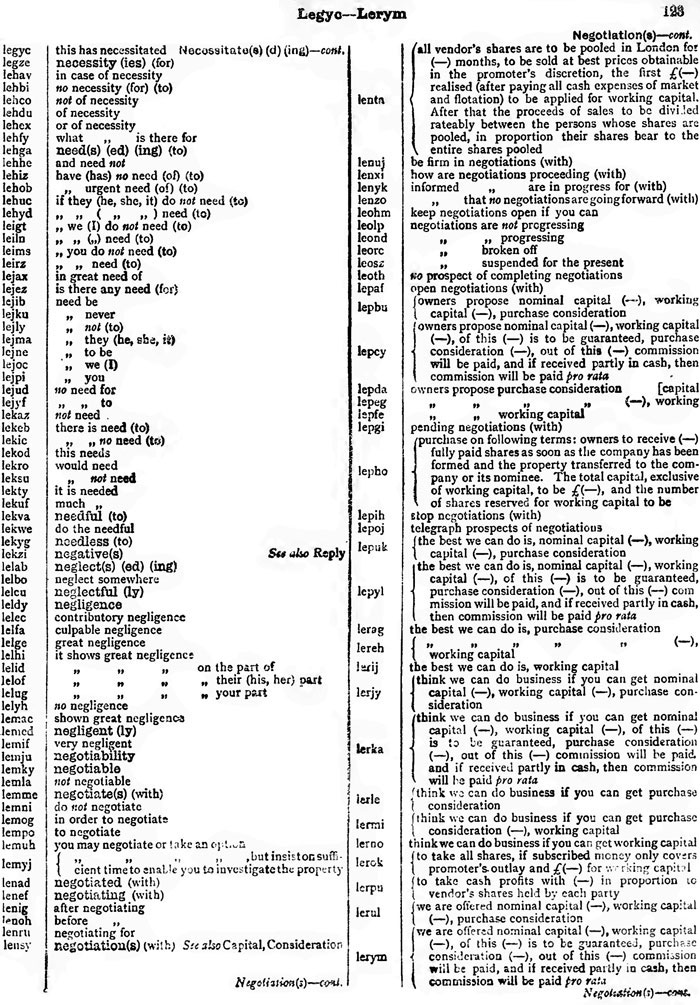
⬆
p123, showing full portmanteau (multi-faceted) expressions under the head “Negotiations,” The Imperial Combination Code, Rubber Edition (1913)
The page shown above shows both auxiliary-like phrases involving “need,” and phrases under the topic “Negotiations” involving their conventional elaborations.
A genealogical website devoted to the Broomhall Family (now via the waybackmachine) yields this, in addition to information about marriages and children : “EDWARD BARRON BROOMHALL... was born 8 January 1848, in Madras, India; d, 2 October 1929, at Bromley in Kent, England.”
link
| 1914
The Private Code and Post-Card Cypher. Compiled by Constance and Burges Johnson. New York and London: G.P. Putnam’s Sons, The Knickerbocker Press, 1914 dedicated to “THEODORE N. VAIL / whose kindly hospitality is requited by the publication of this method of beating his company” NYPL copy/scan, via google books : link 88 pages more a novelty/fun read, than a functioning code. |
Topics
- Bulletins en route
- Intimate Messages —
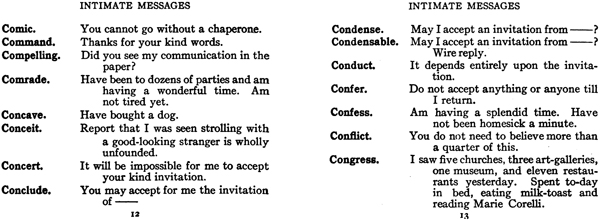
- Things Needed or Forgotten
- Arrival at Destination
- Accommodations
- Letters and Telegrams
- Baggage
- Home News
- Sickness and Health
- Money Matters
- Commissions and Messages to Others
- The Return
- Concerning Food
- Appointments
- Model Letters between Husbands and Wives The Telegram Game : link
The book is prefaced by an “Apology” —
“No literary critic has ever paid sufficient attention to the effect of the ten-word telegram upon American style. Yet undoubtedly the old problem of how to say what must be said within a ten-word limit has had a powerful effect upon prevailing terseness of expression. The fact that eleven words would cost but a cent or two more has made little difference. Ten words it must be. And if the message has used but four words, then six more must be found, at whatever cost of mental effort. A generation ago the Peterkins faced that very problem, and when their four words had been written, added — ‘The house is not on fire.’”
“This code will aid the perplexed or homesick absent one to put many essential messages into the ten-word announcement of his safe arrival; and it will enable the abandoned one, after she has put her necessary inquiry into eight words, to find two more that will fill out the allowance most delightfully.”
“In addition to the use of this code in telegrams, its compilers suggest that the picture post-card, containing as it does an irritatingly small space for messages as well as an exposed one, is much in need of a private cypher.”
“It is proper to add that the telegraph companies do not encourgae the use of a code in connection with “night letters” and “day letters;” but the fifty-word allowance in those forms of telegram makes a code unnecessary.”
“The compilers admit that there are other codes in existence more complete than this in many particulars. For that very reason there is no attempt here to enter the field of business messages. In other ways, however, they maintain that this code has no parallel.”
“C. and B.J., Port Washington, N.Y.”
| 1917
The automobile telegraphic code Robert E. Pye, compiler LoC copy/scan, via archive.org : link 5L code |
Explanation of the code faces the examples shown below, and describes the arrangement of the code into three divisions :
- A general vocabulary of words and phrases, pages 1 to 372;
- Tables of numeras, bulk units, packages, quantities, stock numbers, grades, gauges, money, discounts and dimensions, and the calendar, pages 373 to 456;
- Car parts, car models and accessories, pages 457 to 834.
An unpaginated index (22 pages in total) follows page 834.
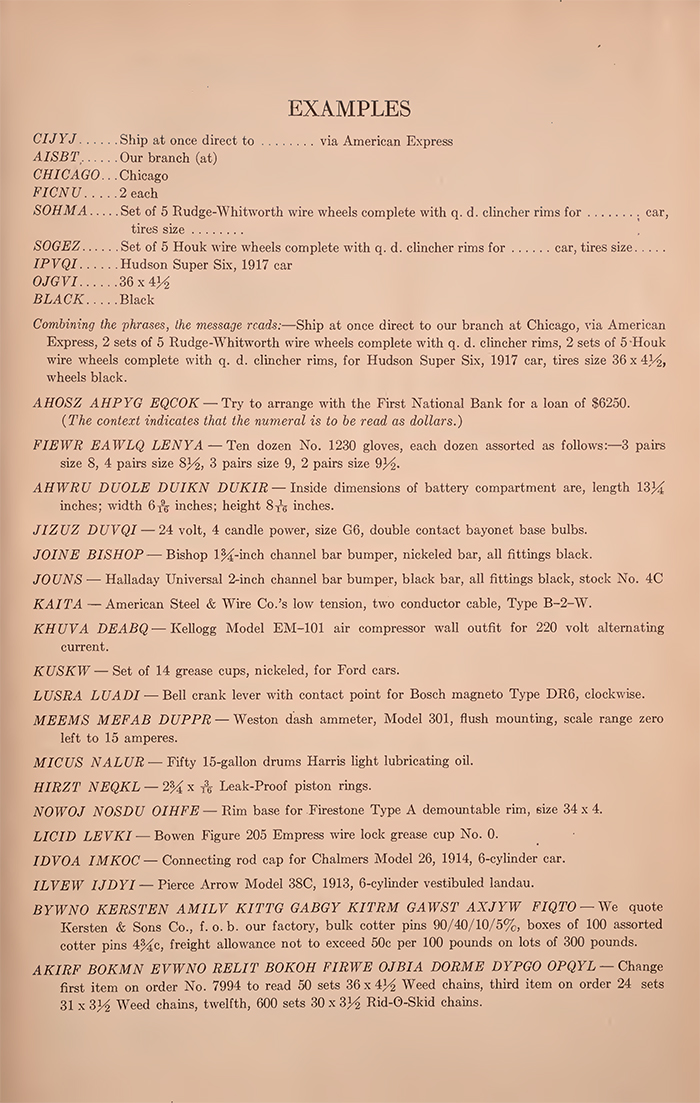
⬆
The automobile telegraphic code (1917)
The catalog nature of most of the code, with parts for specific makes/models of specific years (1915, 1916, etc) would doom this code to a short useful life.
| 1917
Keegan’s international code. Second Edition University of Washington copy/scan, via hathitrust : link more description |
The first two sections of Keegan’s 1917 code were devoted to standard cable phrases of a commercial, shipping and other matter; A third special “Lumber Supplement,” requiring its own indicator (LUM) was devoted to the lumber trade, and was heavy on tables and specifications (with a more narrowly focussed range of phrases).
A three-letter code employing only “safe” letter combinations, yielding fewer than 7,000 3-letter groups. Essentially the same 3-letter groups are used in three different sections of the code : 6,146, 6,396 and 4,348 respectively (yielding 16,890 total codewords with their respective phrase or tabular meanings, including various blanks to be filled in by the user). This is accomplished by means of “indicators” (81 in total), that would be used at the start of each cable, indicating from which of the two sections in the code the subsequent 3-letter groups were to be found, from one to a maximum of nine entries. For longer coded messages, a new indicator would be brought in, as required.
Keegan compiled three codes under her own name :
Keegan’s International Code. Specially adapted for the use of shipowners, shipbrokers, etc., 163 pages (Seattle, 1913)
Keegan’s International Code. Second edition (Seattle, 1917); and
Keegan’s International Three Letter Code. Third edition. xxxii, 547 pages (Seattle 1920)
![]()
Keegan Cable Code Saves One-Third
American Lumberman (March 13, 1920) : 73 : link
photo of Keegan, captioned: Margaret W. Keegan. Seattle Girl Who Has Invented Wonderful New Code.
Seattle, Wash., March 8.—The wonderful new cable code invented by a Seattle girl, has created a nationwide sensation among exporters, importers, bankers and all who use the cables for commercial purposes, because of the great saving effected by its use, amounting to as much as one-third of the entire cable tolls. The inventor is Miss Magaret W. Keegan, coding clerk for Frank Waterhouse & Co., of this city. Miss Keegan worked for seven years perfected the system, which has been published under the title of “Keegan’s International Three-Letter Code,” or, more briefly “Keegan’s Code.” The best codes in use heretofore have been based upon the five-letter system; that is, five letters are required to express one commercial phrase. As all cable companies operating from American shores have a uniform regulation providing that a cable word shall consist of not more than ten letters, it will be seen that only two cable cyphers, or two combinations of coded phrases of five letters each, can be embodied in one cable word. With the Keegan code it is possible not only to combine three distinct cyphers, or three separate commercial phrases, in one cable word, but a tenth letter is allowed, which is cleverly used by the inventor of the new system as a check letter. This feature, which is unique with the Keegan system, tells the decoder instantly whether the message has been accurately sent or whether it has been garbled in transmission. Experts declare that this feature, tho incidental, is of the greatest value, and is not duplicated in any other code. To illustrate its extreme power of condensation, the following message: “Quote us delivered here 700,000 feet 10 x 14 merchantable rough Douglas fir in random lengths from 25 to 50 feet" would be transmitted by the single word “Waznudgozt” in the Keegan code. ¶ [ The American Lumberman has just concluded arrangements to supply the lumber trade with the Keegan Code and will accept orders for it.—Editors. ]
aside —
The above entry on the second of Margaret Keegan’s three codes, will eventually be moved to a separate page devoted entirely to 3-letter codes.
| 1918
The “Colorado” Code. “Digitizing sponsor” : Duke University Libraries also on title page : “Secret / Must not fall into hands of enemy. / No. 2 / Memorize this group: “DAM---Code Lost.””
Front matter and folios are typeset, code vocabularies are completely typewritten. 47pp, 20cm |
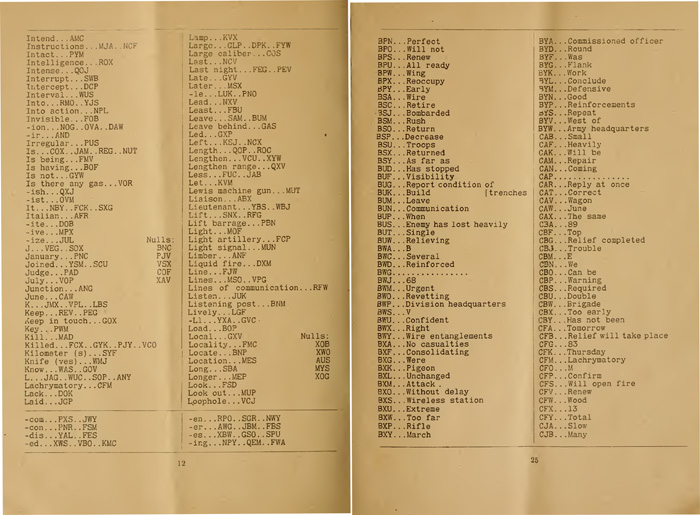
⬆
pages 12, 25, both showing entry for CFM / Lachrymatory, ex The “Colorado” Code (1918), from Duke University scan of copy in private collection.
| 1920
The Nautical Telegraph Code and Postal Guide. Fourth edition, 1920 A full transcription was prepared and made available by Eveline Houweling (to whom thanks for this labor of love), but is no longer available — It is still accessible via the waybackmachine : link See her archived sitemap for some additional telegraph material. A “social” code, largely for mariners but for others in the colonies, as well. The code appears to have been published in 1907, 1908, 1920. My own copy is the fourth edition (Glasgow, James Brown & Son), but contains a notice on an appendix page dated 1925. |
Contents (of my own copy; two specimen spreads)
- Letters and telegrams 3
- Sailings and Arrivals 23
- Meetings 45
- Weather 55
- Health 61
- Births 69
- Marriages 72
- Deaths 74
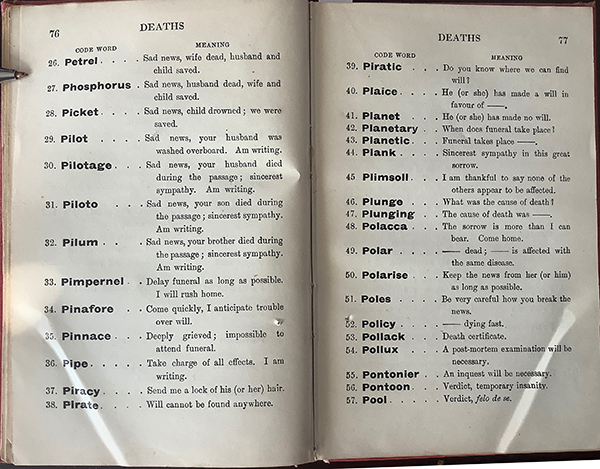
- Accidents to Ship 81
- Holidays and Amusements 89
- Money and Business 95
- Miscellaneous Sentences 115
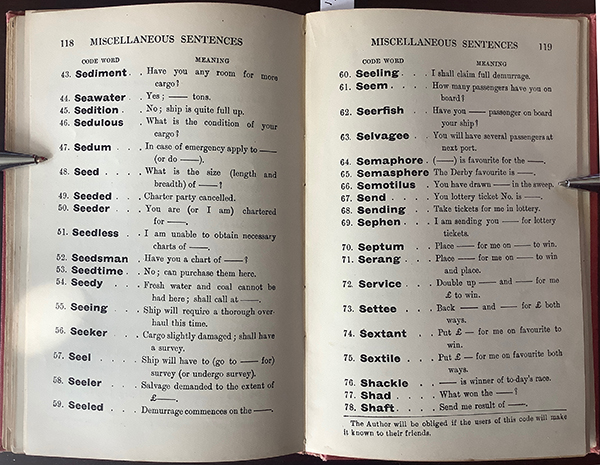
- Greetings and Congratulations 123
- Things to Be Sent Out 129
- Insurance, Legal Advice, &c. 139
- Additional Code Words 145
- Telegraphic Addresses 149
- Appendix 151
| 1921
The motor trade telegram code. W(illiam). M(oore). Saunders, comp. LoC copy/scan (via google books) : LC HE7677.A8S3 : link |
5-L (“halfword”) code, whose 558 pages consist of three parts:
- Phrases, Supplemented by blanks for private additions 1-512
punctuated by some in-line tables;
- Tables
Dates 514-517
Decimals 517-519
Horse-power 520
References to letters and telegrams 521
Measurements 522-523
Numerals and fractions 524-529
Quantities 530-533
Sterling 534-541
Time 542
Weights 543-545
- References (=indicators) to catalogues, lists, etc., through the use of the Code Numbers 548-555
References to invoice nos., order nos., or any other item of information that can be iidentified by a number 556-558
![]()
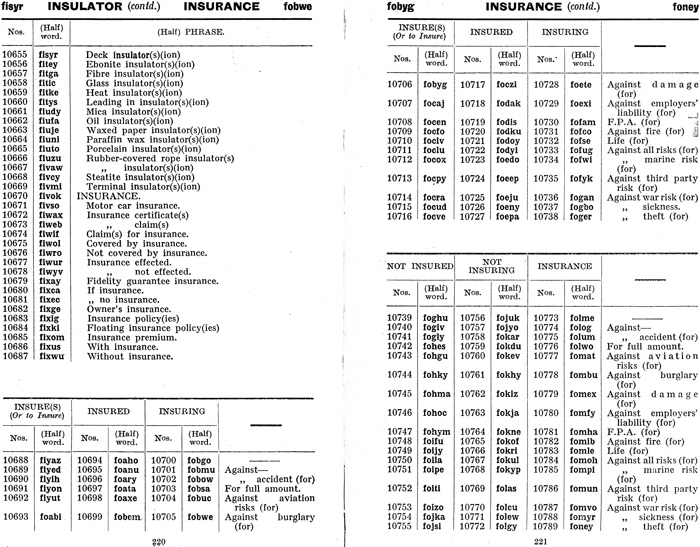
⬆
pp 220-221 (cropped), showing phrases and inline tables, W. H. Saunders, compiler, The Motor Trade Telegram Code (1921), from photocopy of LC copy
Saunders was W(illiam) M(oore) Saunders, 1873-19?.
| 1921
Bensinger’s Special Edition of Complete Phrase Code. 1921 Reprint of First Edition NYPL copy/scan (via google books) : link |
Nowhere save for a librarian’s penciled mark does E. L. Bentley’s name appear in this version of his code. This is not a stereoplate reprint of first edition; pagination is different; 5-letter codewords are presented all caps.
at pp242-252 link —
One Million Cyphers (eight letters each with a 2-letter difference), for “transmitting any figures within the following range: 0/9, 00/99, 000/999, 0000/9999, 00000/99999, 000000/999999”.
This feature, which drops out in (some?) later printings of Bentley — presumably with the nigh universal adoption of 5L codes — enables users to generate messages from both “vocabulary” and figure codes. The numbers standing against the sentences in such Codes are converted into these Cyphers instead of using the Code words in those Codes, thus preventing any possibility of confusion arising from mixing such sentences with “Bentley’s Complete Phrase Code.” A 1st series provides cyphers abev through zuof, for figures 0-999; these “half ciphers” are to be combined to form 8L ciphers; a 2nd series runs zuker through zyzwo (0-210), with higher numbers to be taken from 122-25); But ciphers from the two series are not to be combined. The second series cyphers are specifically intended to signify figures from separate figure codes, and work together with the 5L ciphers from the rest of the Phrase Code.
Private supplement (= spare cyphers) WUVNE-ZIZWO runs pp 253-301, followed by “Telegraph Cyphers in Terminational Order, for checking errors occurring in transmission of messages,” starting at page 307 (after some preliminary matter) and running for 40 pages (separate pagination).
| 1957
A.N.A.R.E. Code. original location archived at waybackmachine at link (November 2023) also at link The A.N.A.R.E. Code was used for private messages over radio-telegraphic link to Australia, perhaps commencing around 1957. The code was also known as “WYSSA,” for a reason that will become apparent from examples below — |
| WUVNE | Penguins have begun to arrive on the Island |
| WYSSA | All my (our) love darling |
| YIHMO | I have grown a beard but think I’ll shave it off before I get back to Australia |
| YIKLA | This is the life |
| YIVUC | Days are short in the antarctic at present, the sun appering above the horizon for no more than three hours |
| YITIX | Time seems to be only thing we're short of |
| YITOZ | Very busy preparing gear for spring work including training dogs |
| YITUB | I am not sure whether men training dogs or dogs training men |
| YOHNA | My message is contained in following quotation |
| YOHOR | See Oxford dictionary of quotations |
| YOHPE | See Oxford dictionary quotations indexed as beginning |
| YOHRO | See Shakespeare play: initials, act, scene, line follow |
| YOHTY | See Bible quotation: abbreviated name of book with chapter and verse follow |
| YOHUS | Have recently been reading these books |
| YOIKS | Thinking of you especially when reading following book and chapter (code word followed by name of book and number of chapter) |
| YOILT | Our Position is Latitude...deg...mins Longitude...deg...mins. (code word followed by one four figure group for degrees and minutes of latitude; then one five figure group — commencing with 0 if necessary — for longitude). |
An account of the use of the ANARE Code is included in a fascinating interview with Doug Twigg, an ANARE Radio Supervisor who spent several winters and summers in Antactica between 1956 and 1992. The whole (recorded on 23 February 1996) can be found here — now (April 2016) here — now (November 2023) at the wayback machine : link in a section entitled “Communications 1911-1985,” within the website of the Australian Antarctic Division. I include the relevant passage from that interview below (without permission, for now) to be sure it is not lost! The interviewer was Annie Rushton.
“Morse code was used before the advent of teleprinters. AAD photograph (4215-C6) And it was through using the teleprinter system that we developed the “WYSSA.” “WYSSA” is local ANARE jargon for a private telegram.
They were called that back in the Heard Island days, before we settled Mawson in 1954. However, “WYSSA’s” continued to be sent by teleprinters and then by satellite.”
“So did the first “WYSSAs” start using Morse Code?”
“Yes, initially, this was the only communications that the expeditioners had then, until the “radphone” came along, but they still continued sending ”WYSSAs.”
“They’d be cheaper, I guess.”
“Than the “radphone,” yes. Each expeditioner got so many free words a month, I think it was 175 free words a month. And if you exceeded that you paid about five cents a word. This allocation was divided up, the expeditioner could use 100 of those and his next-of-kin could use 75, that is how it was supposed to have been divided up. And then there was the code book, an adaptation of Bentleigh’s (sic) Telegraphic Codes. A code word would be a substitute for commonly used phrases or sentences. It was an economic means to reduce the number of words in a telegram, both for the expeditioner and for the radio operator who had to transmit it letter-by-letter by Morse Code. You could send a lot of words, a lot of conversation, by using about 10 code words, which would result in about half a page of letter when you decoded the “WYSSA.” Some of the cleverer expeditioners used to “doctor” the code a bit, they would develop their own private meanings to the code words with their next-of-kin. They might change the meaning for a code word about elephant seals or the sea ice, but in fact they were really talking with their own private code. You got to know many of the commonly used code words without having to look them up in the code book. It was used for many years.”
20150718 / 20231220